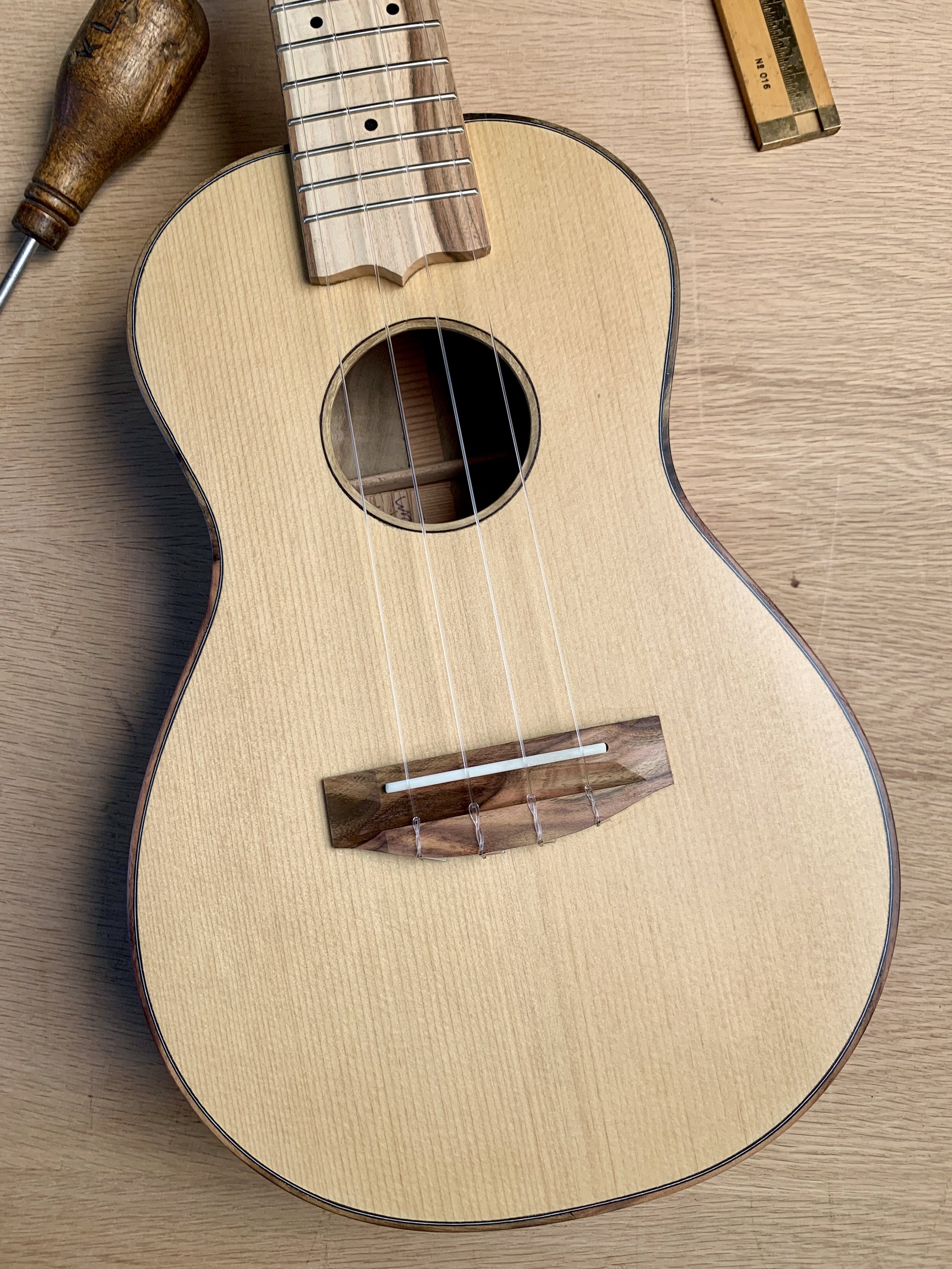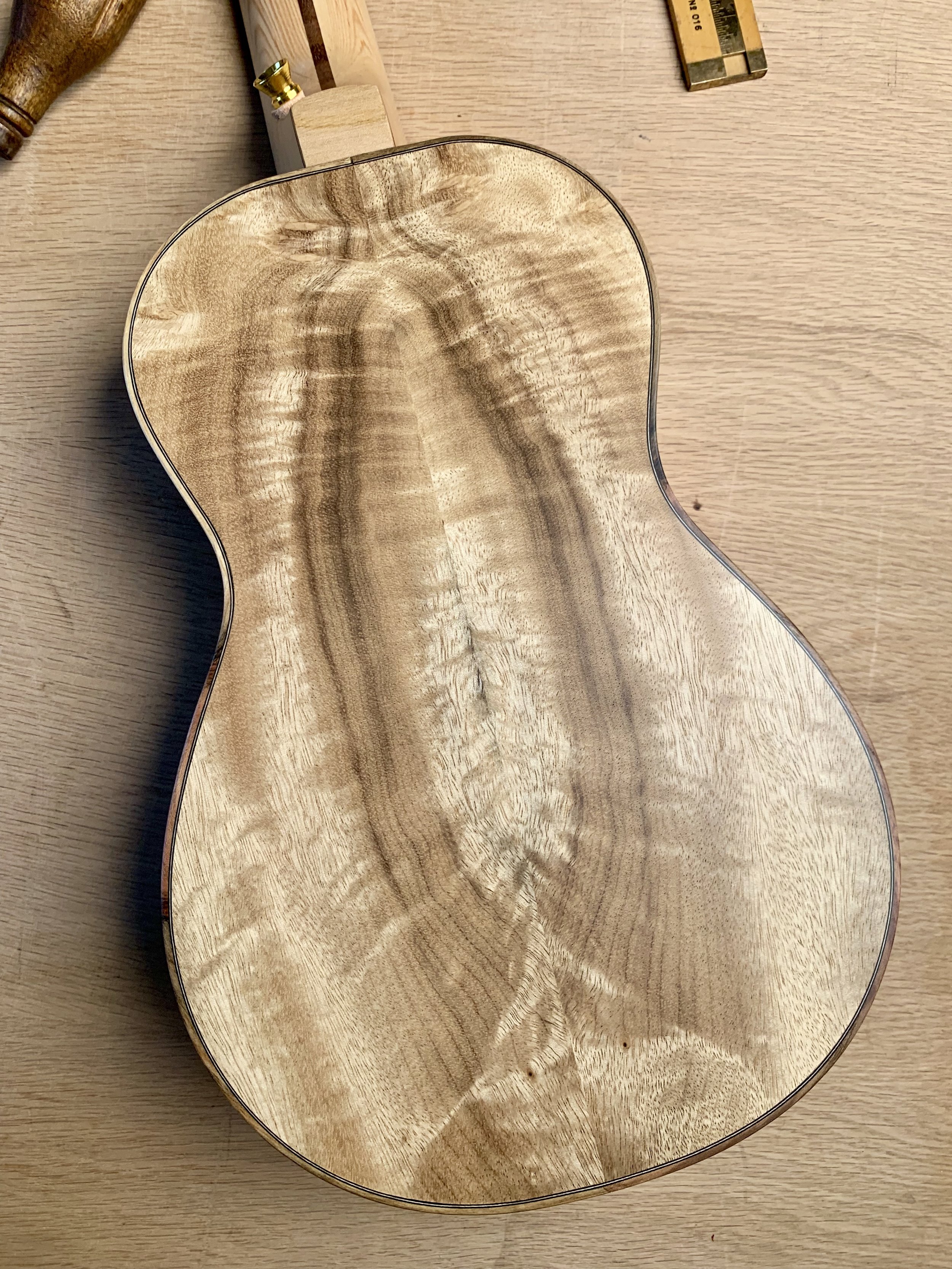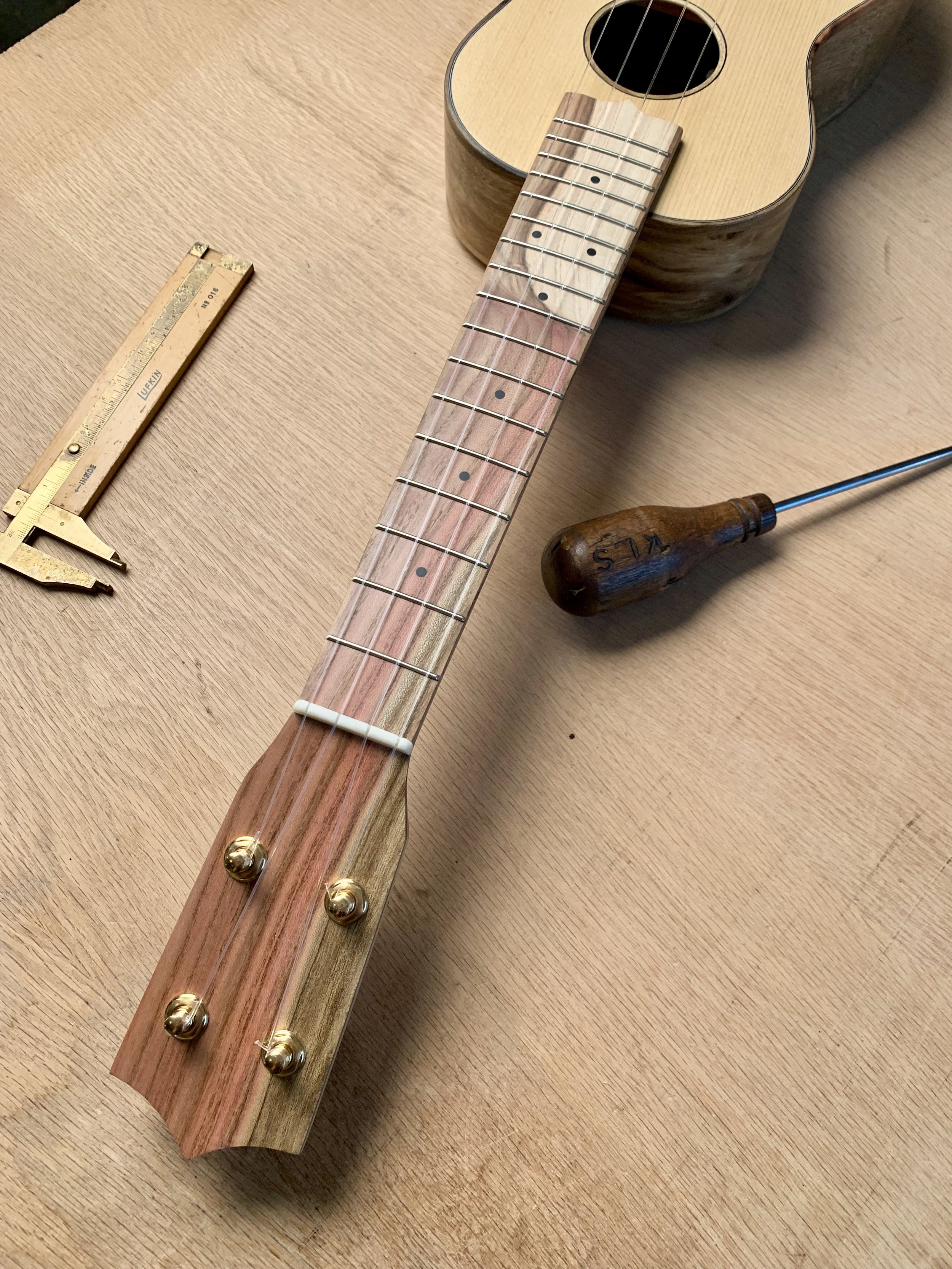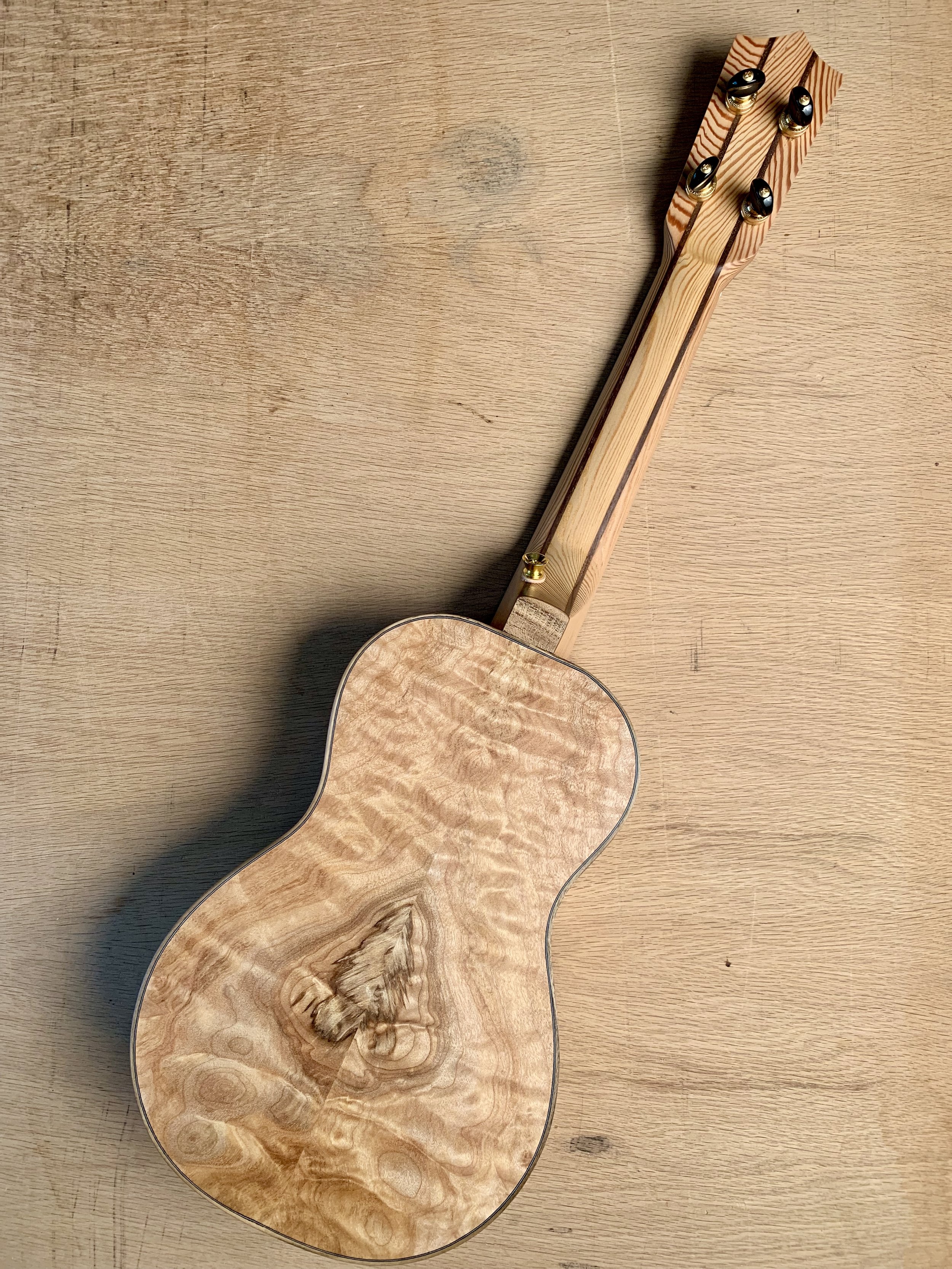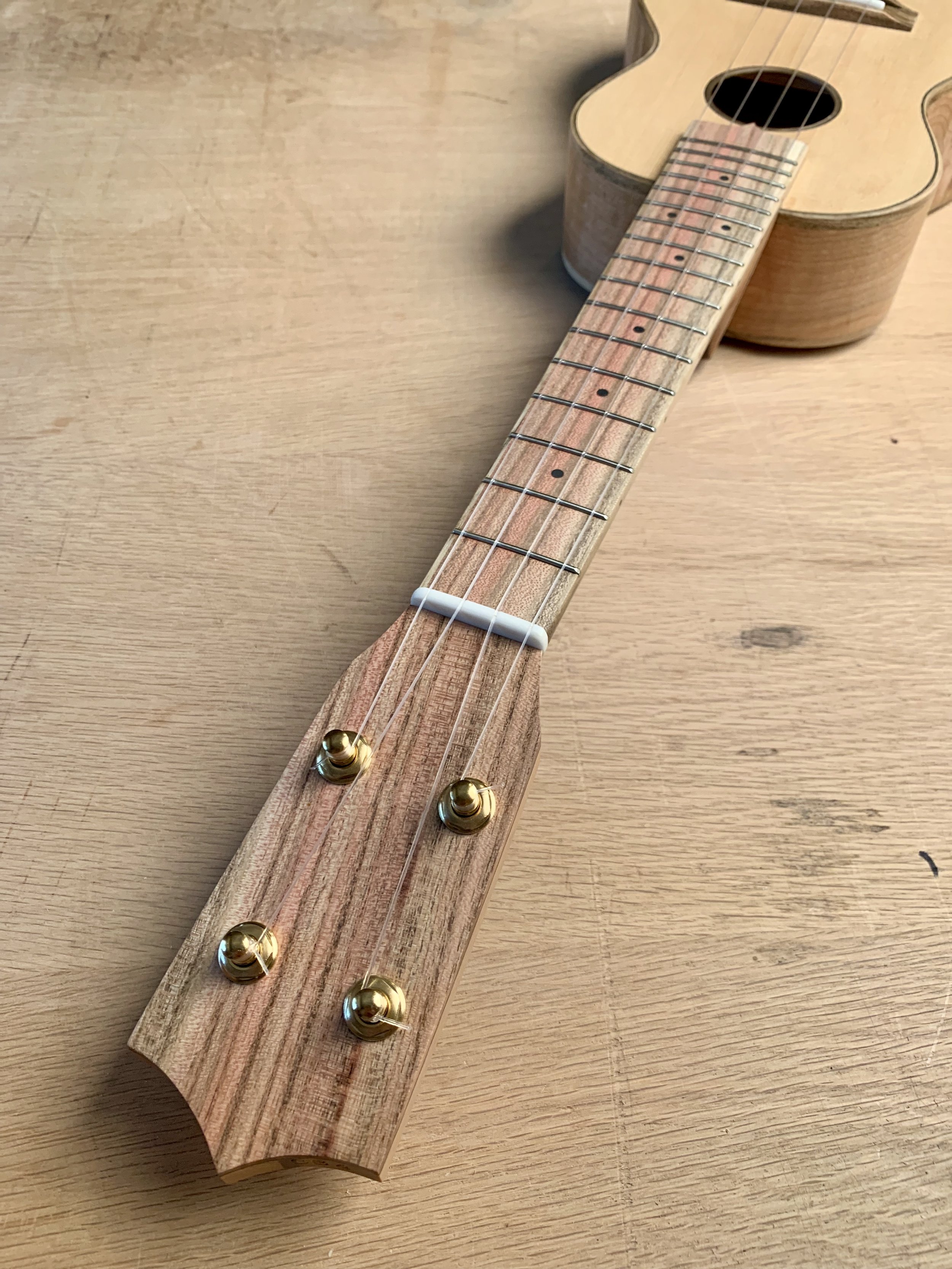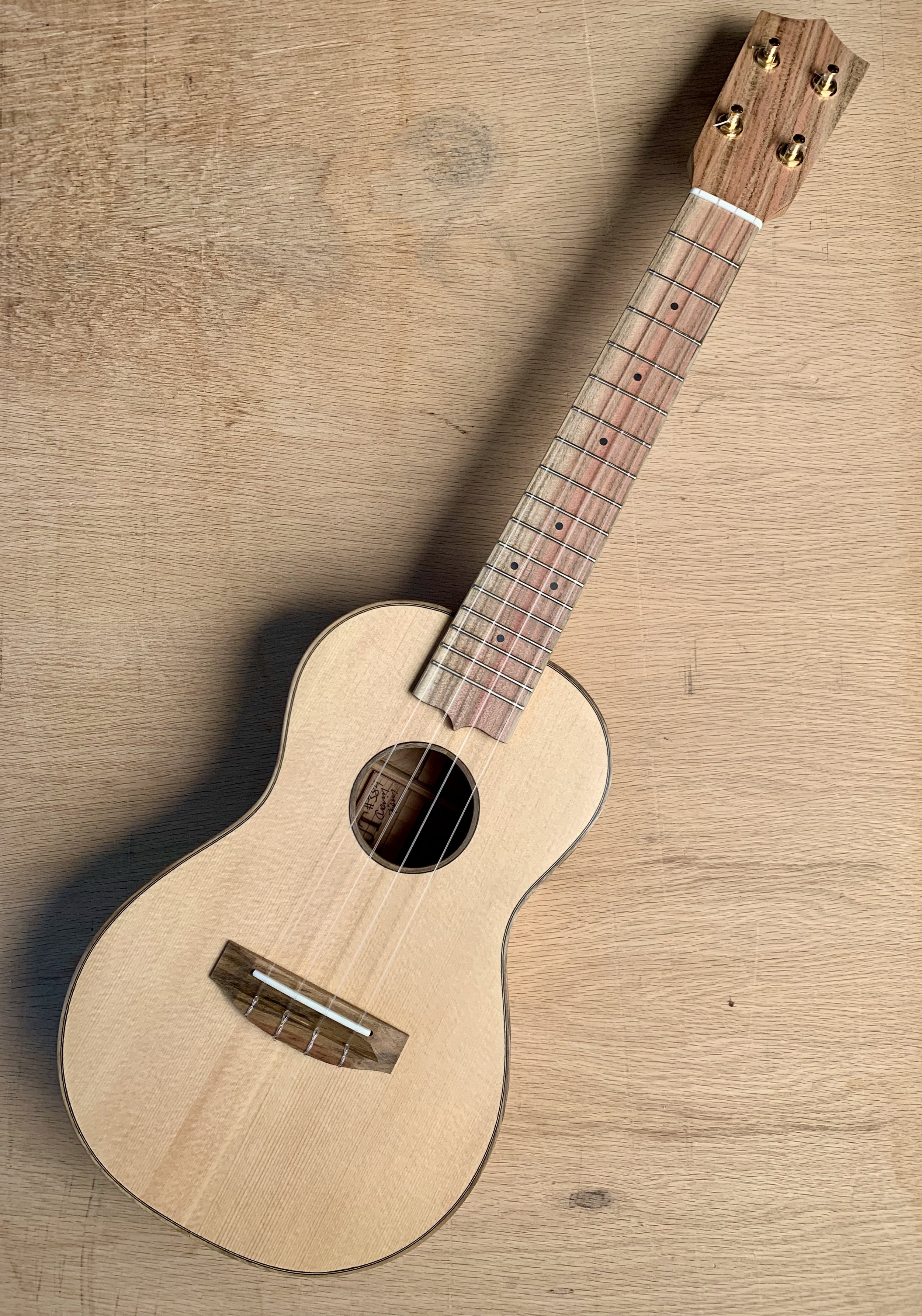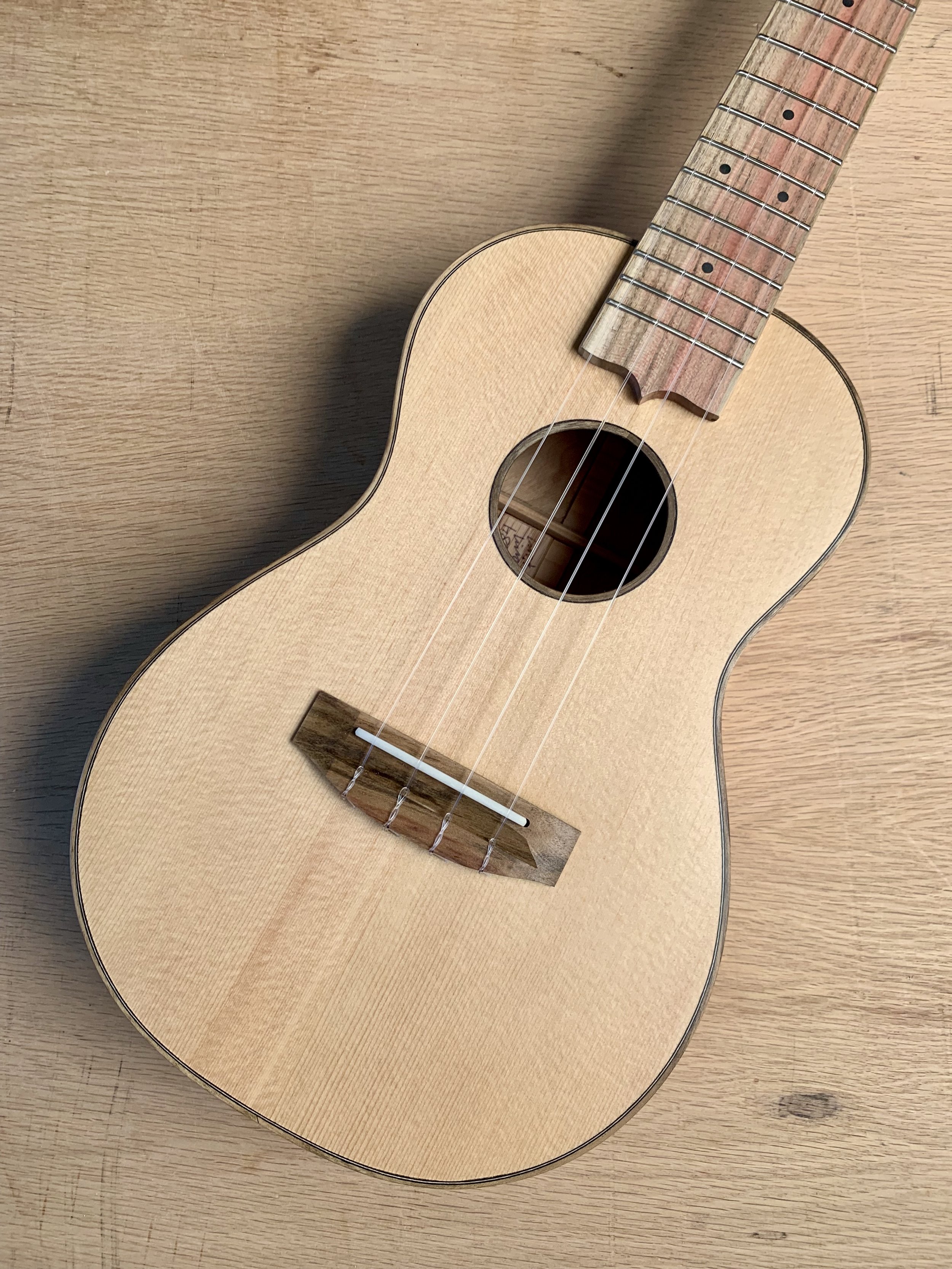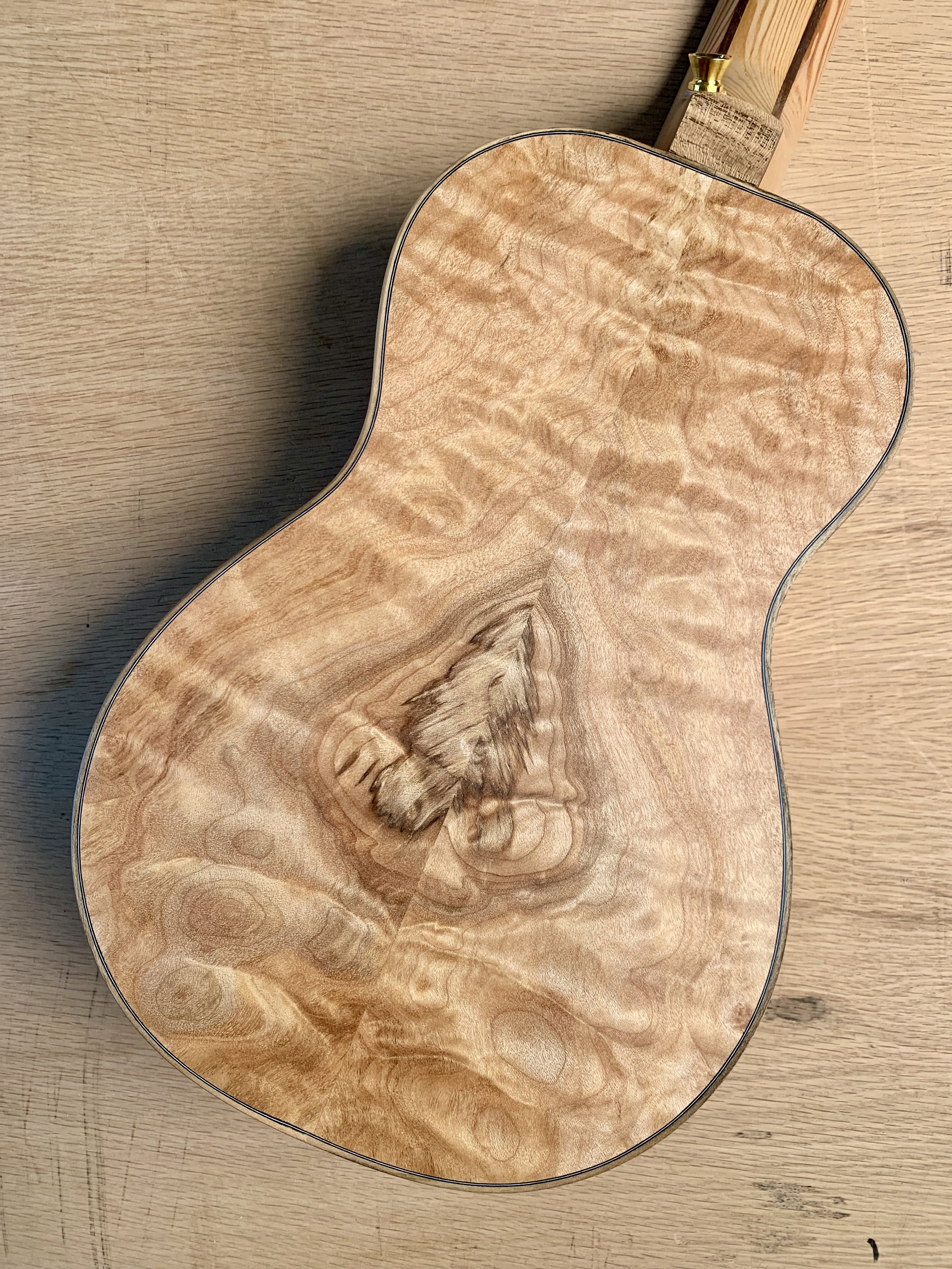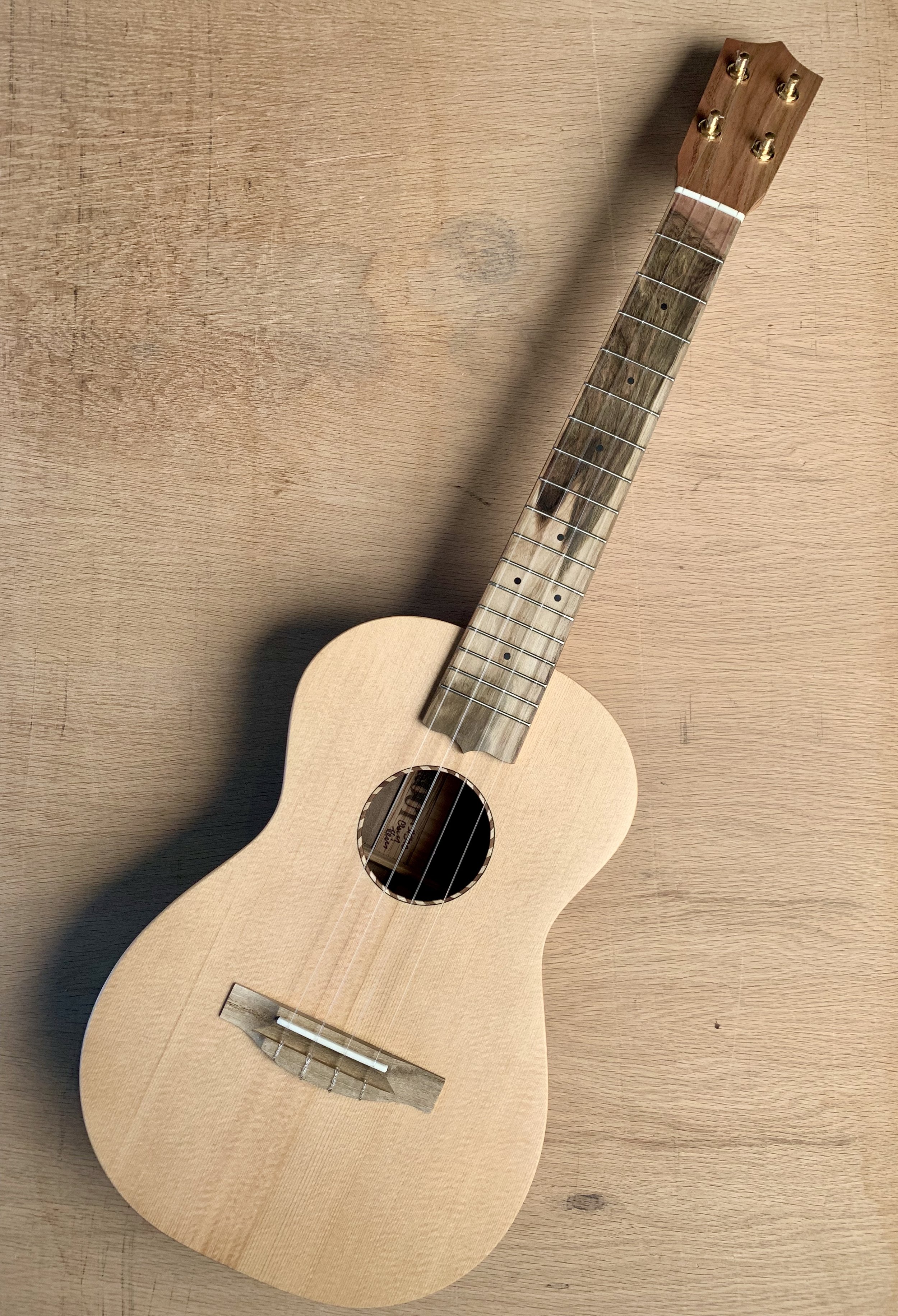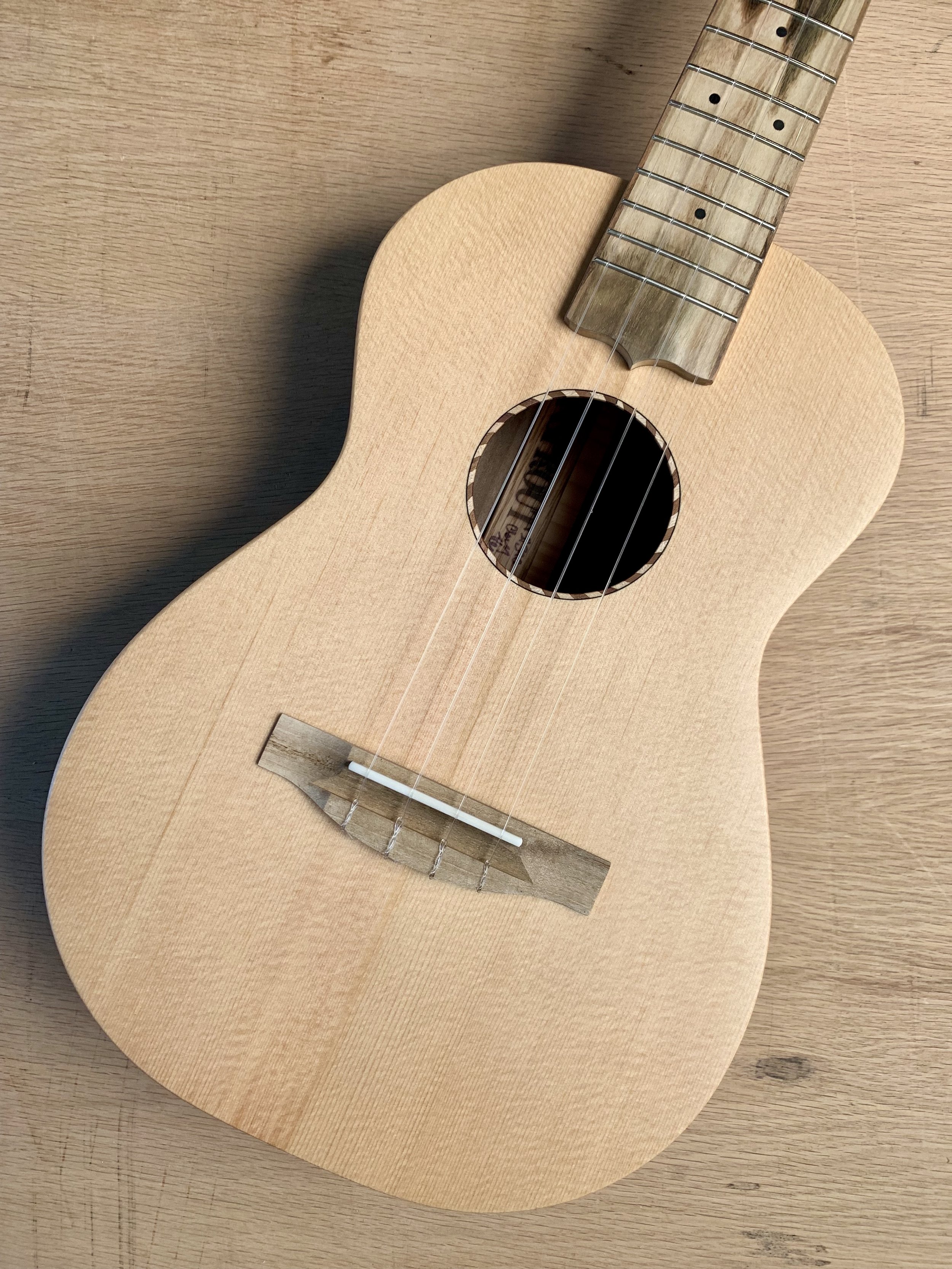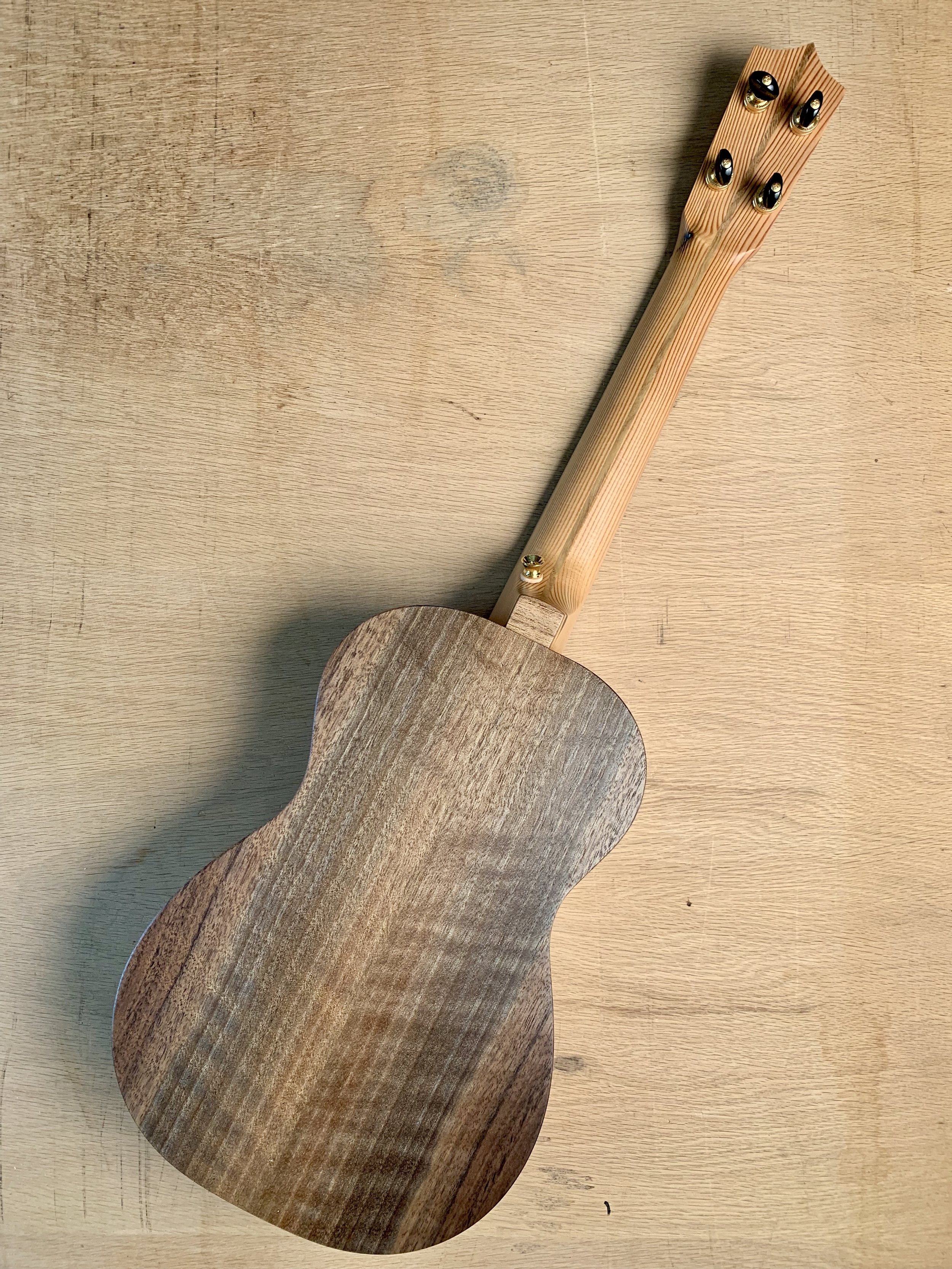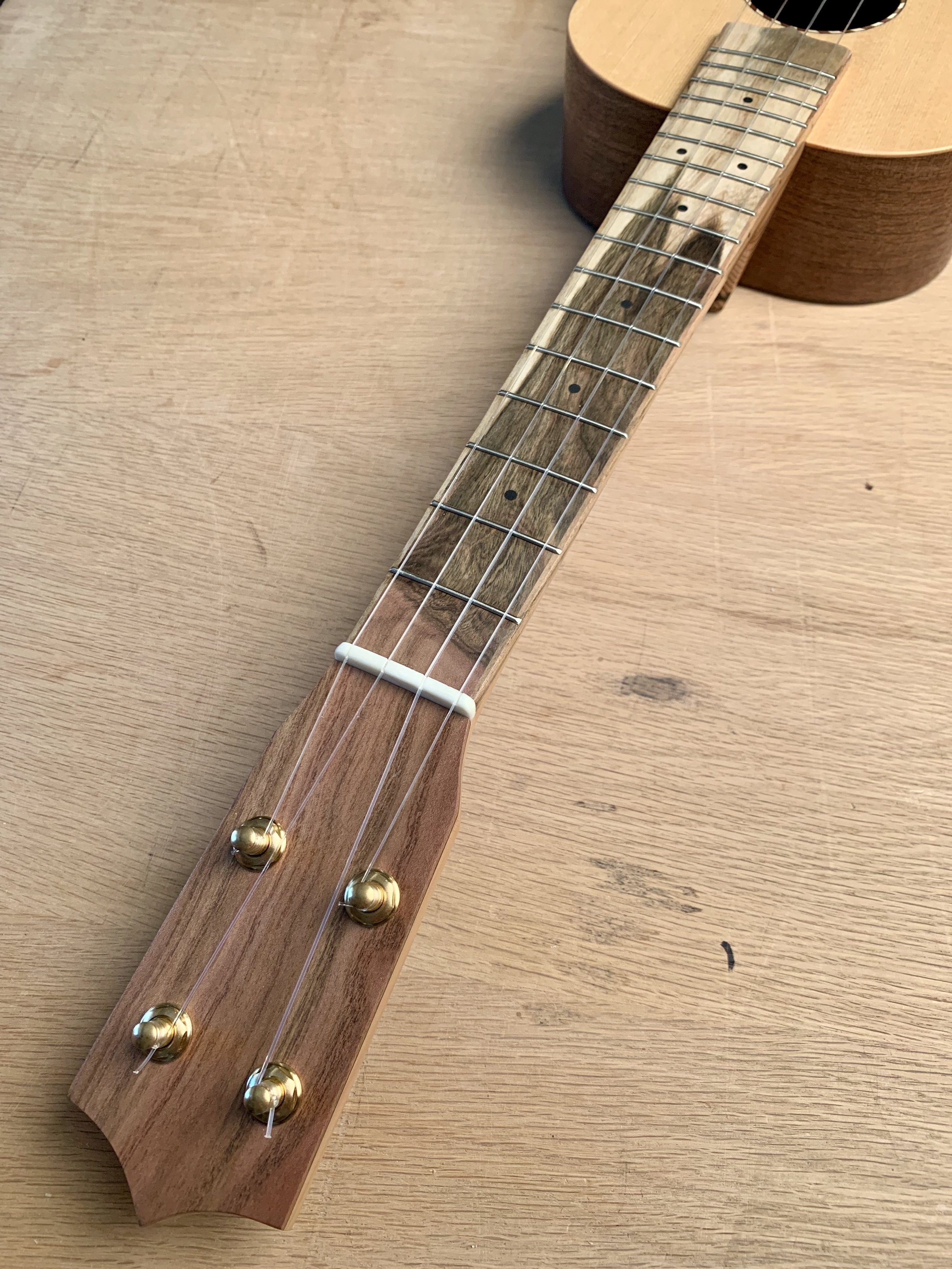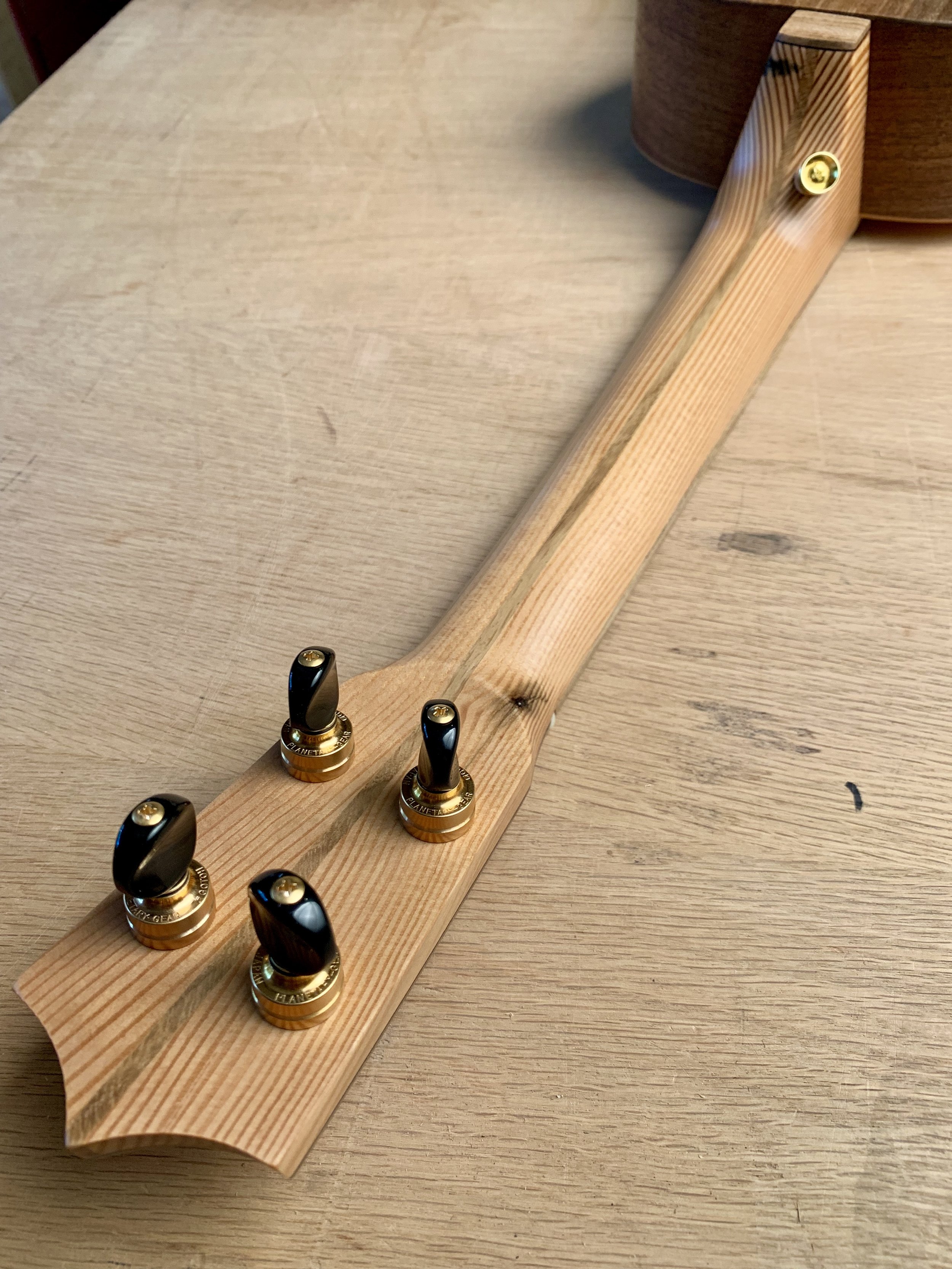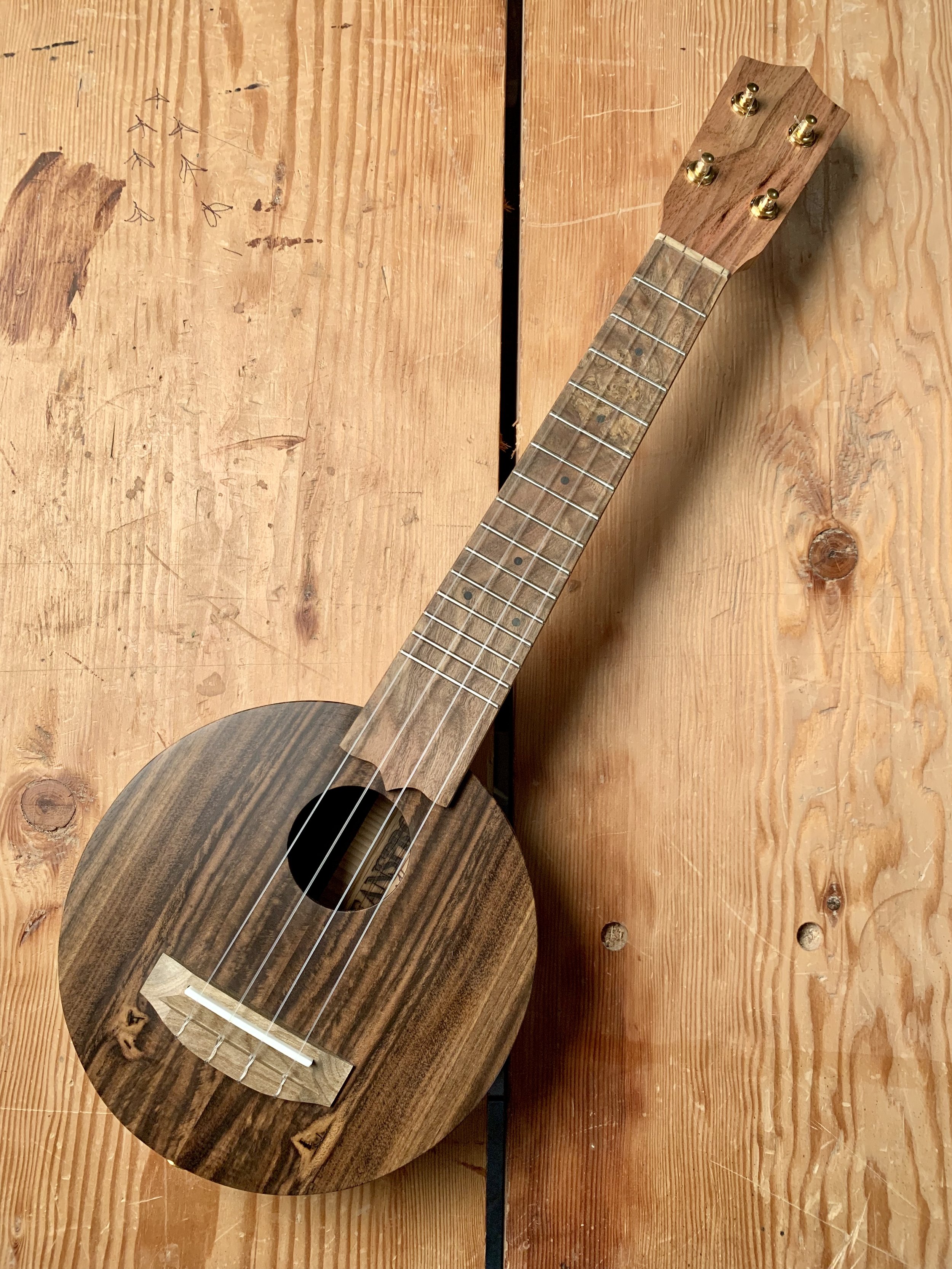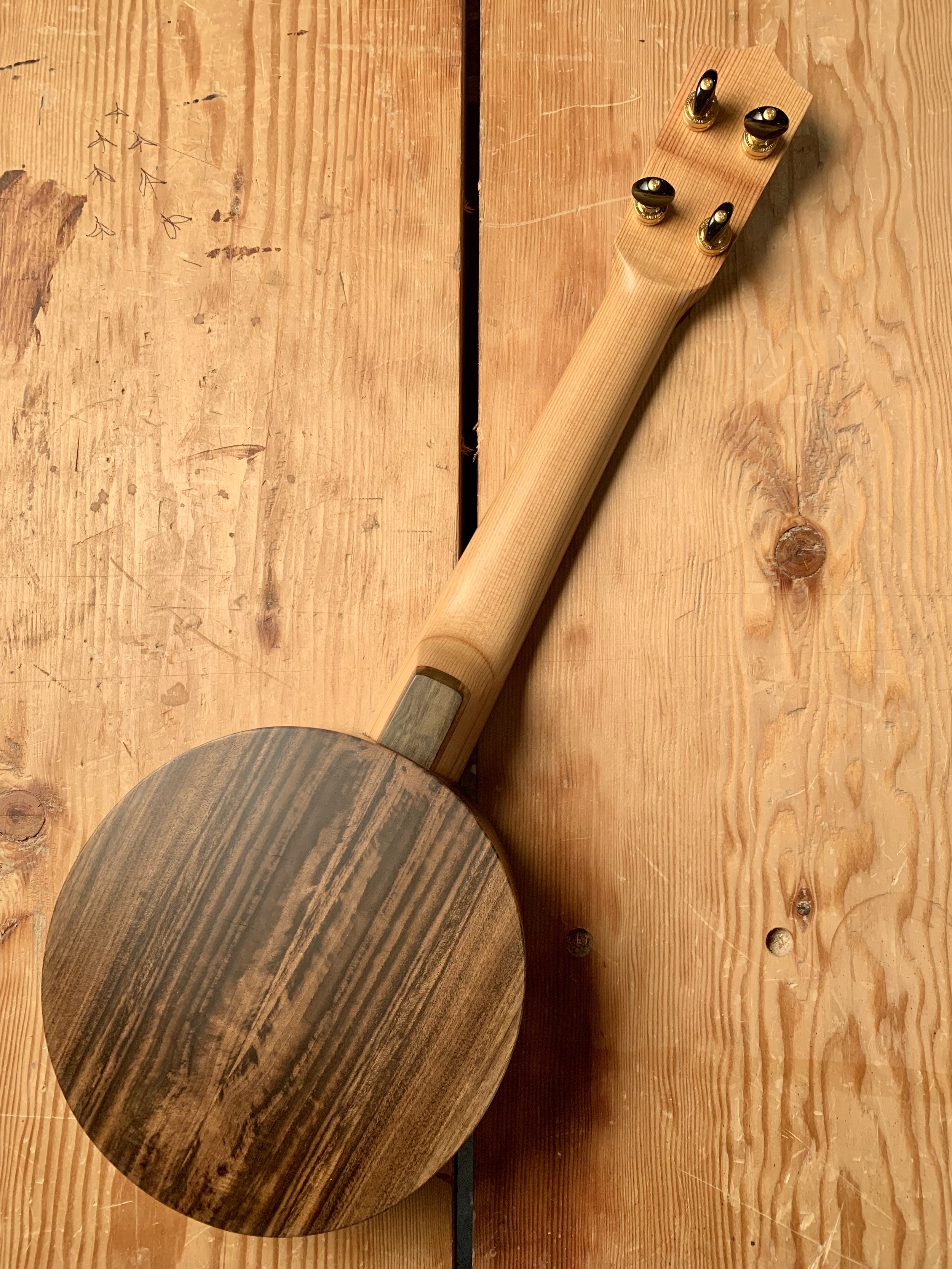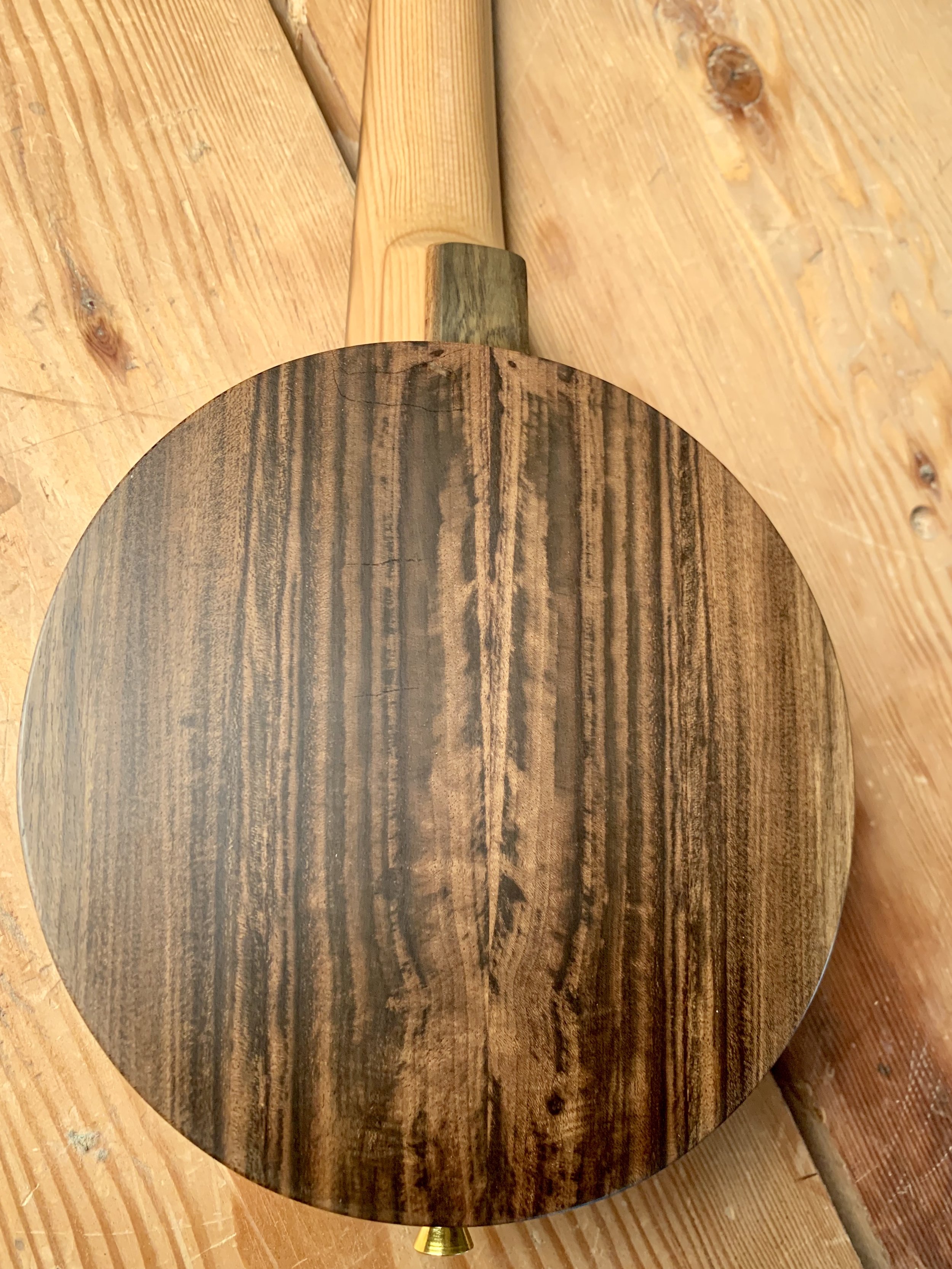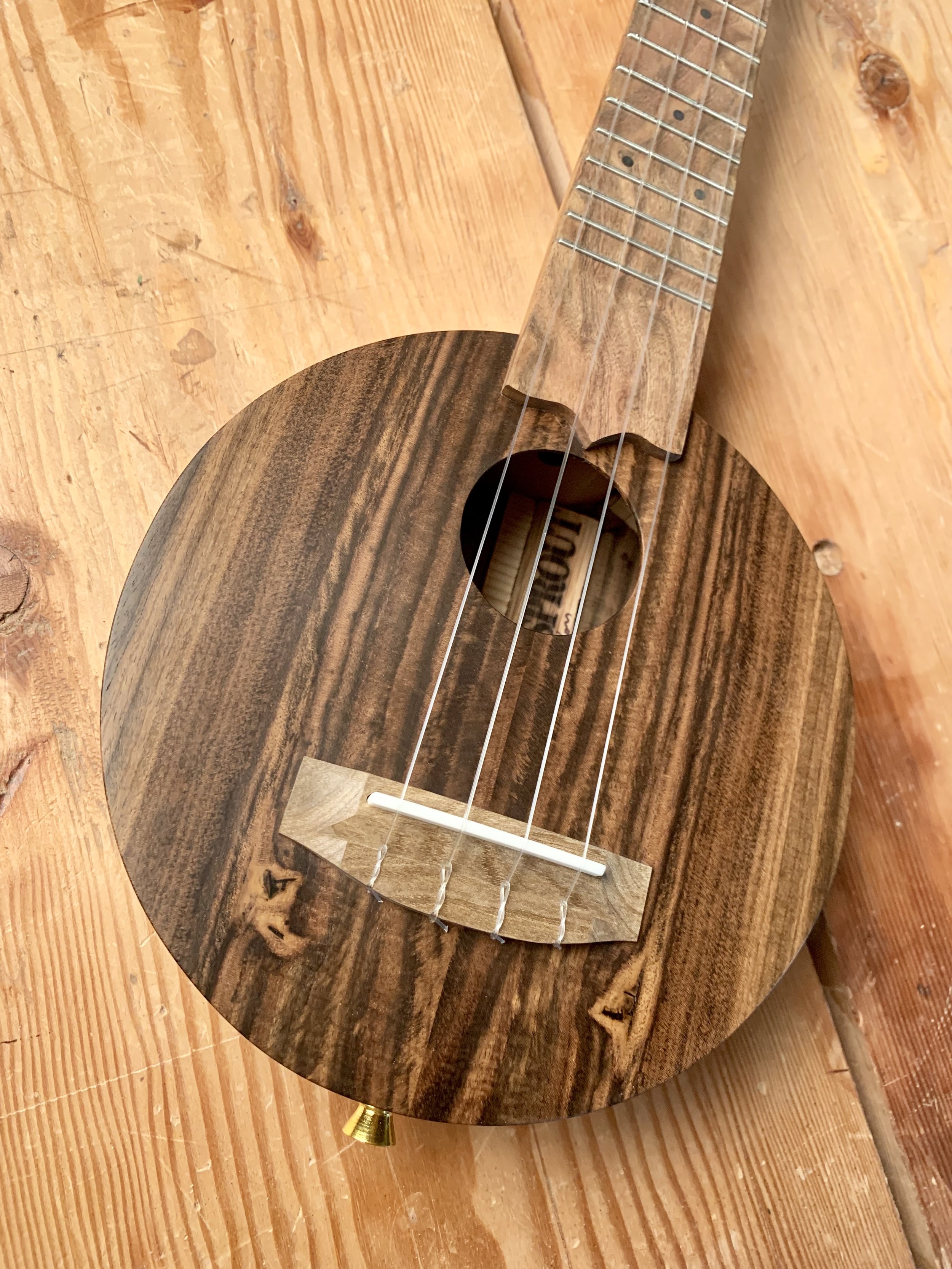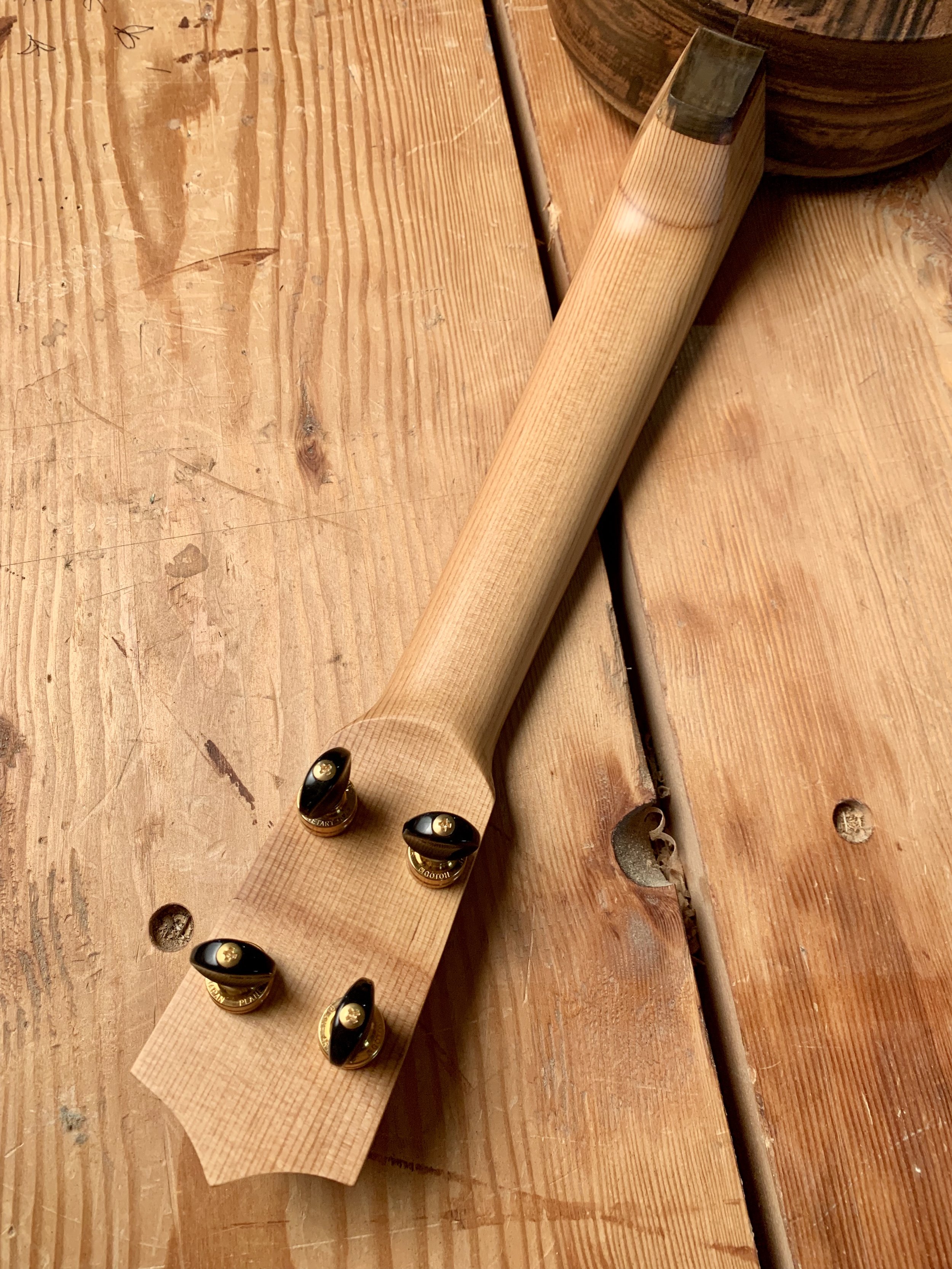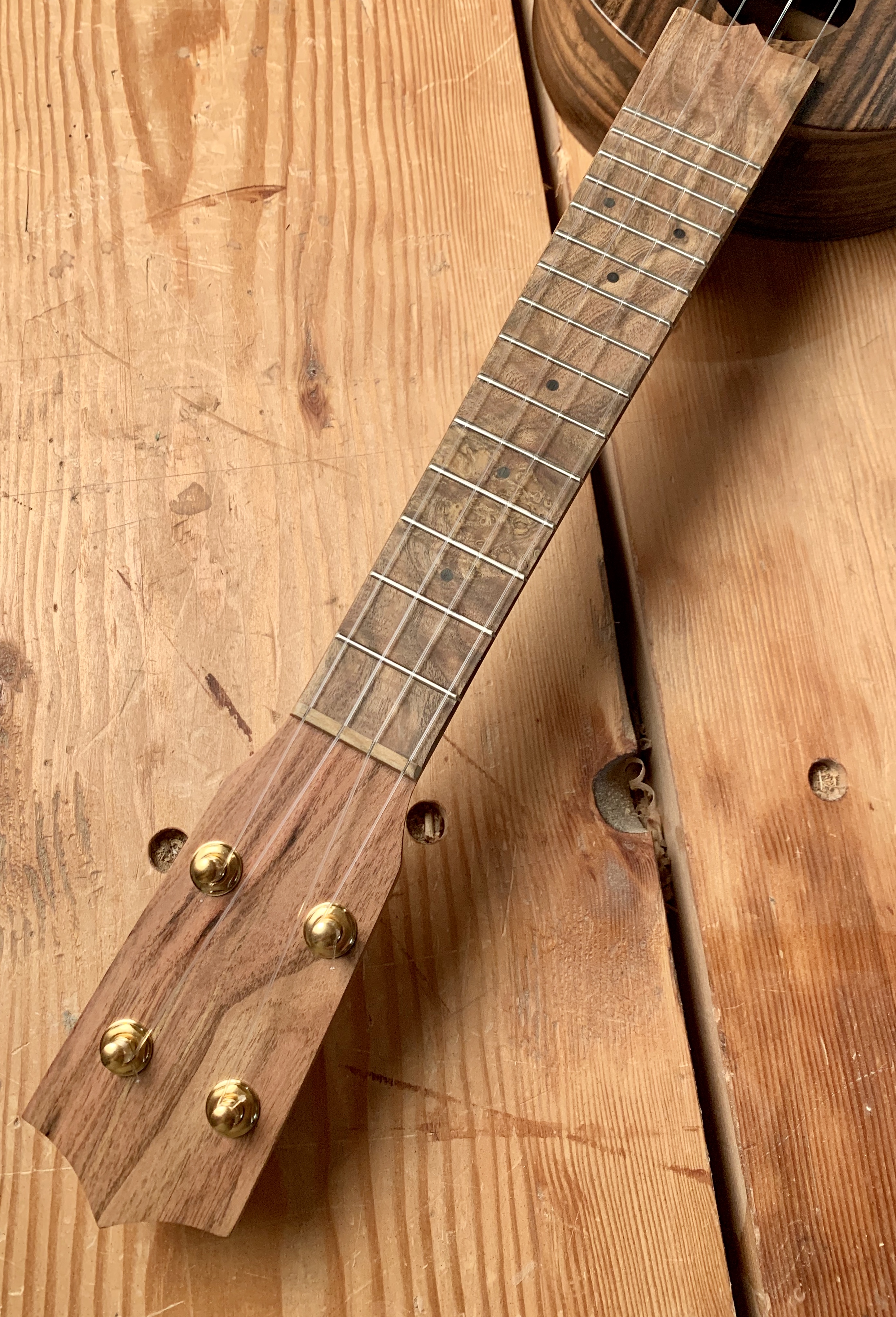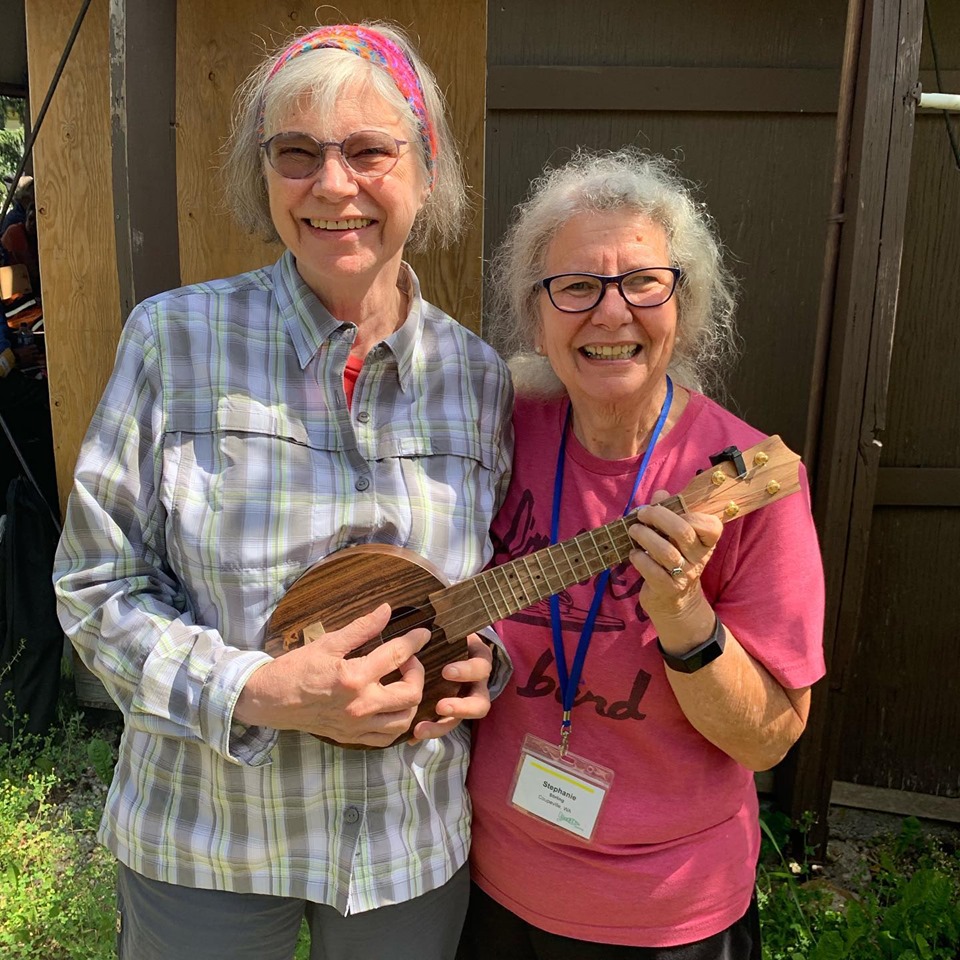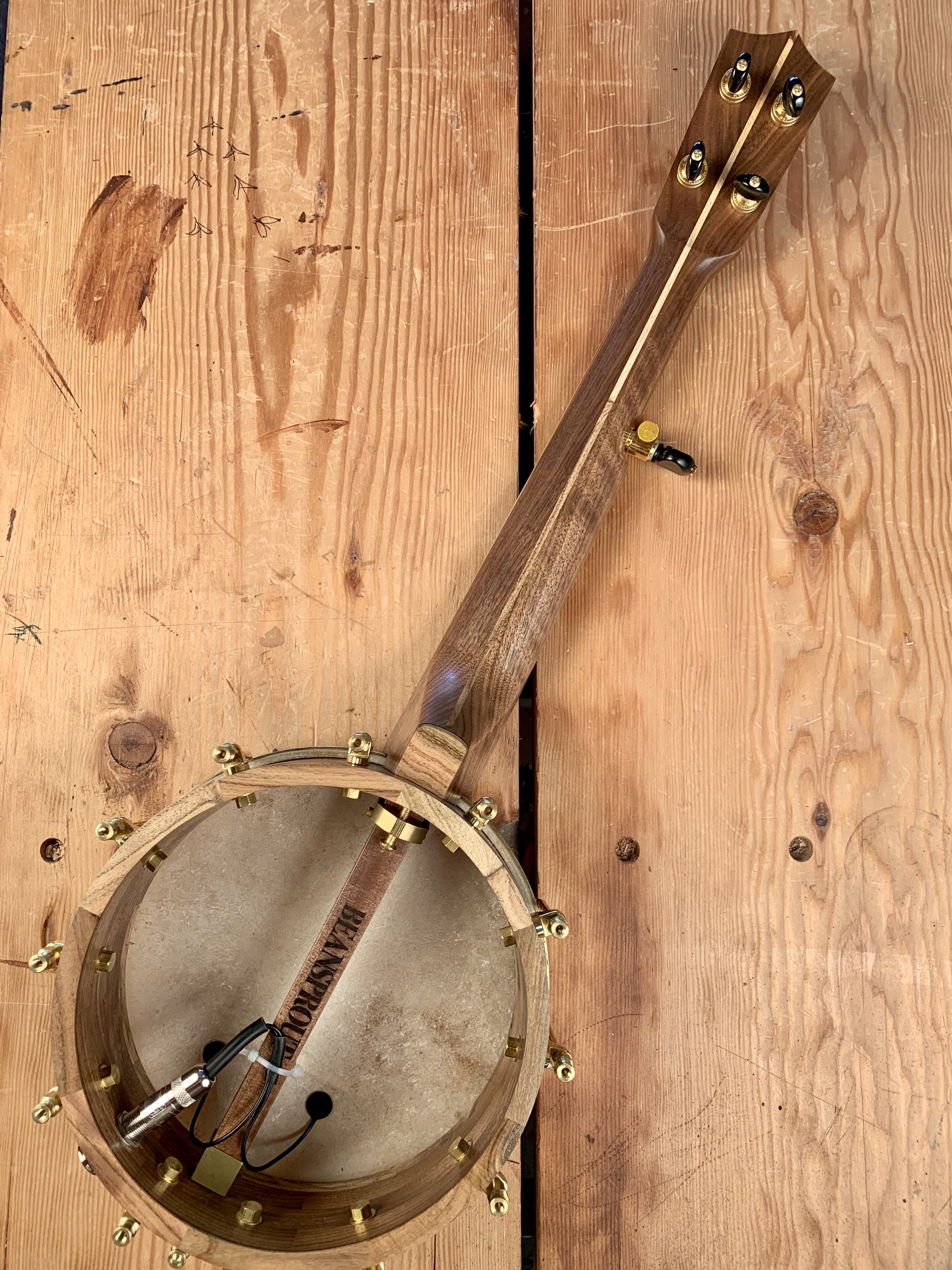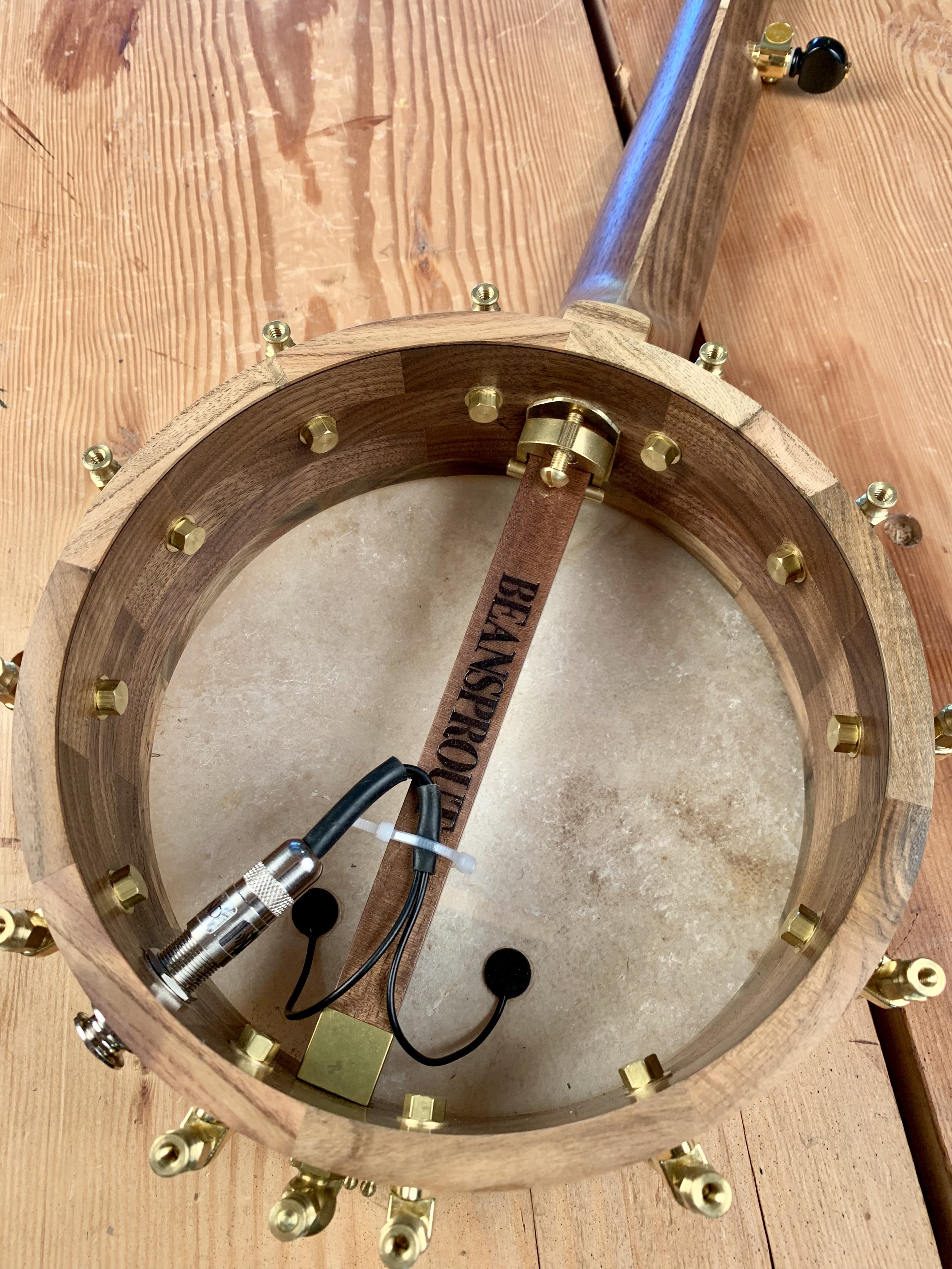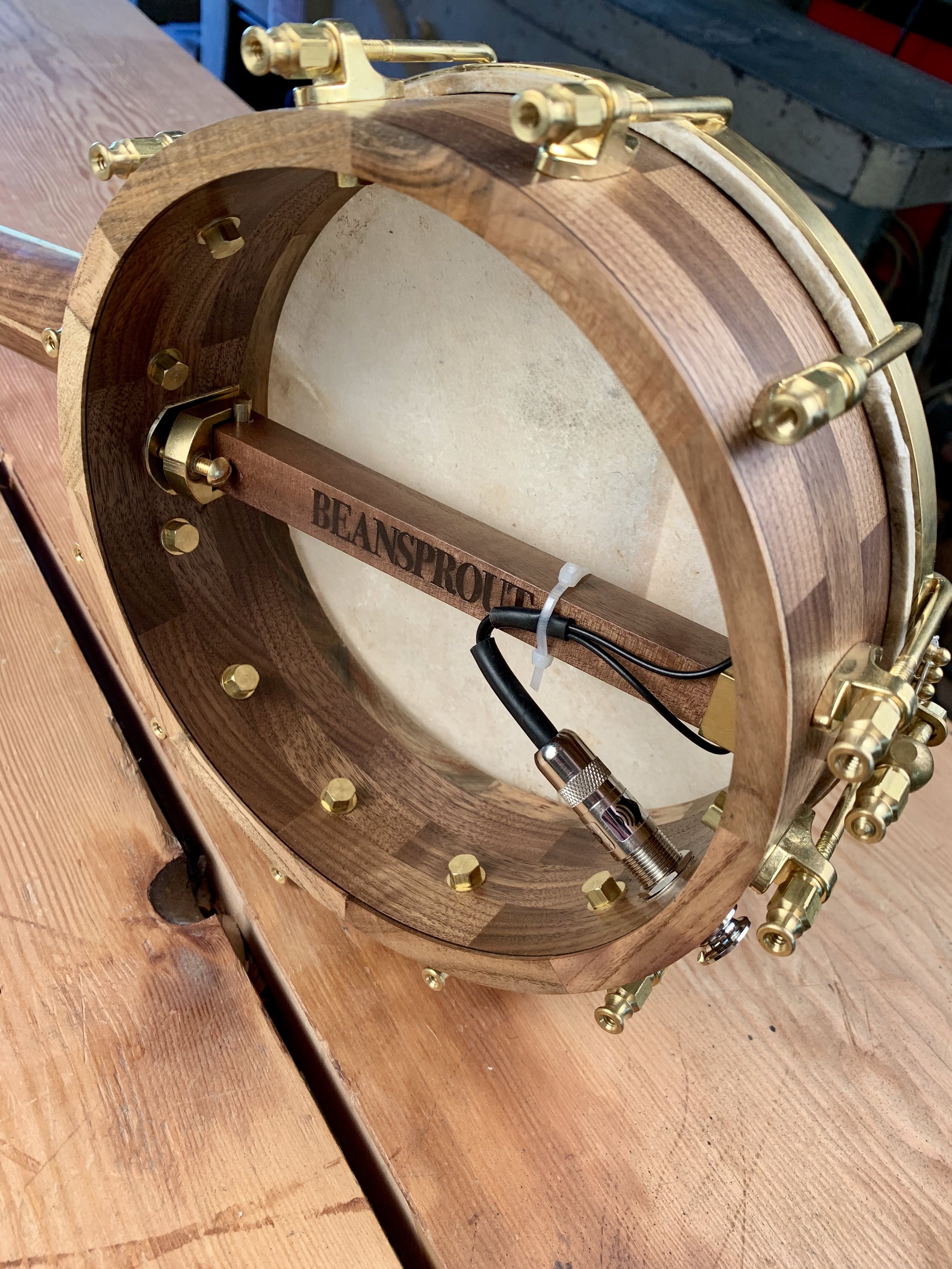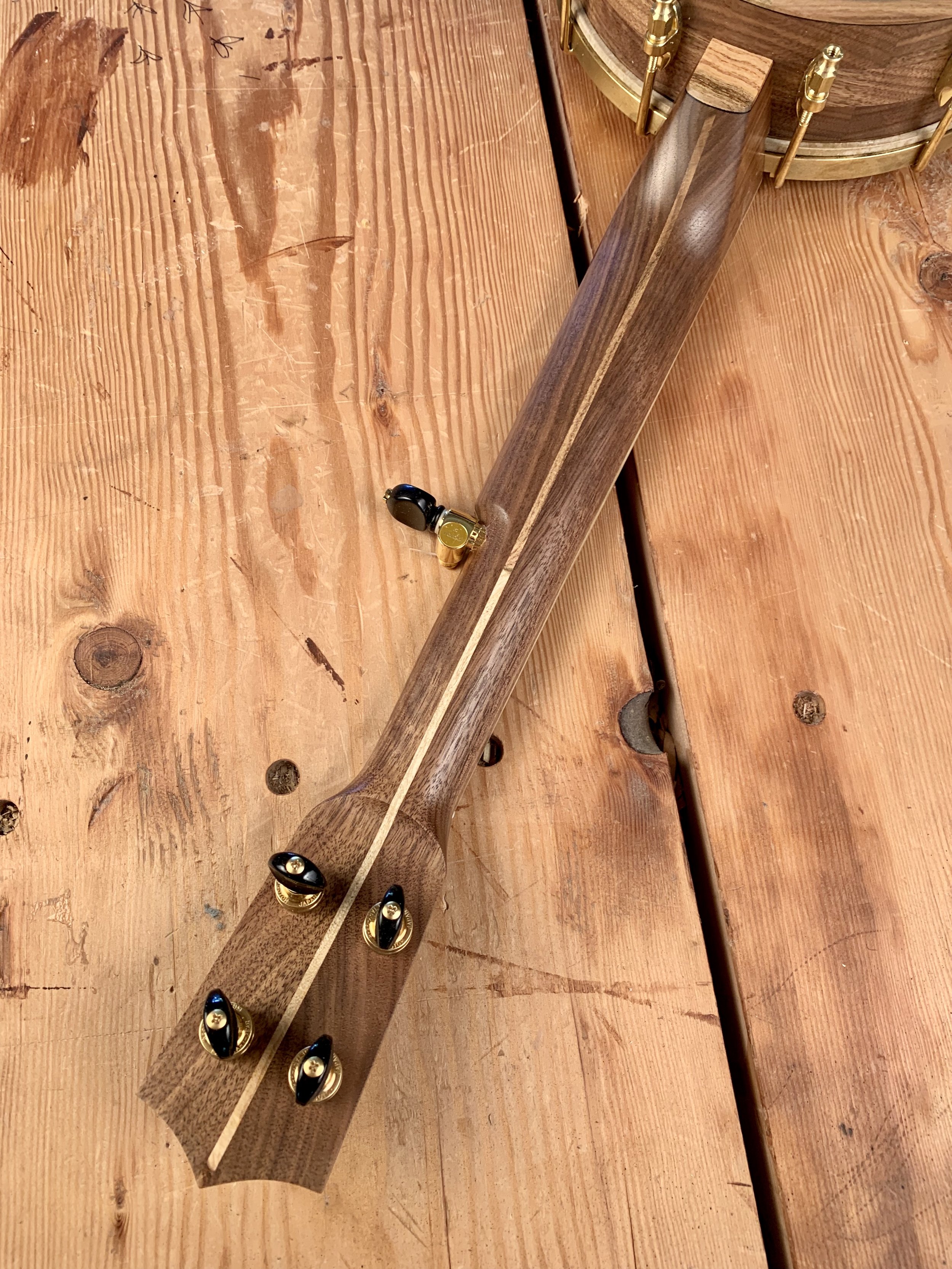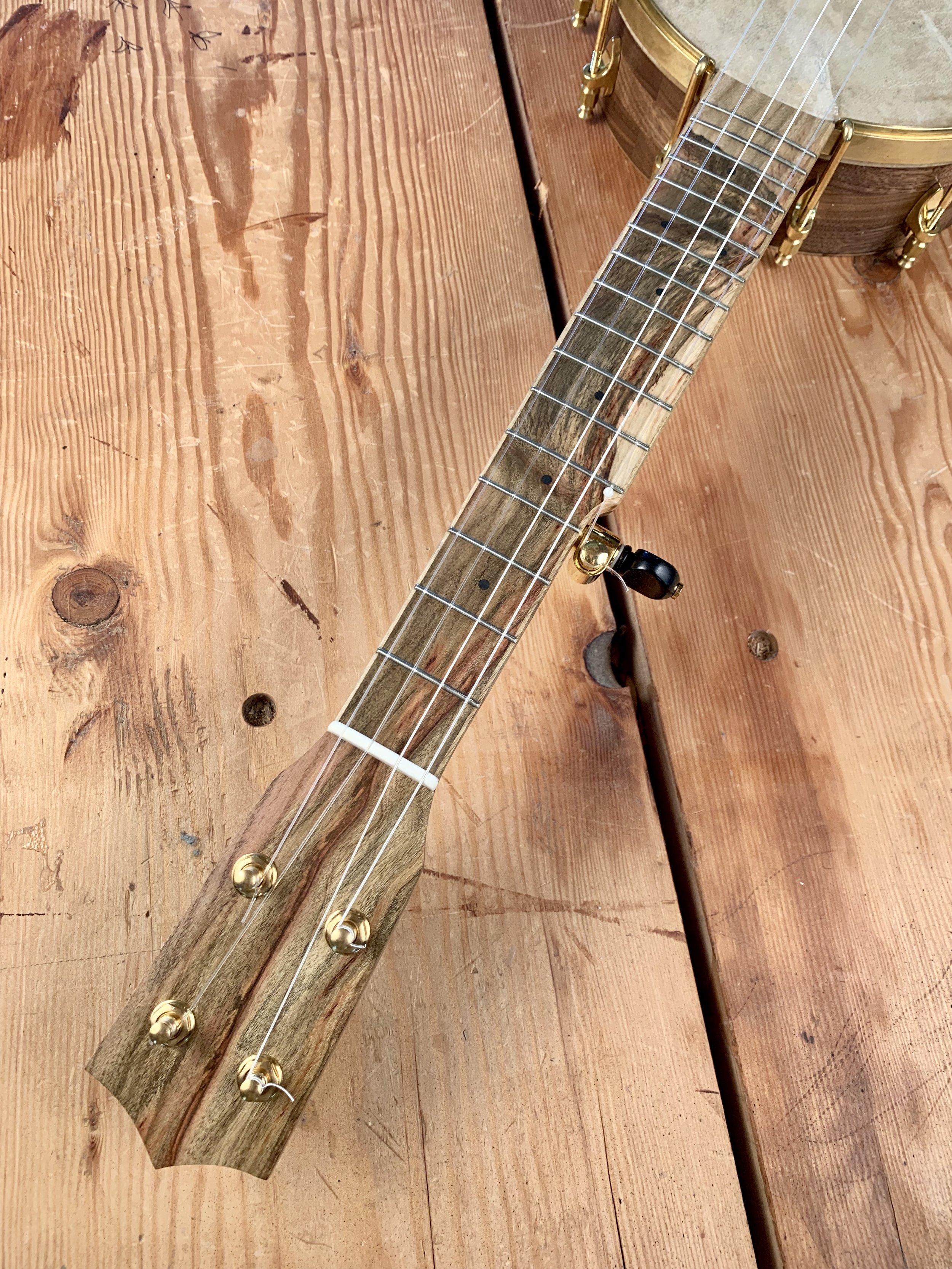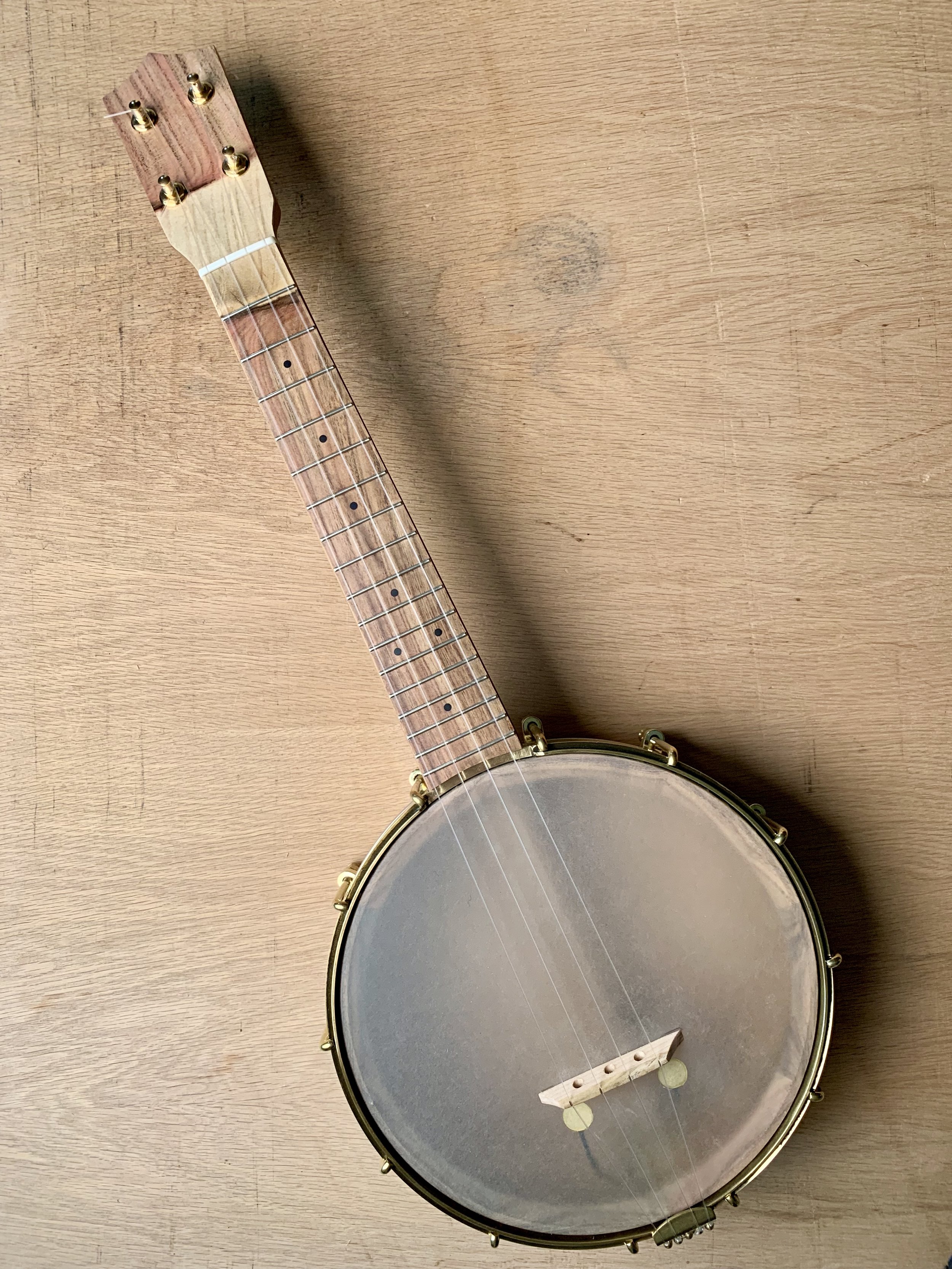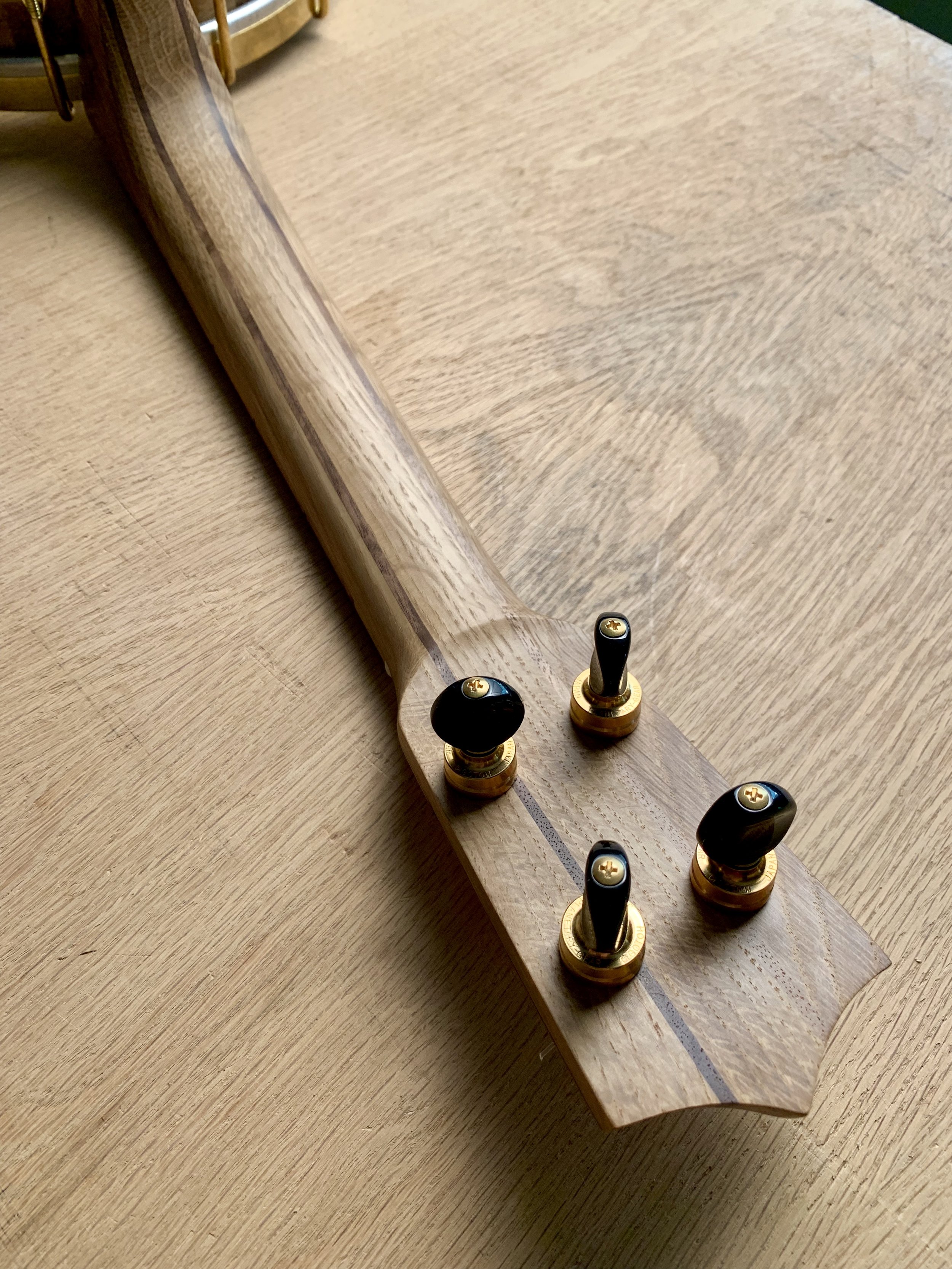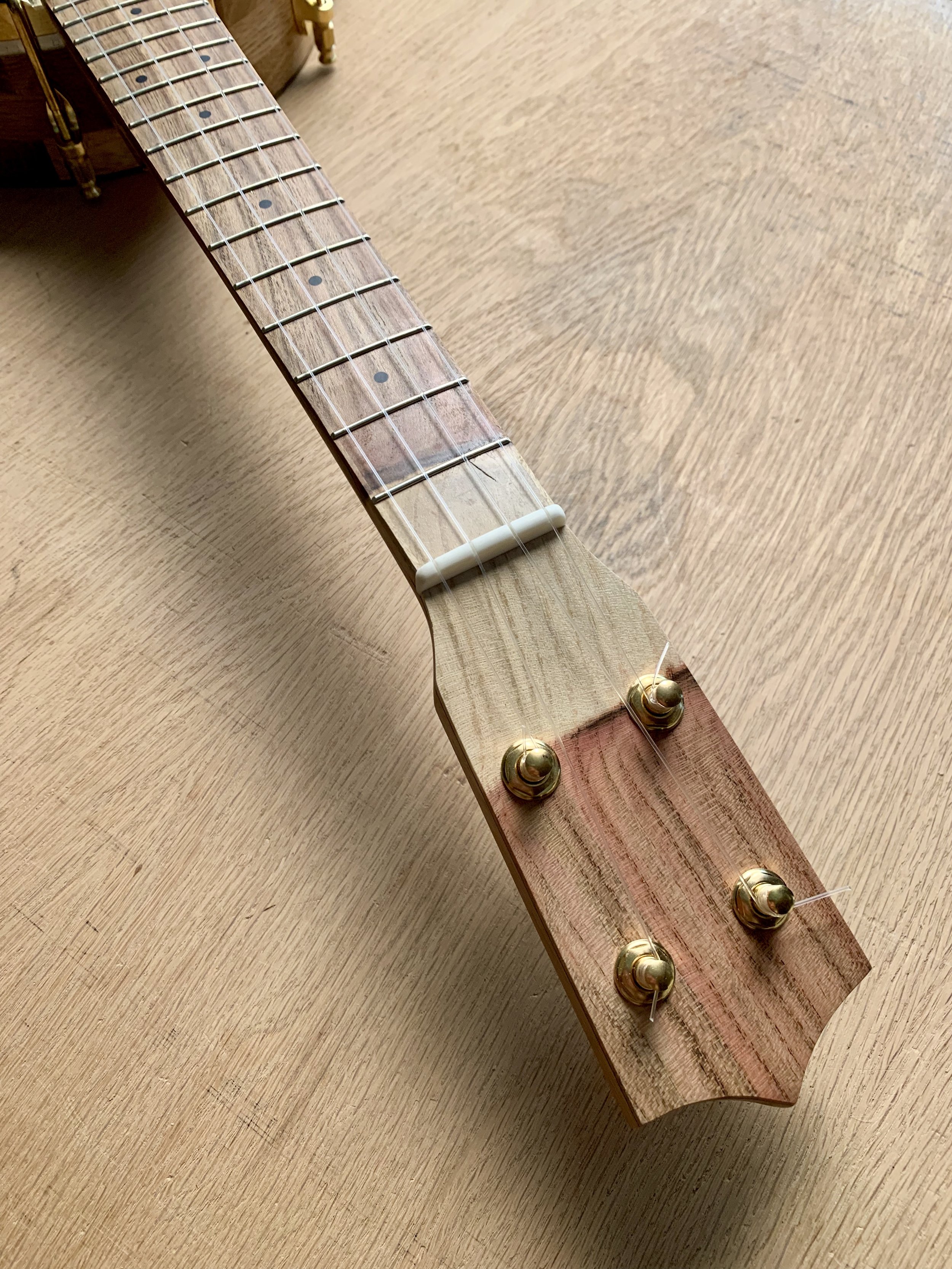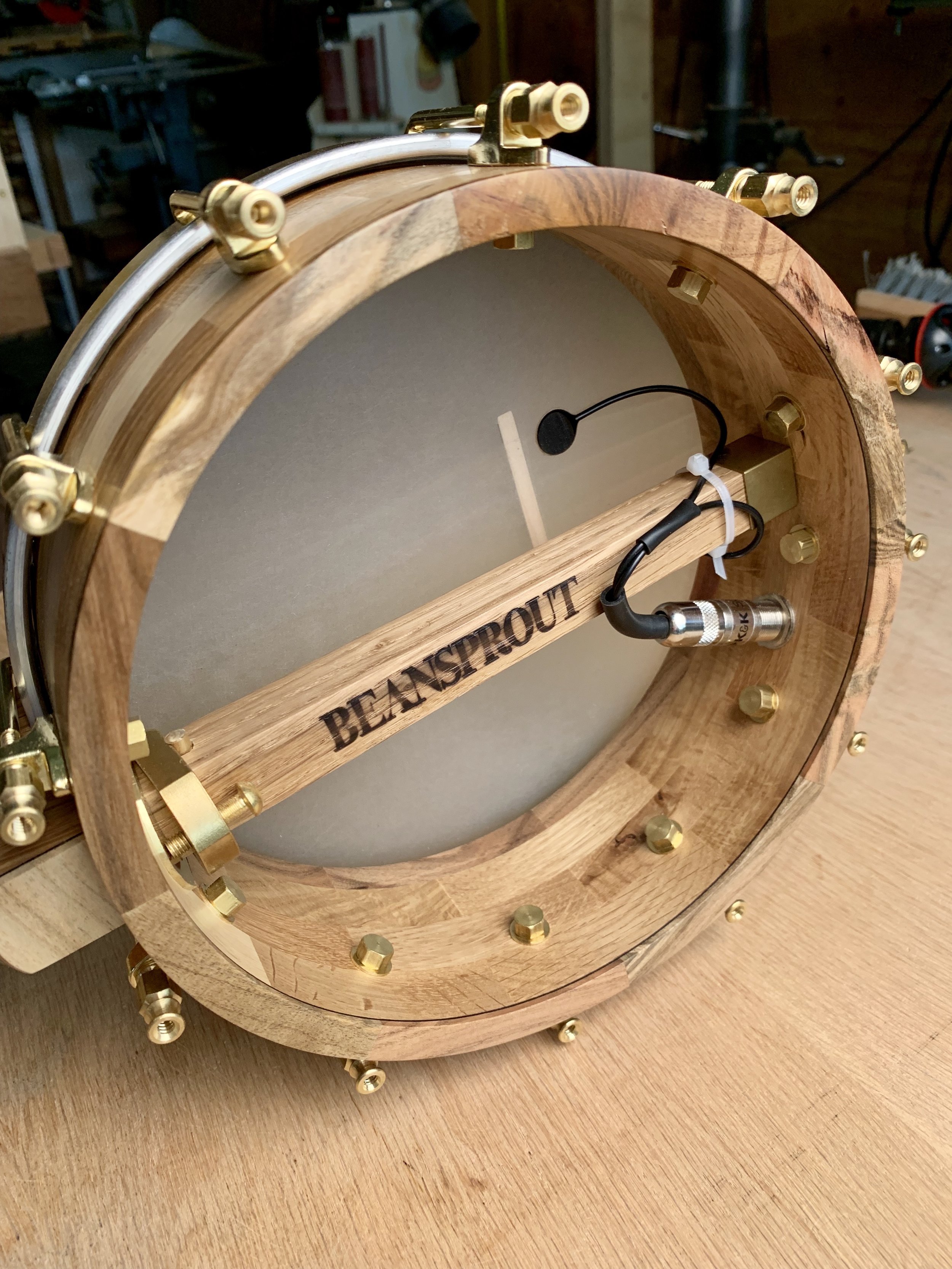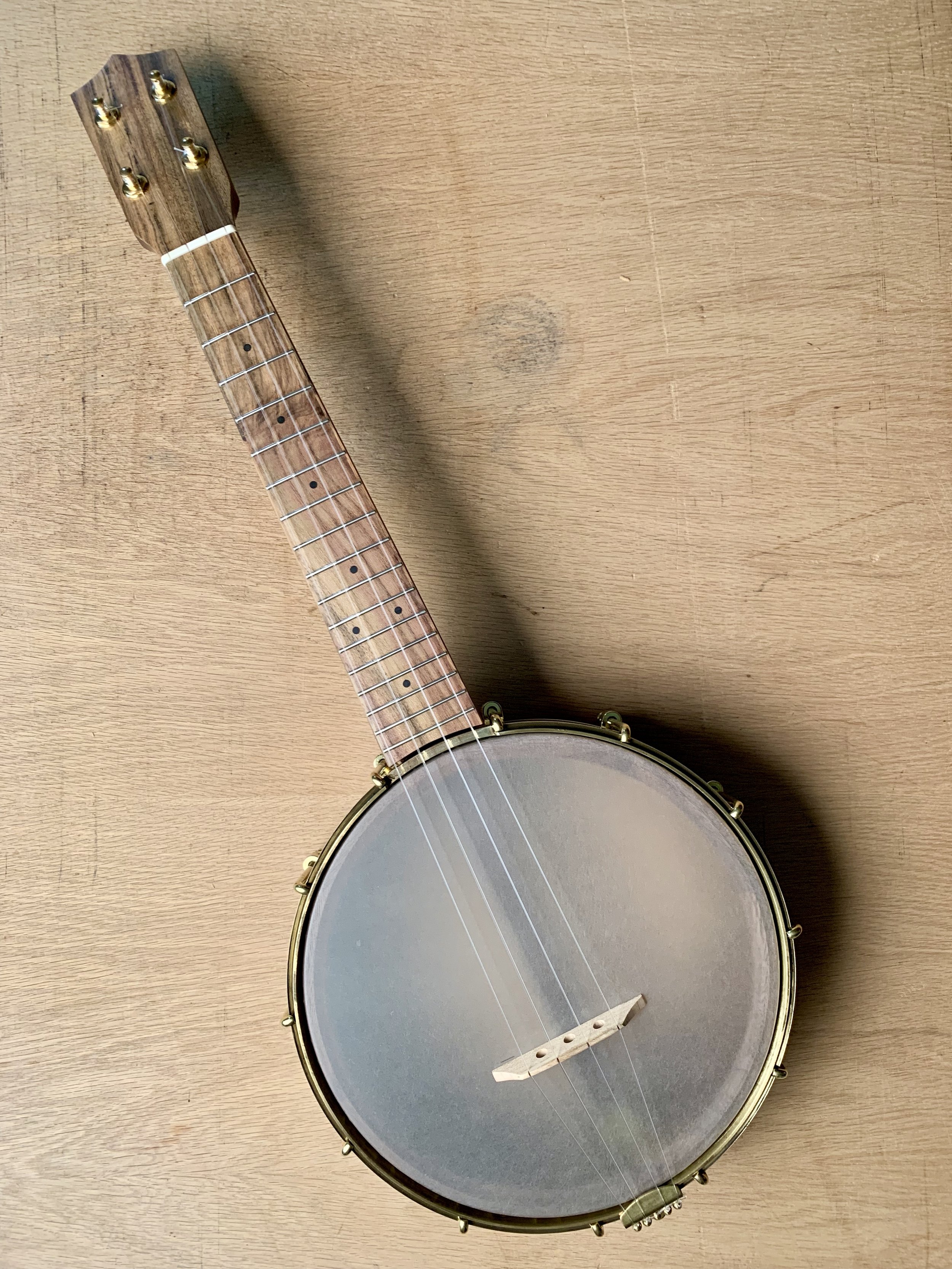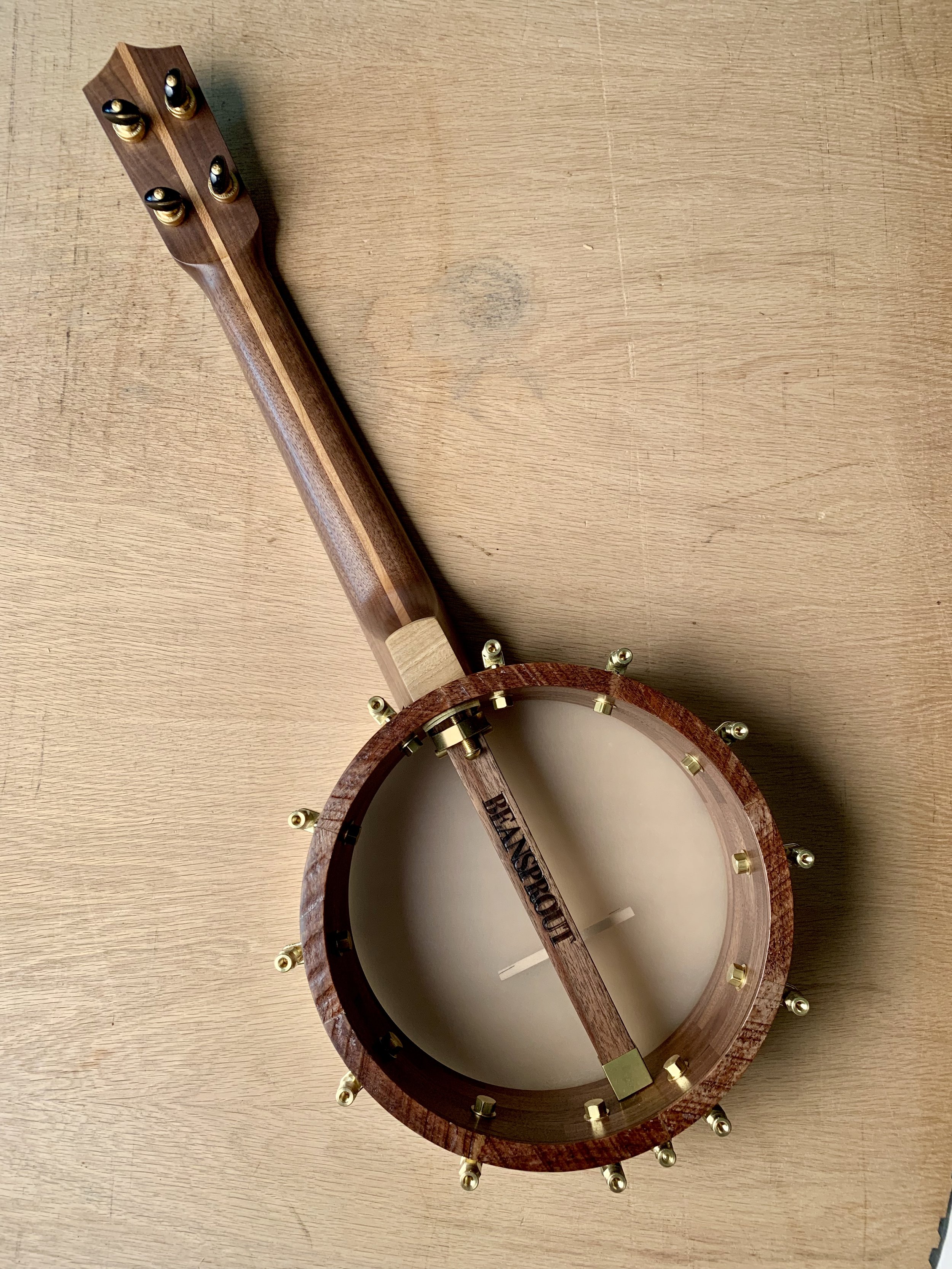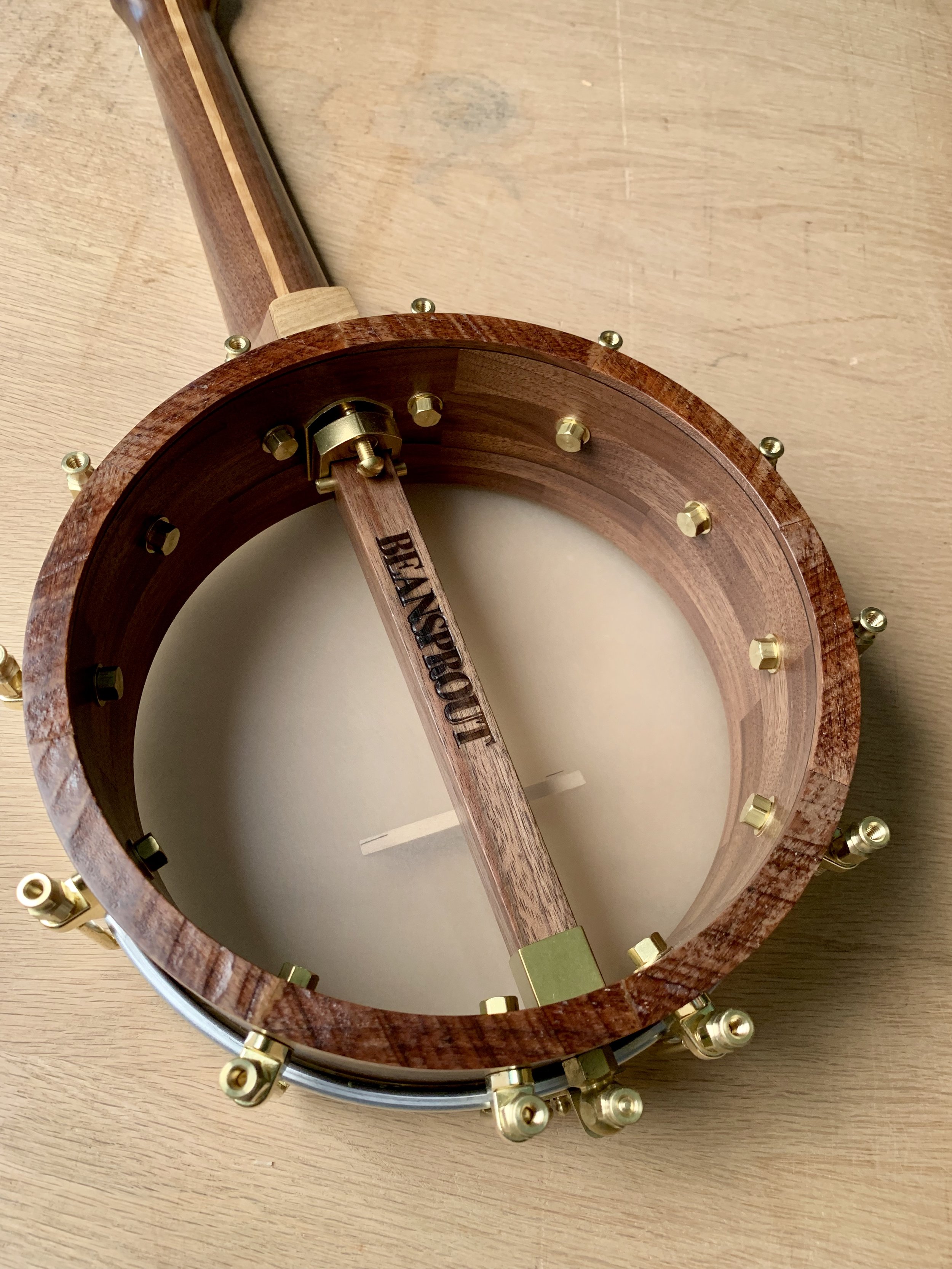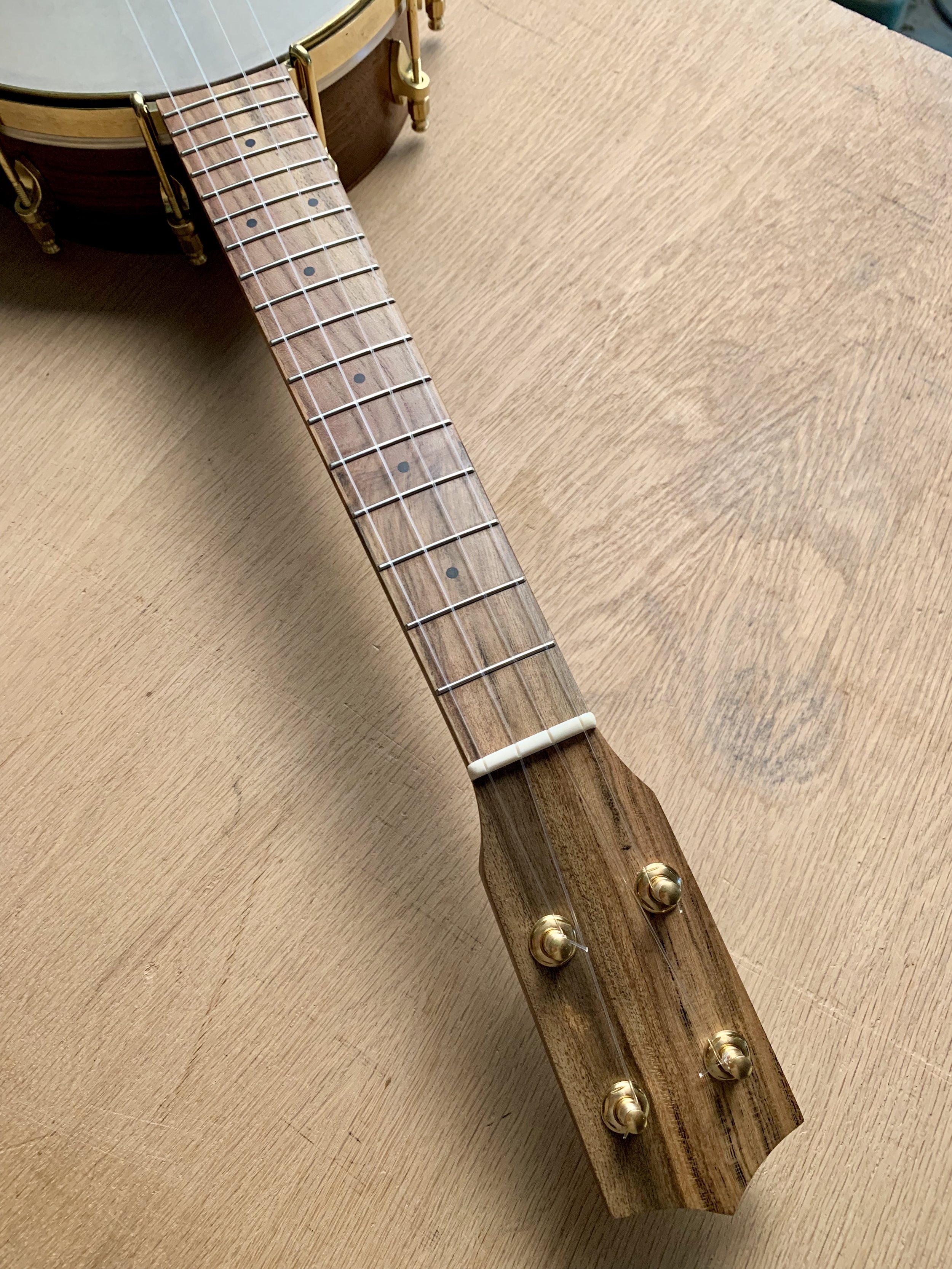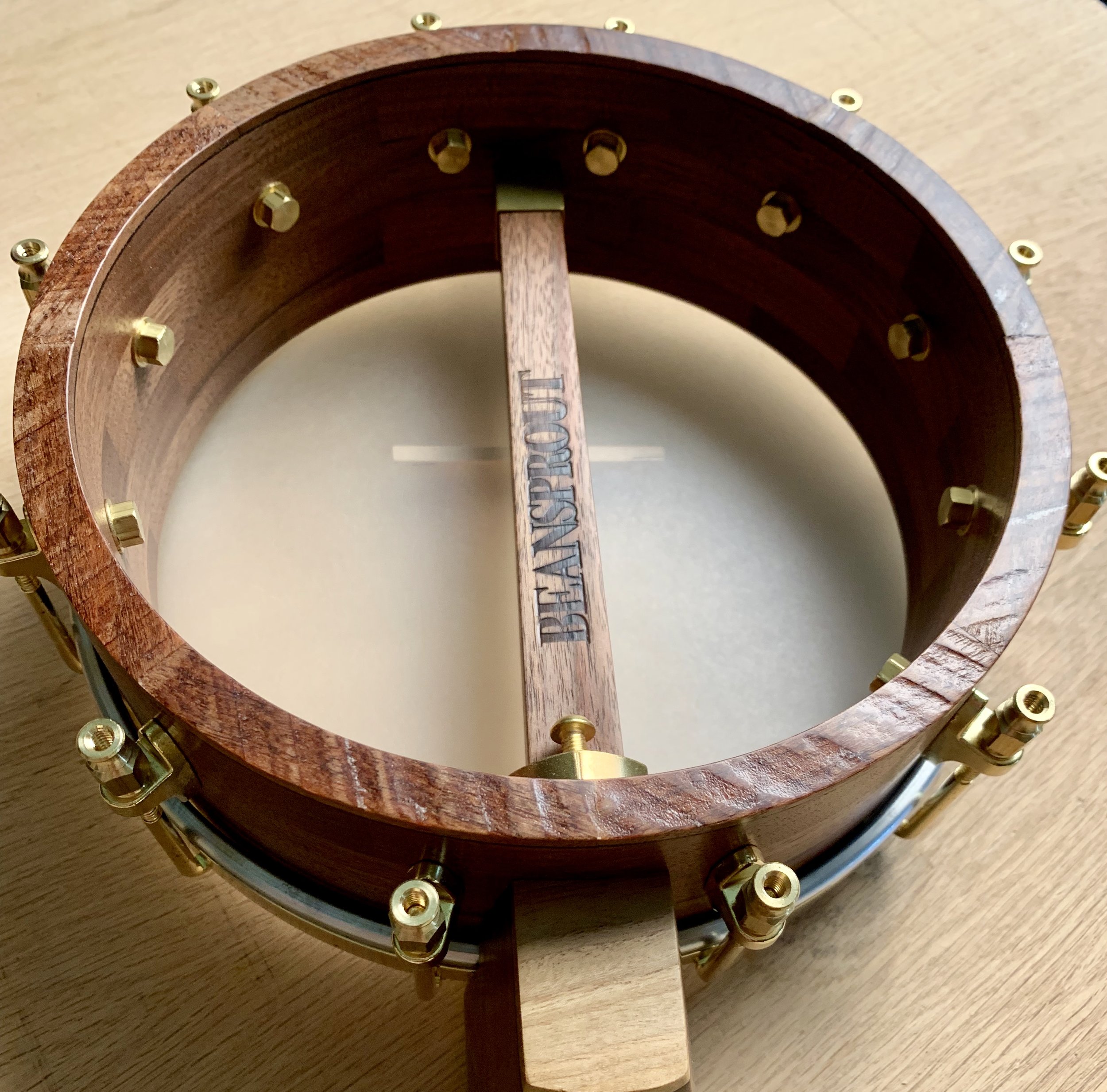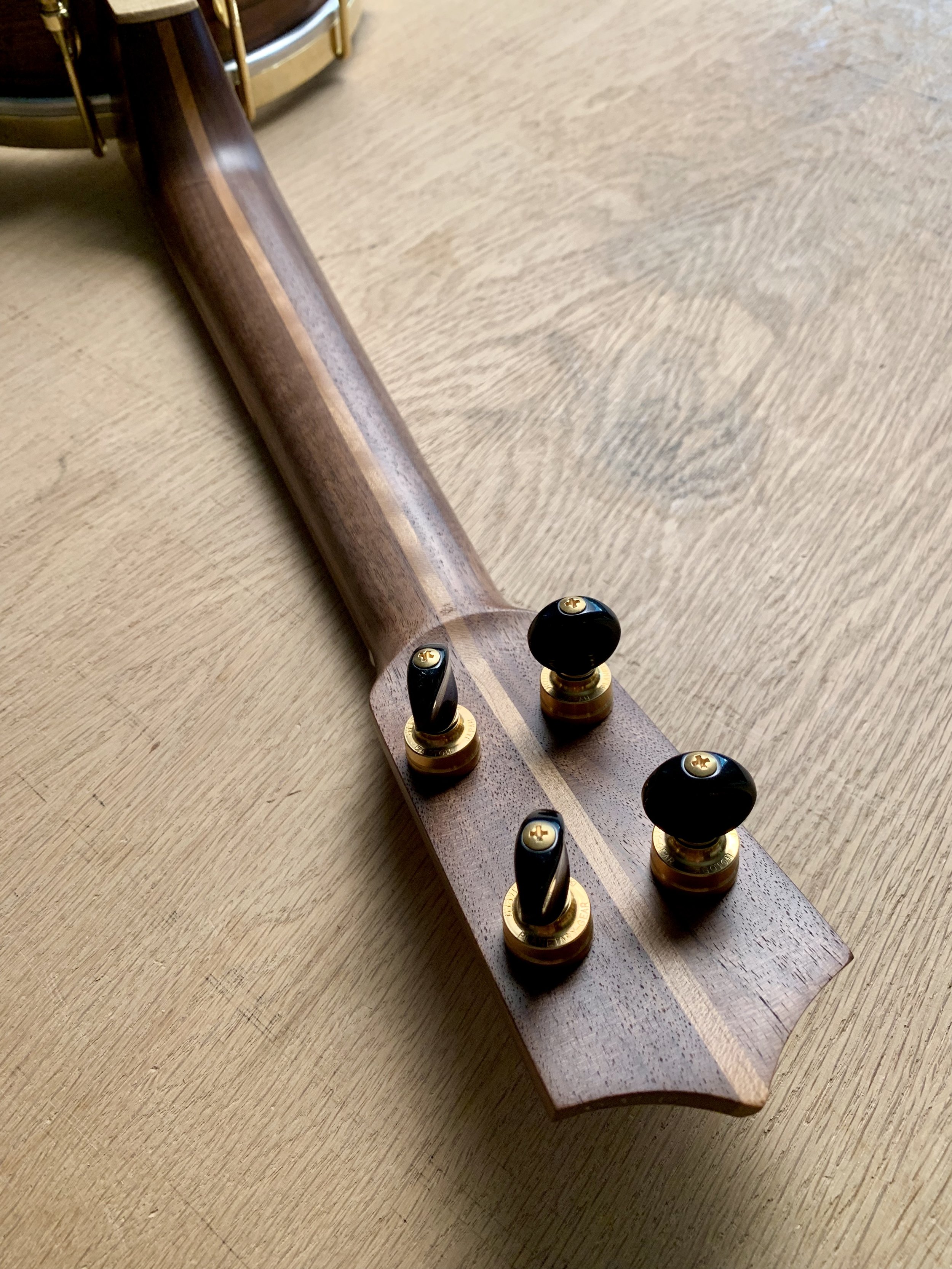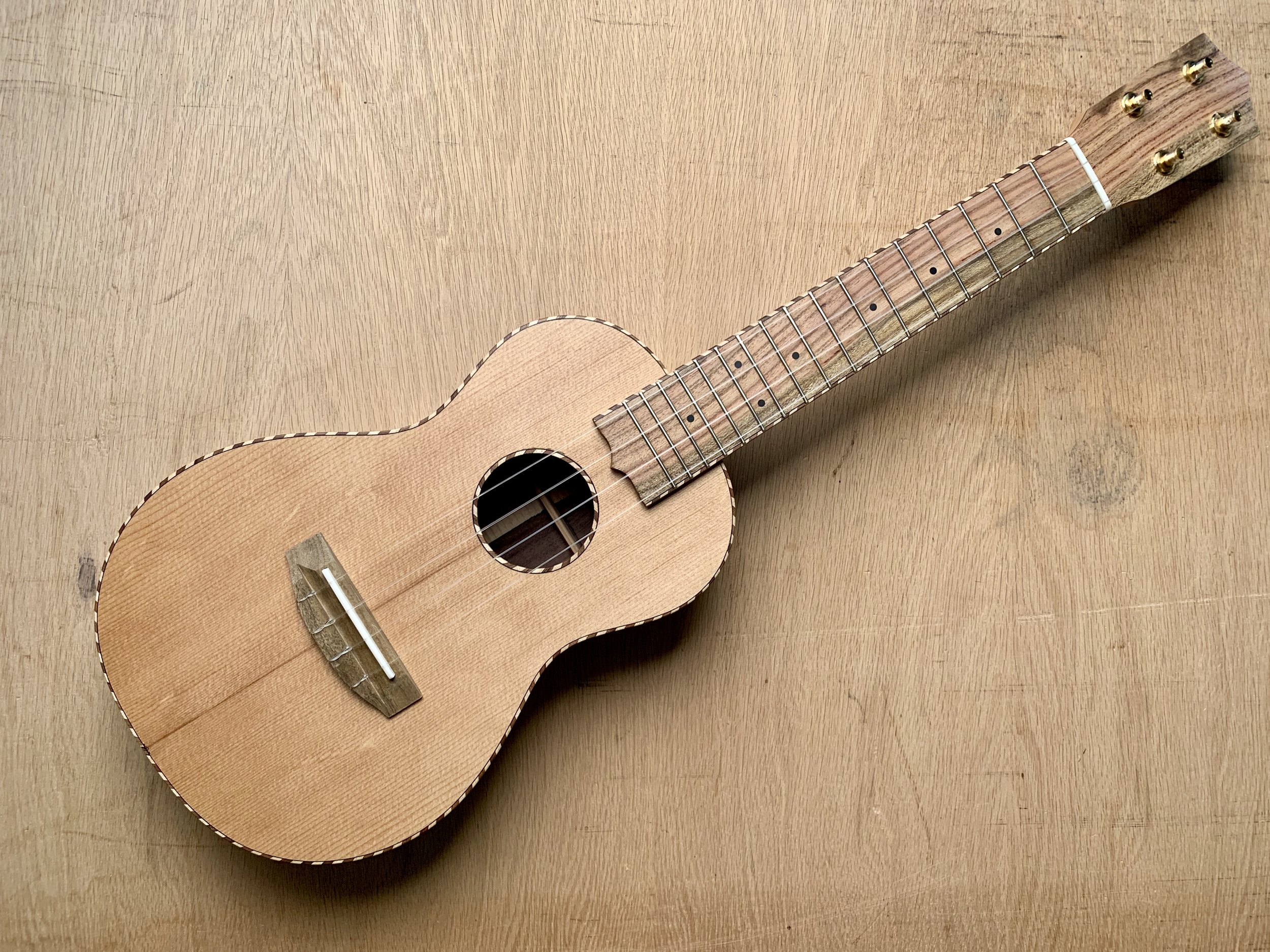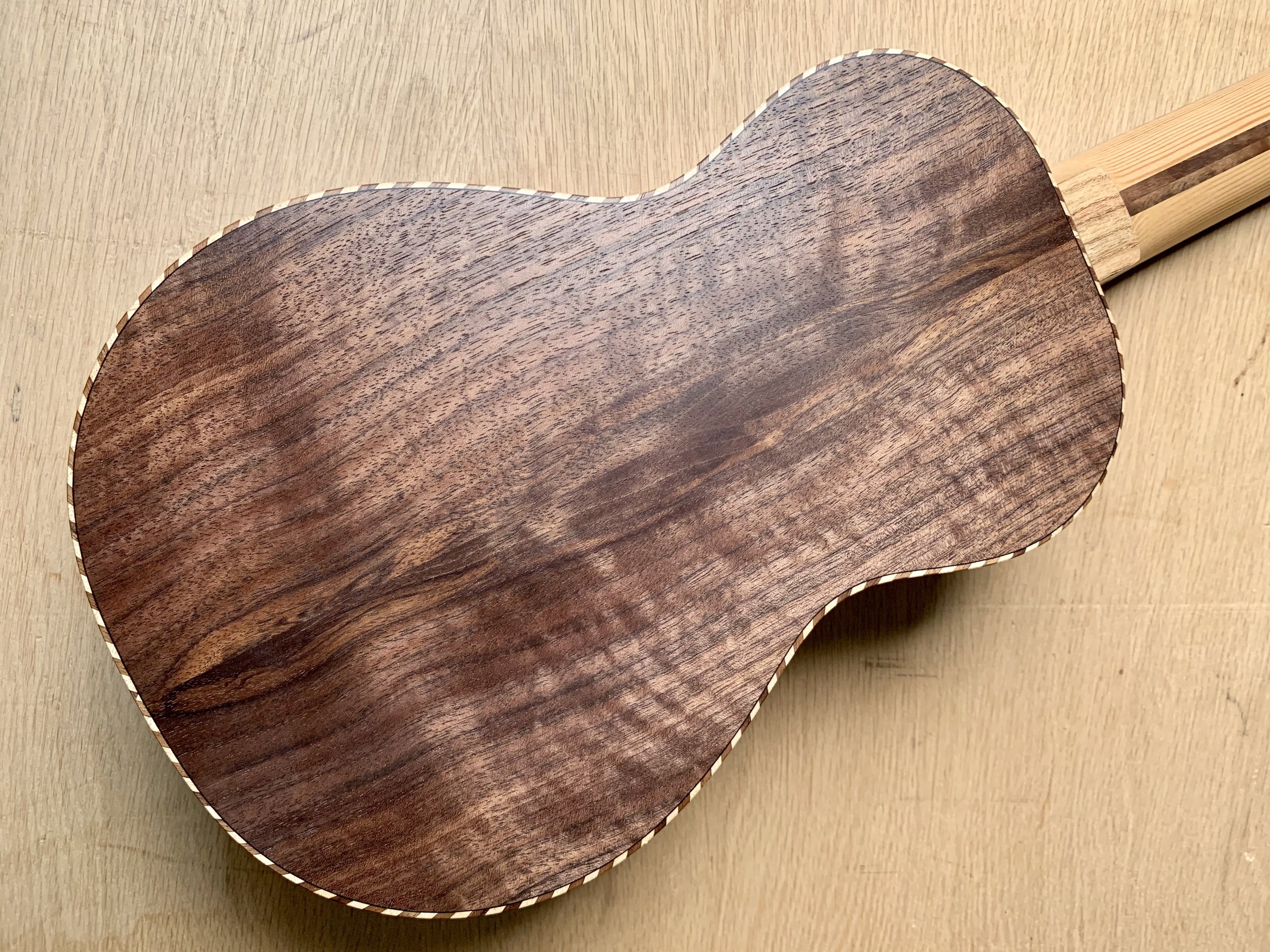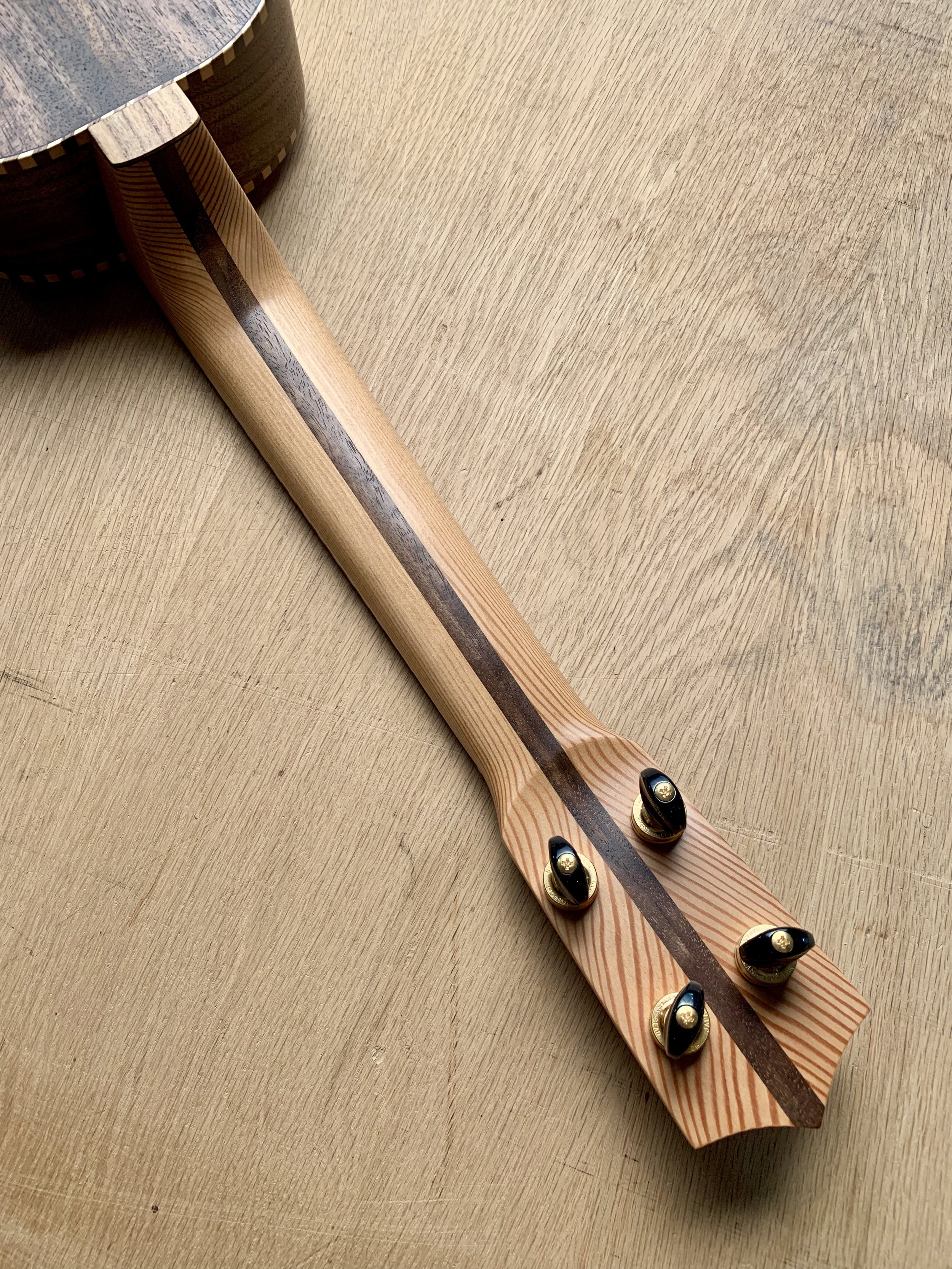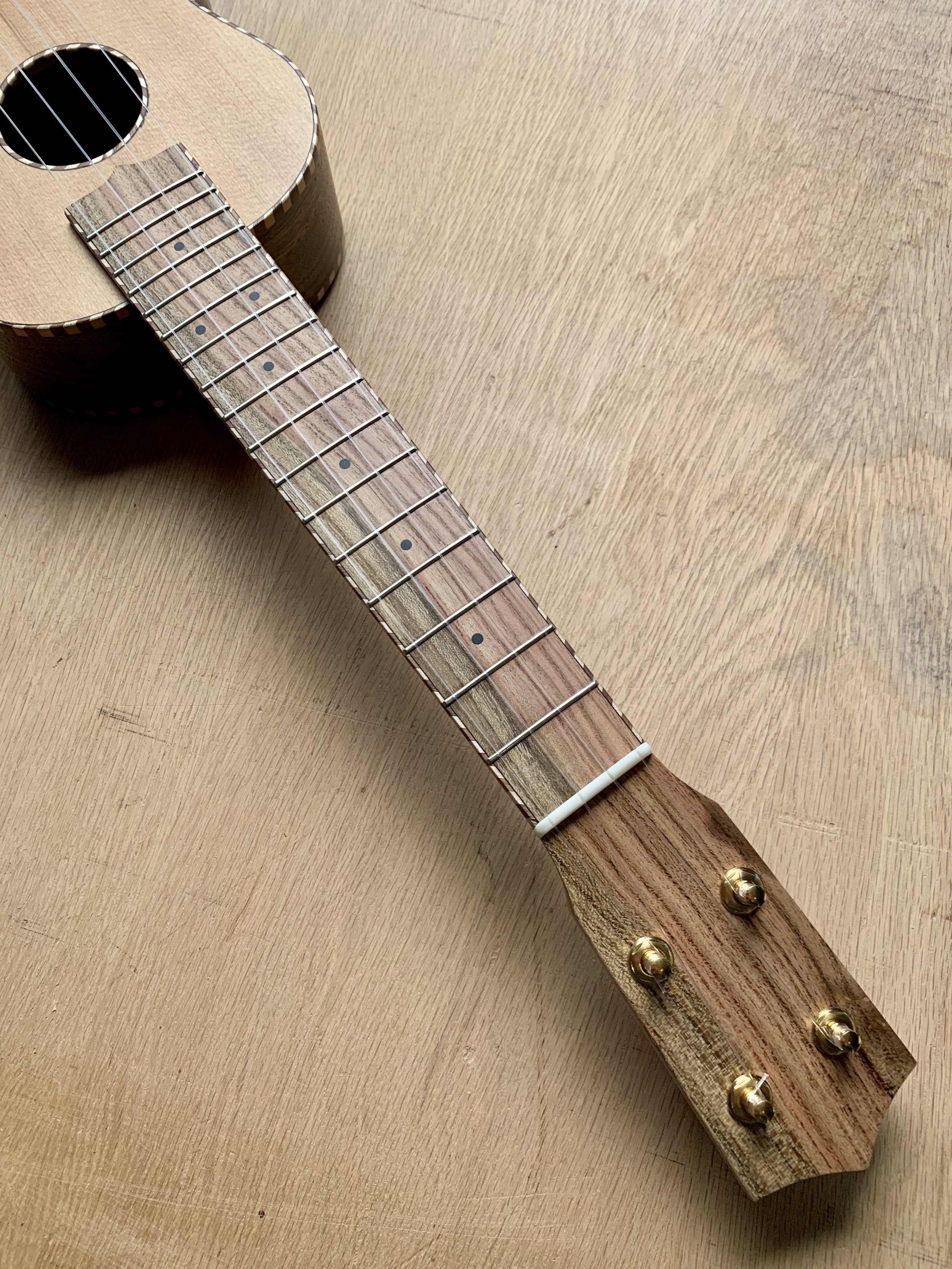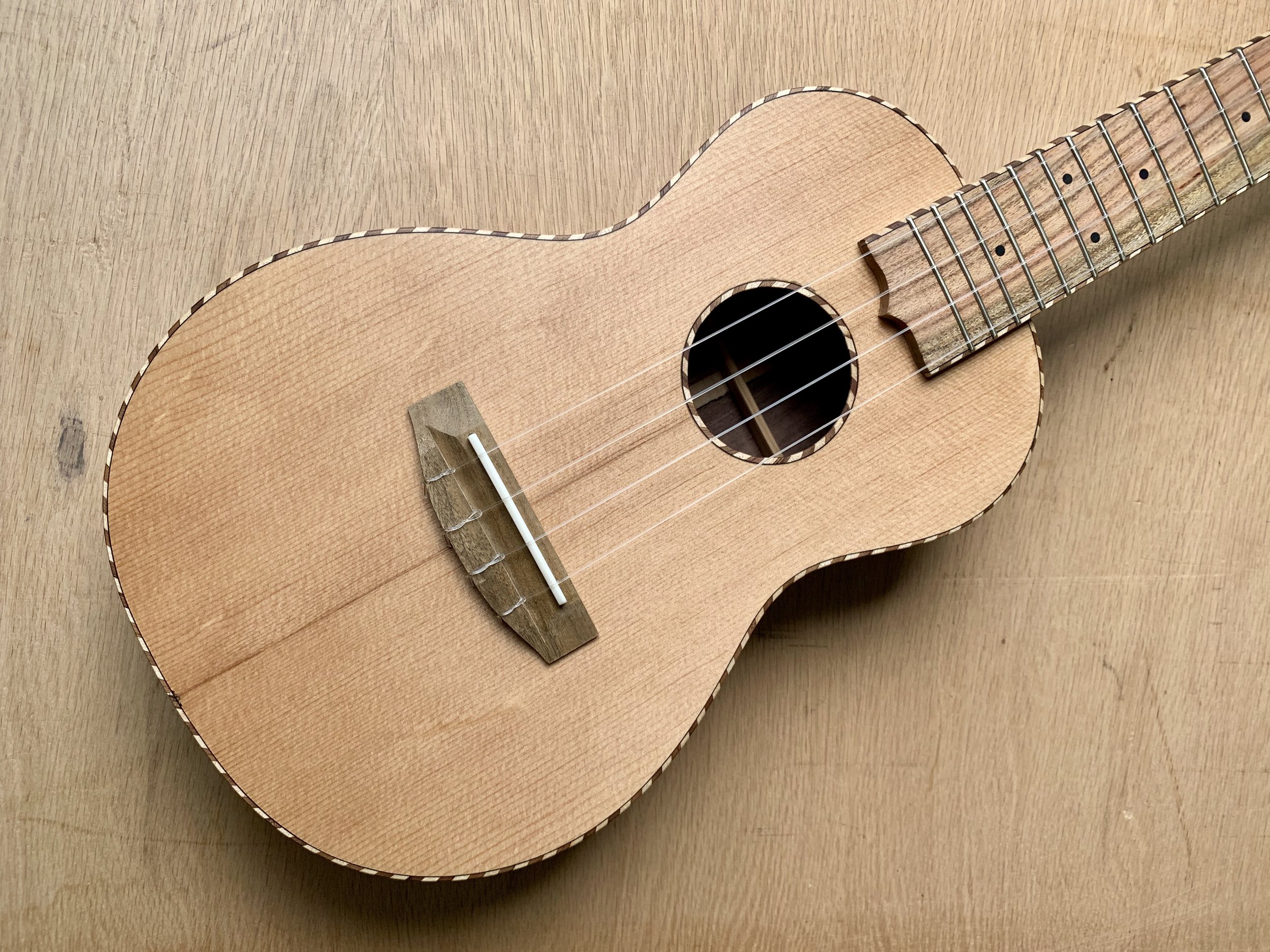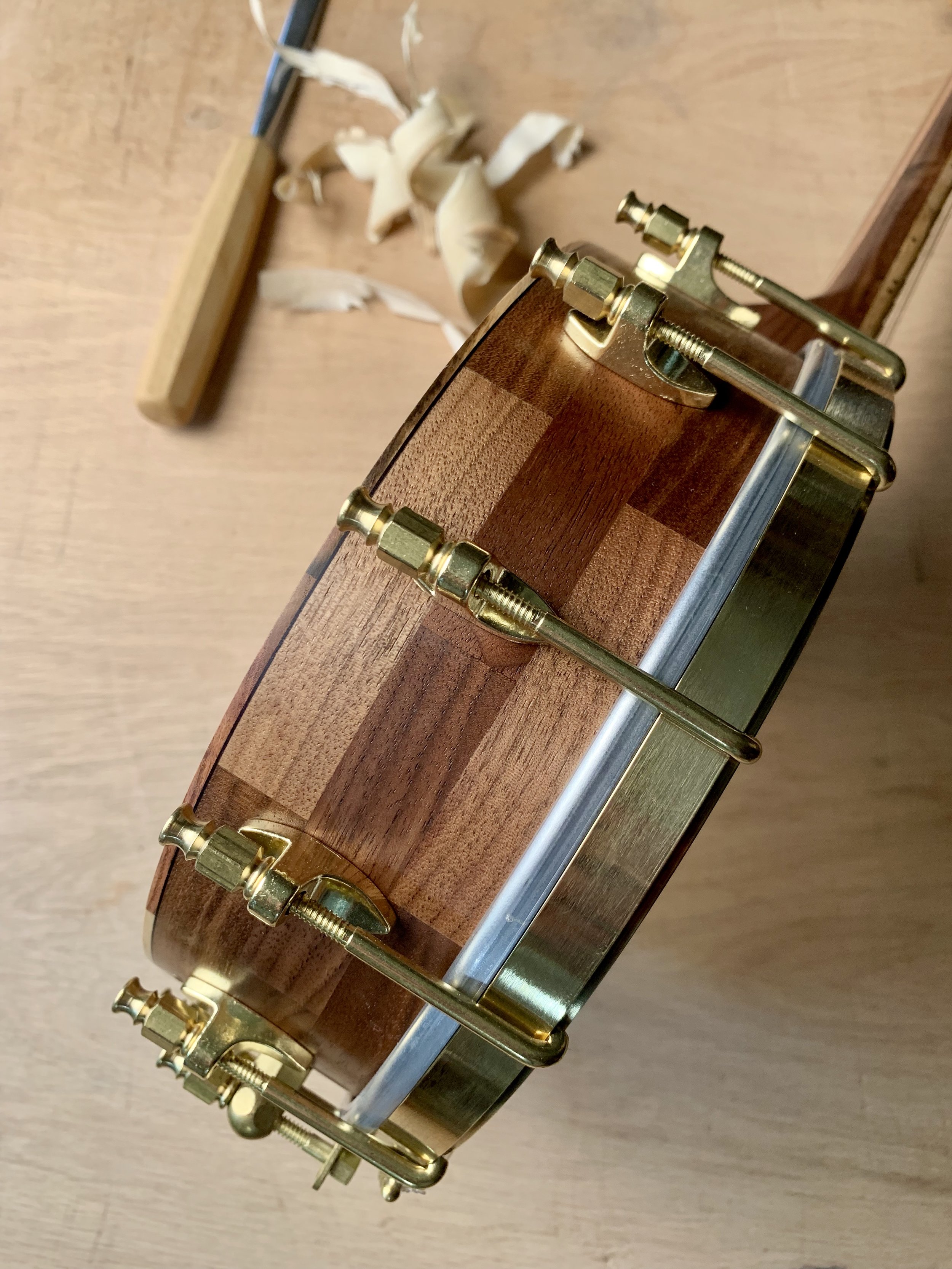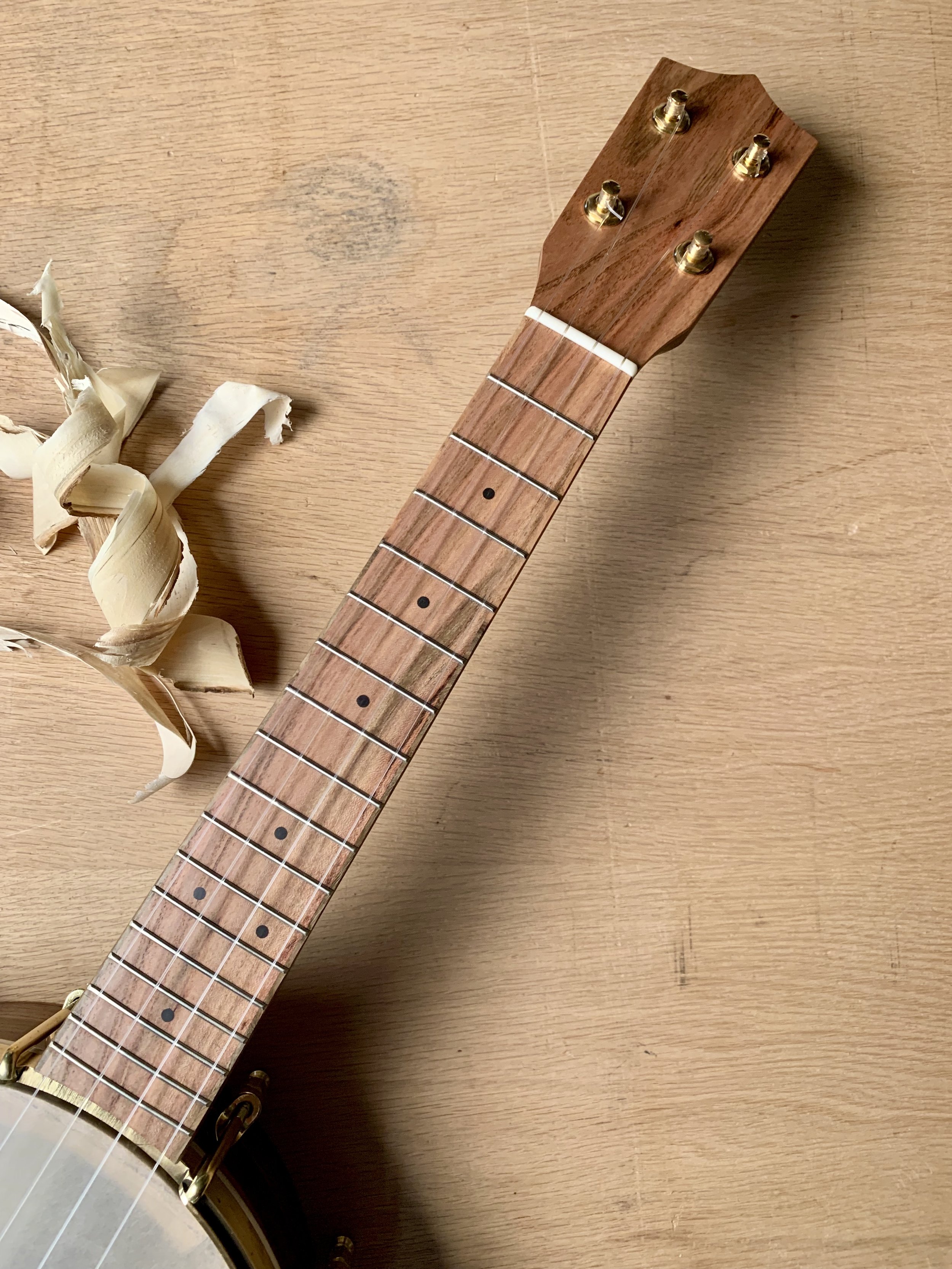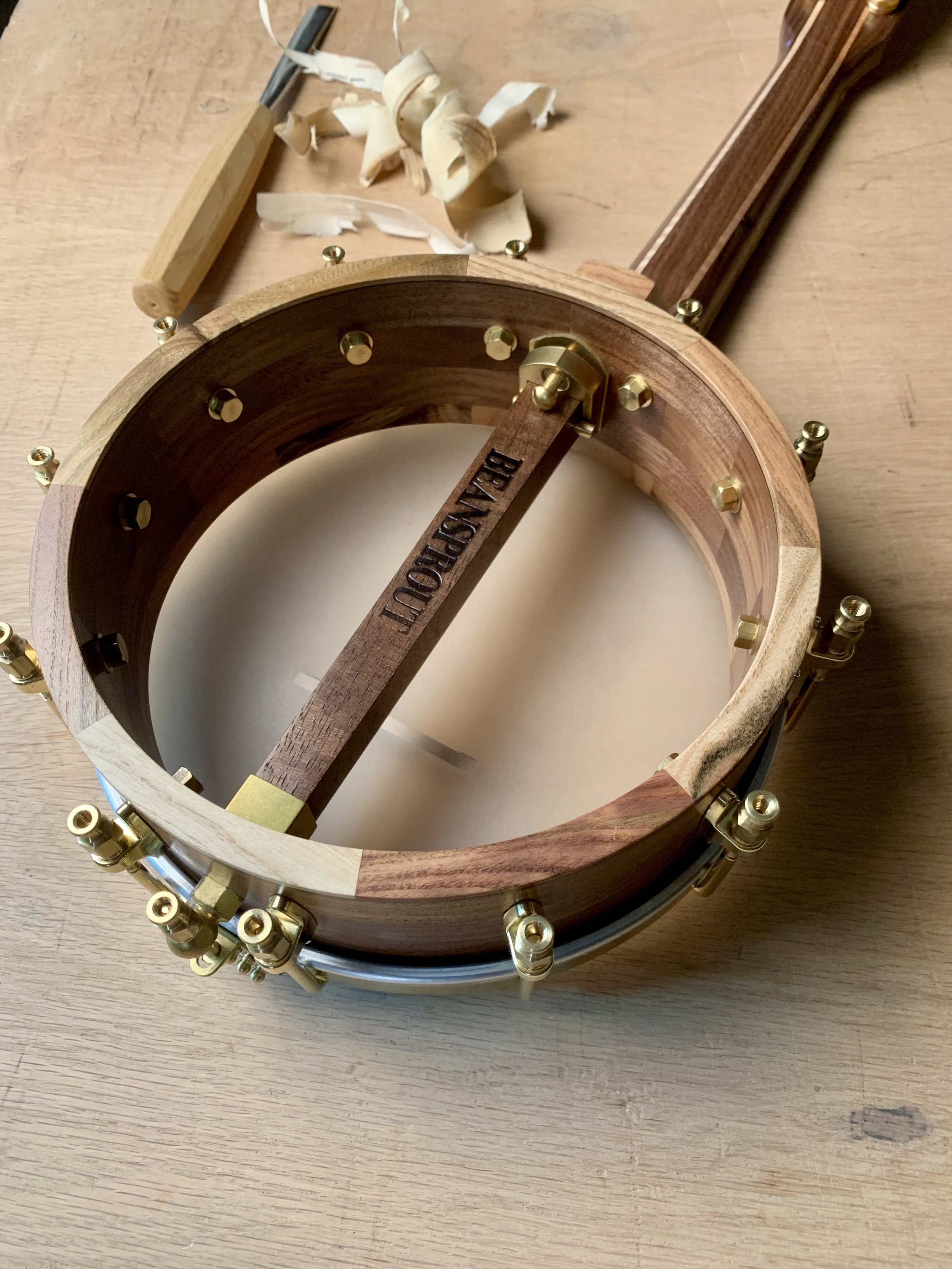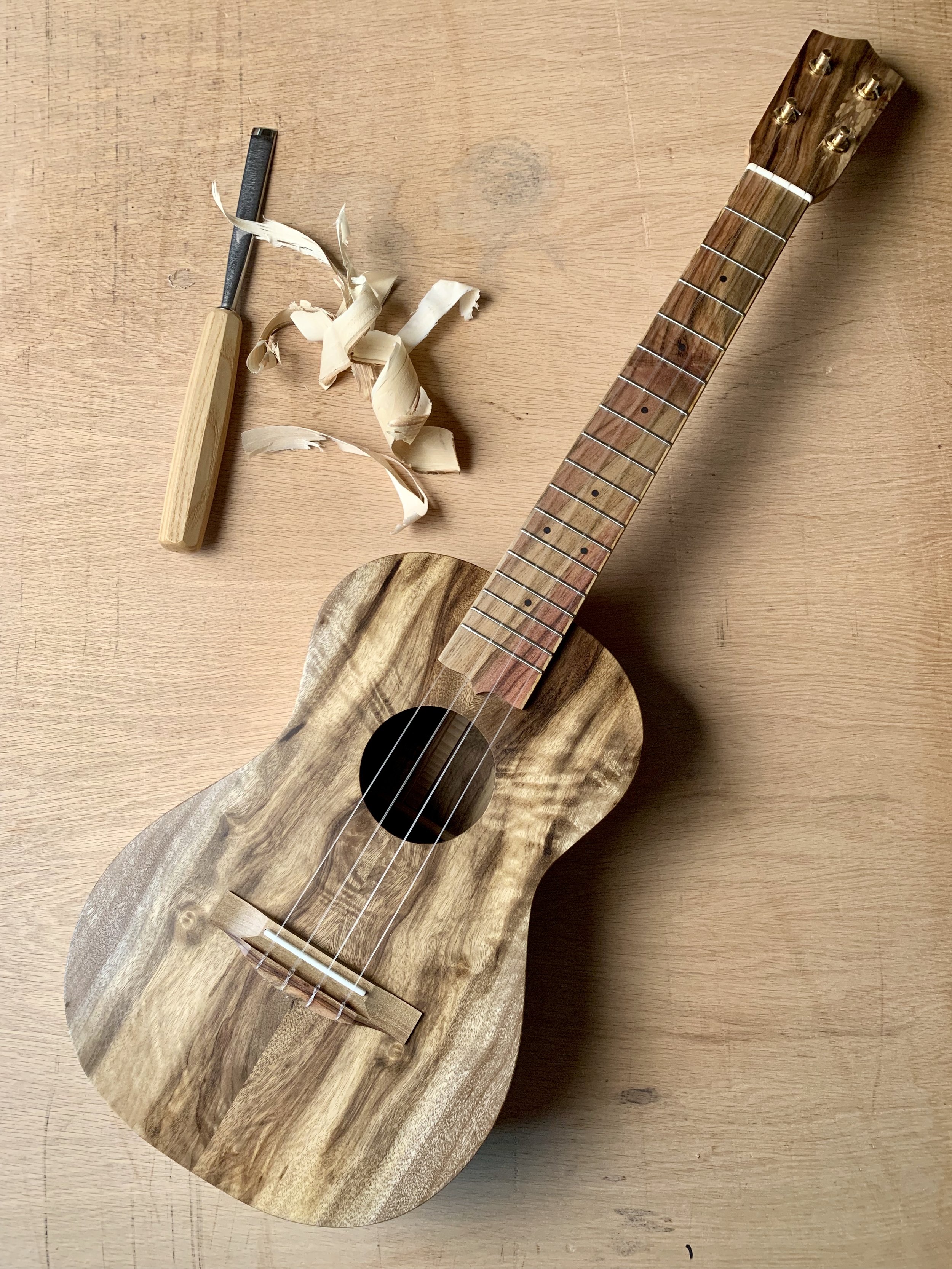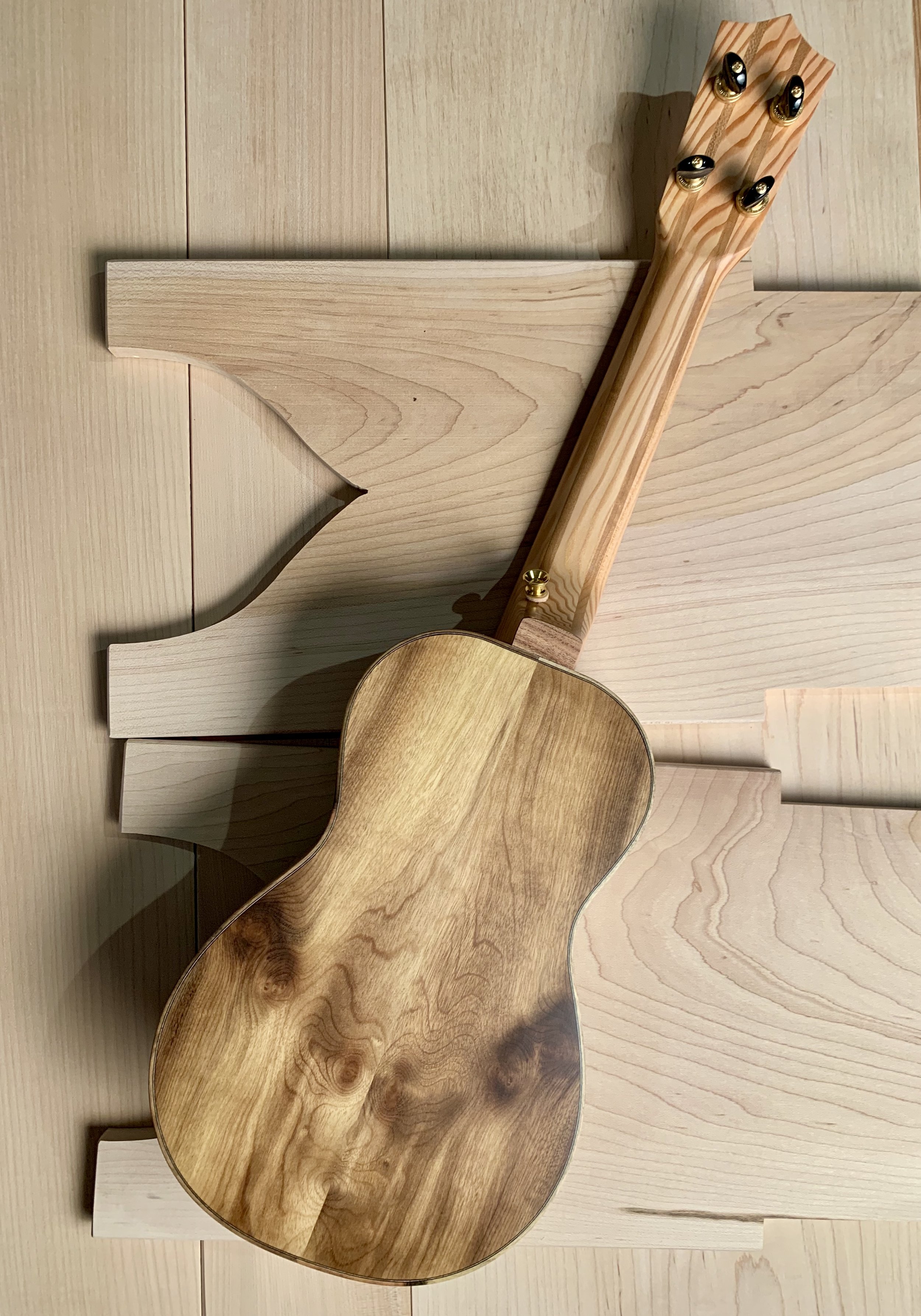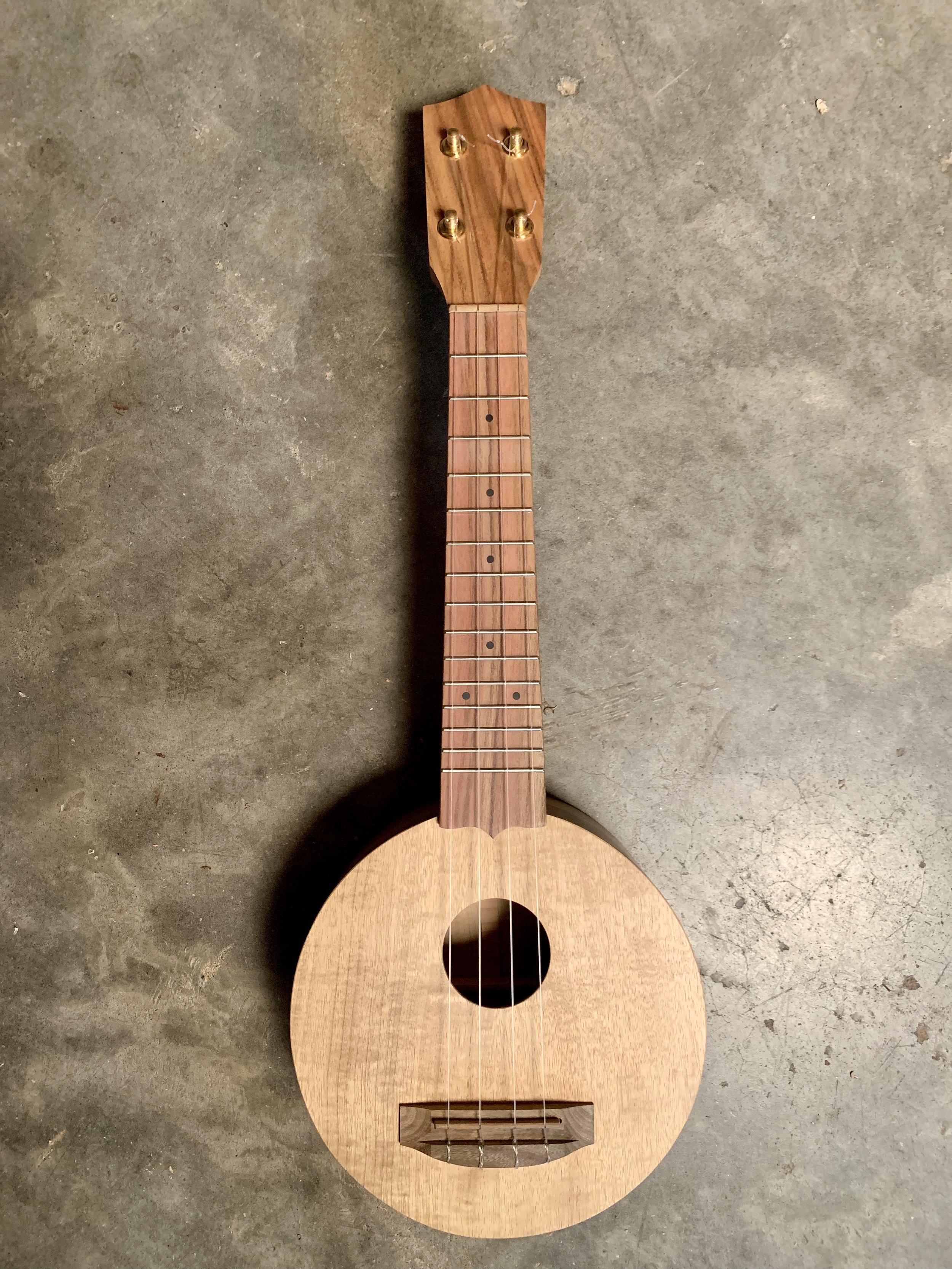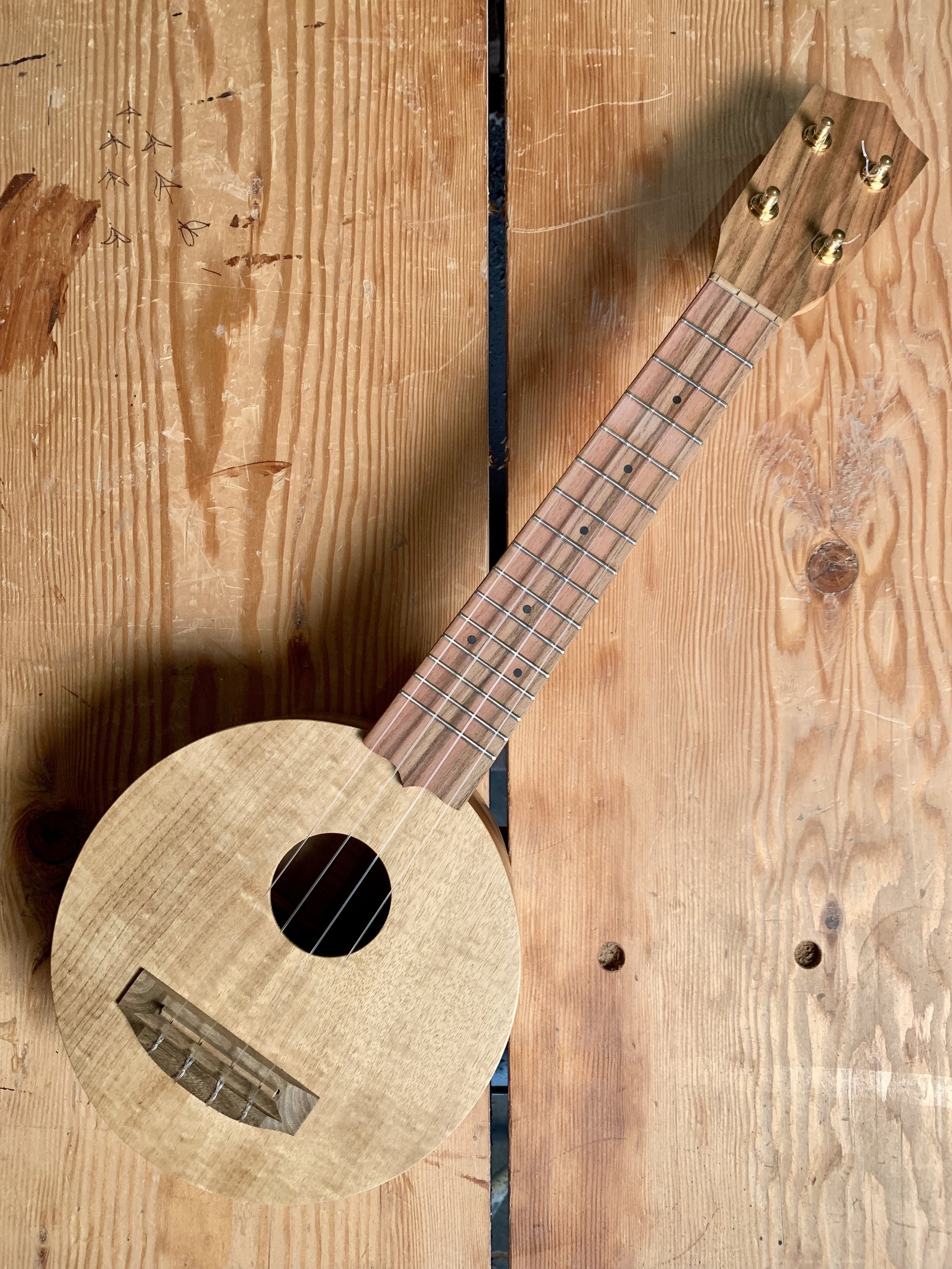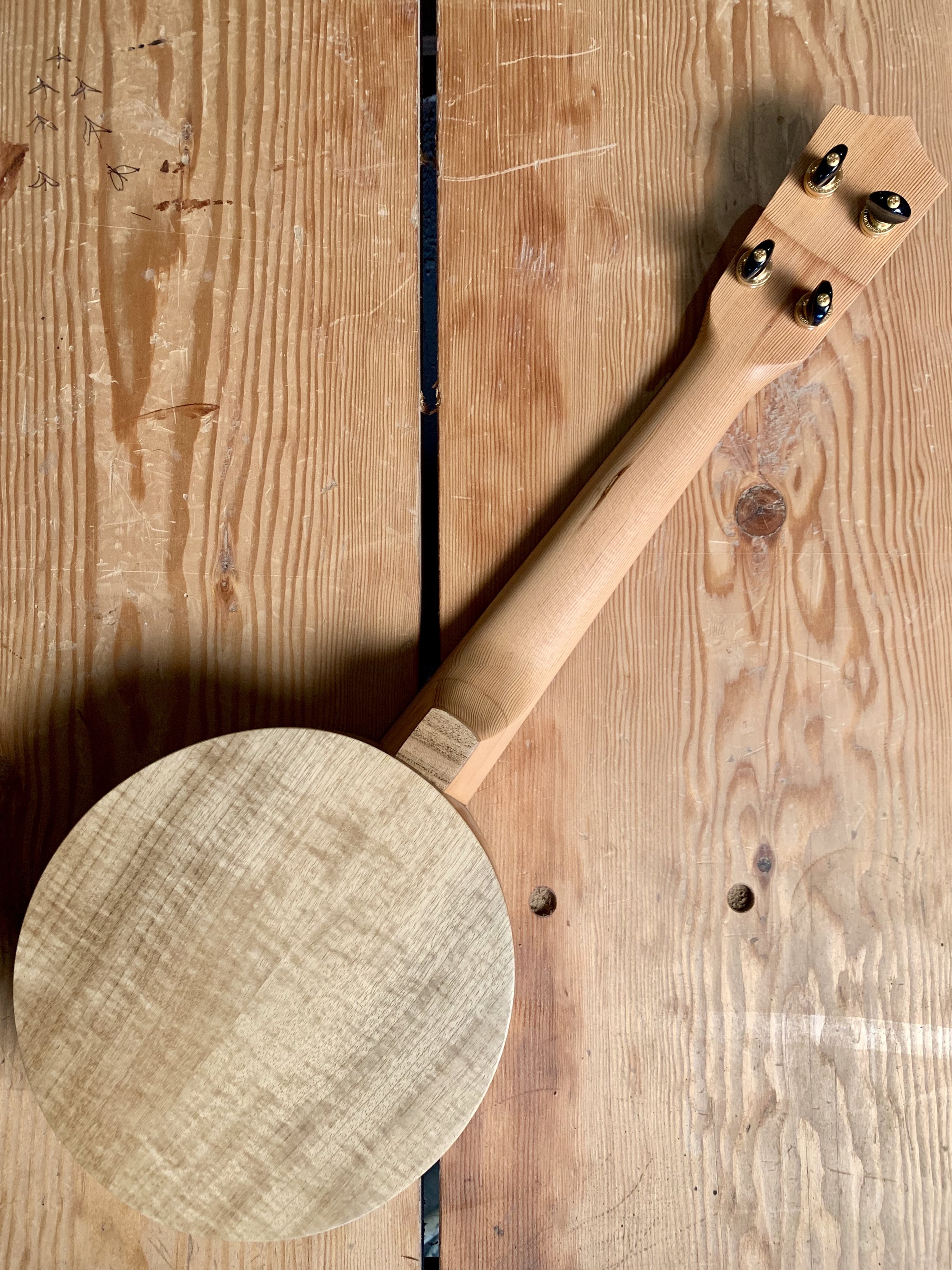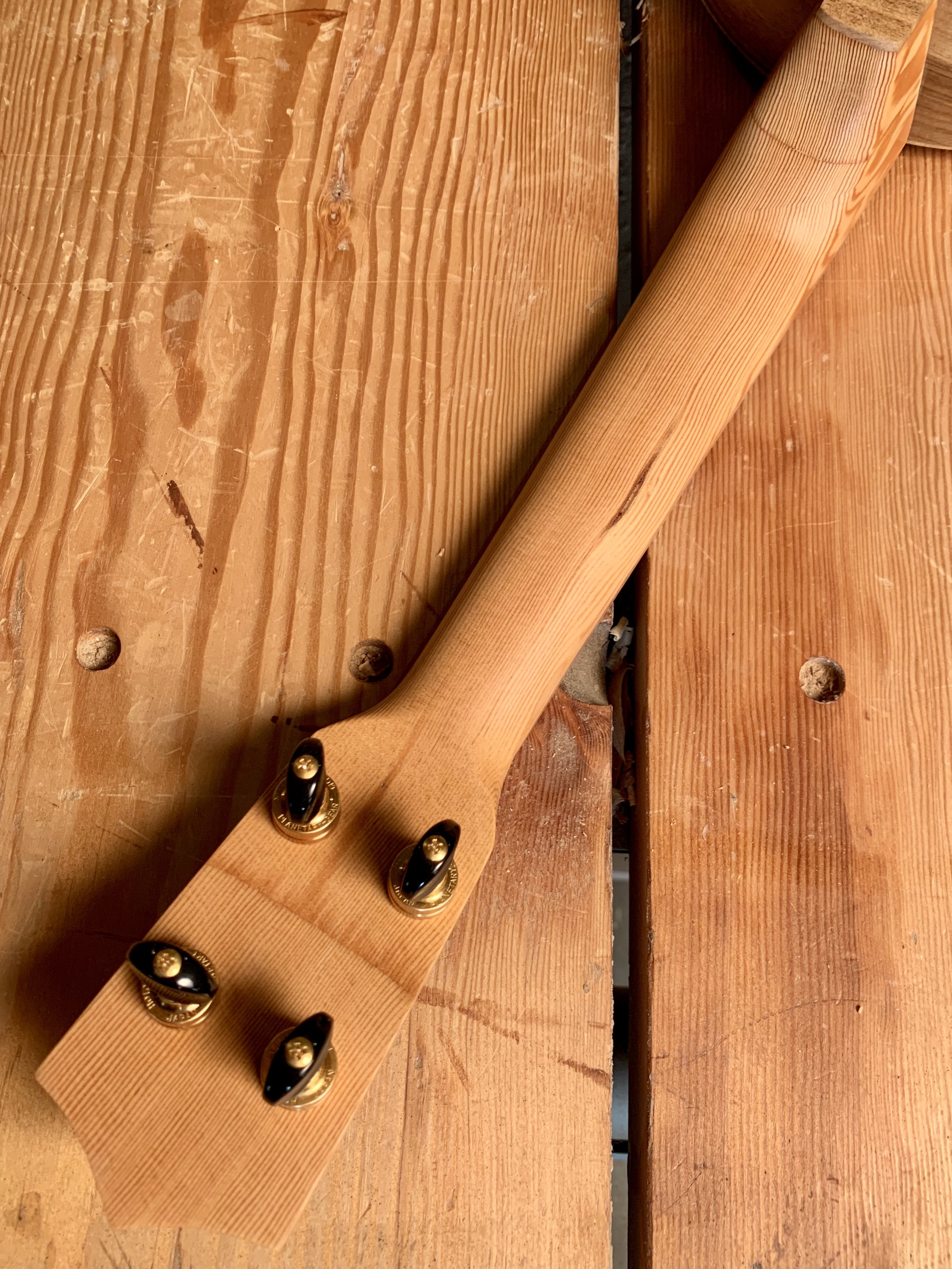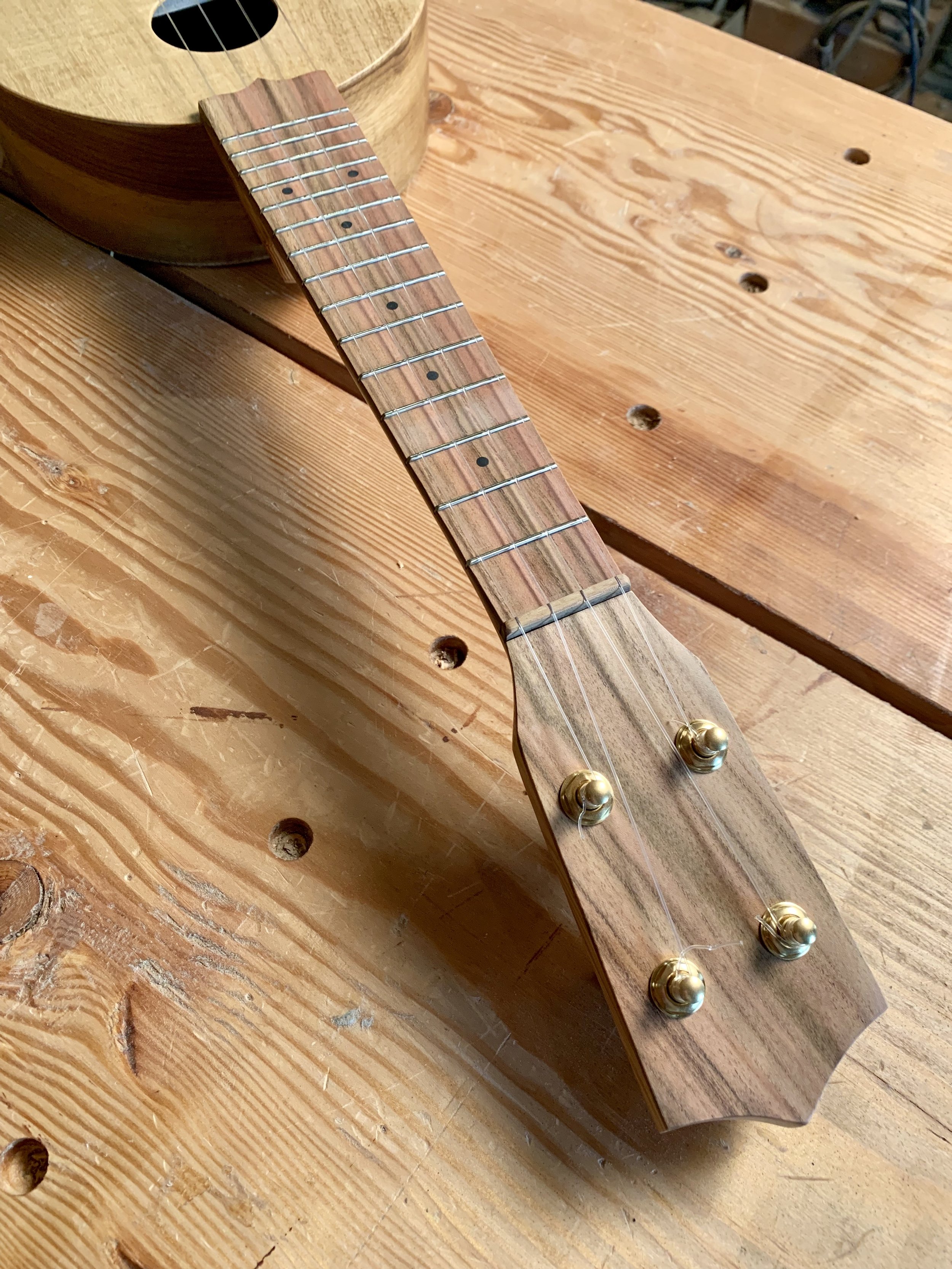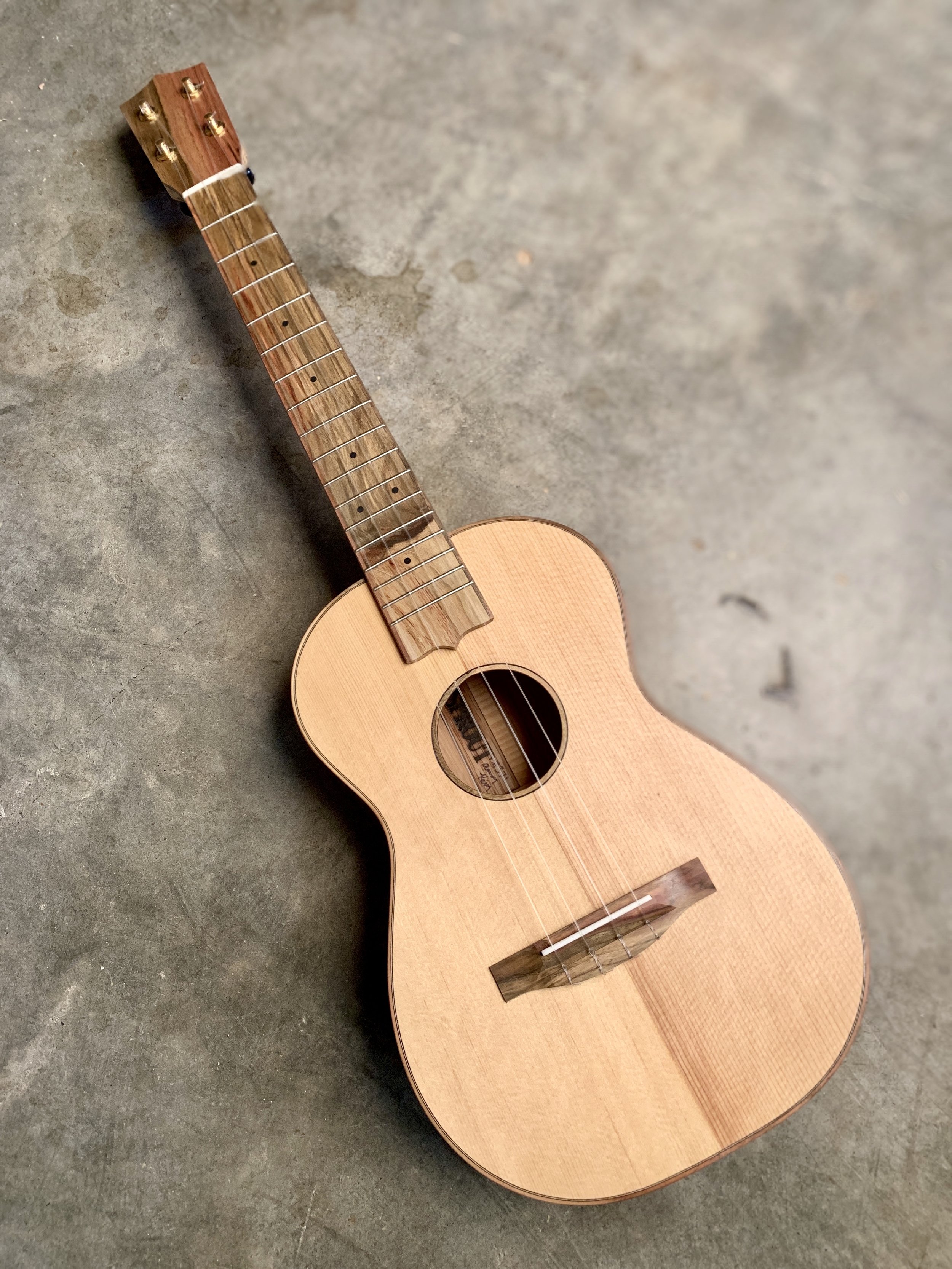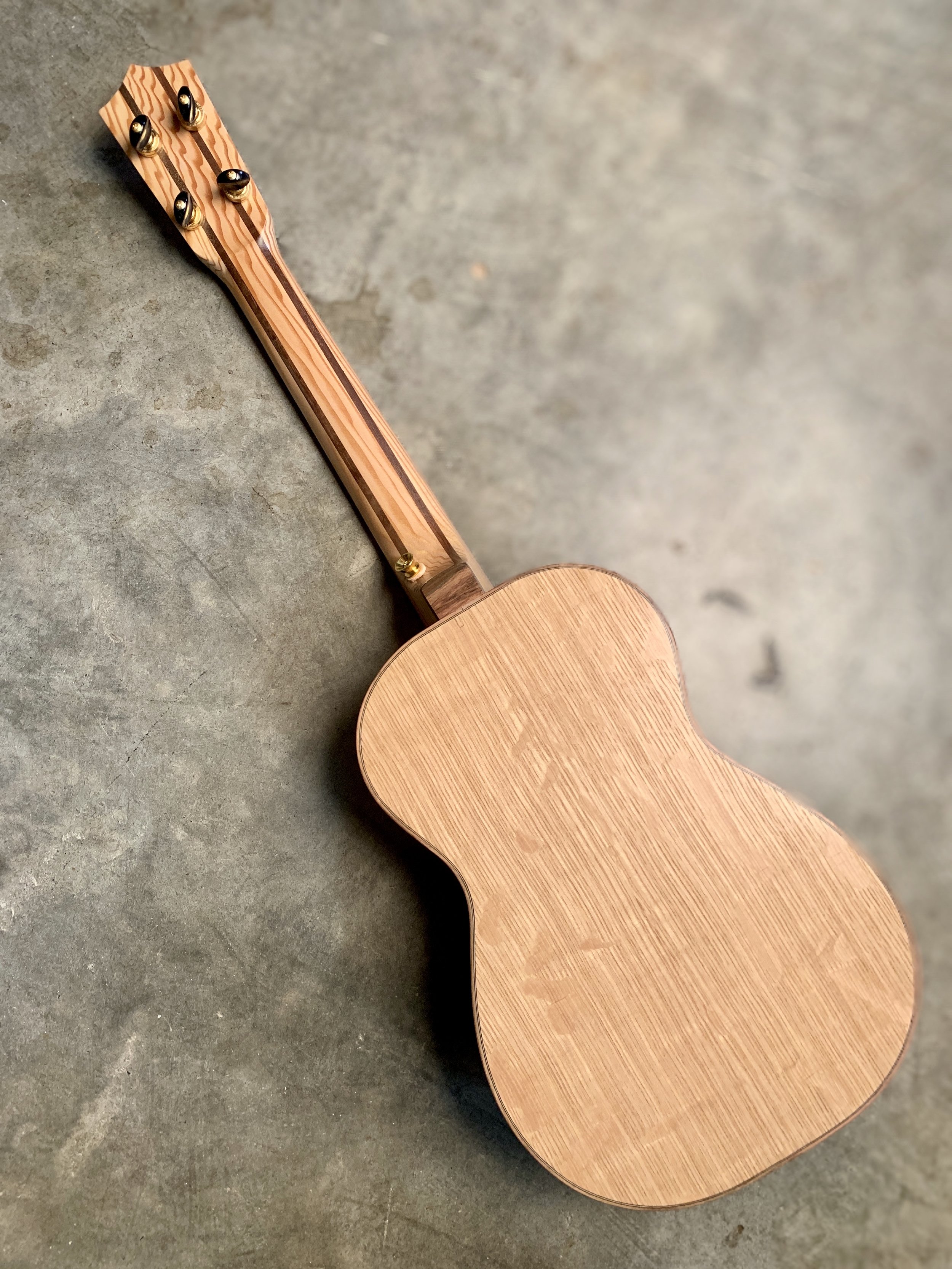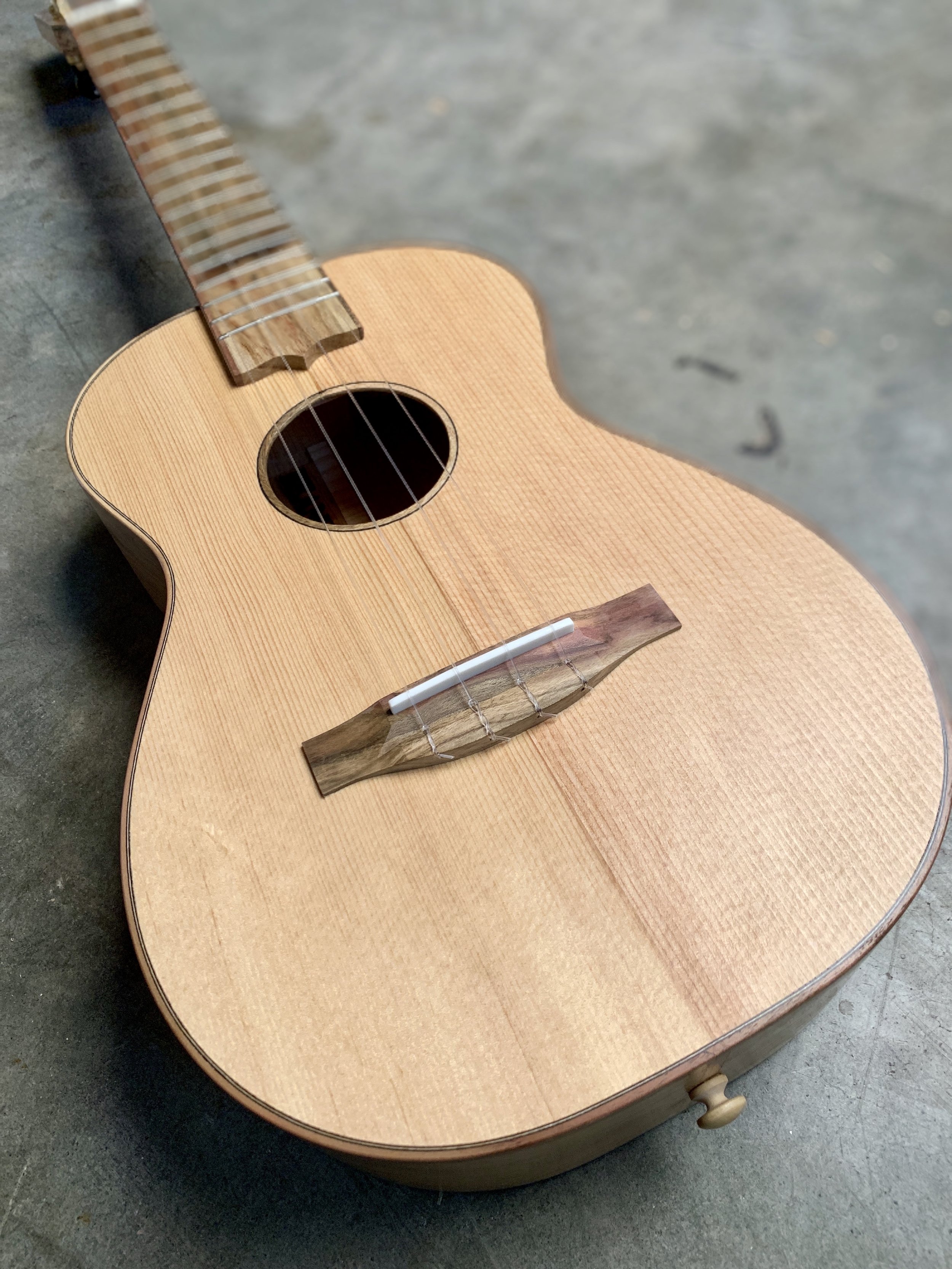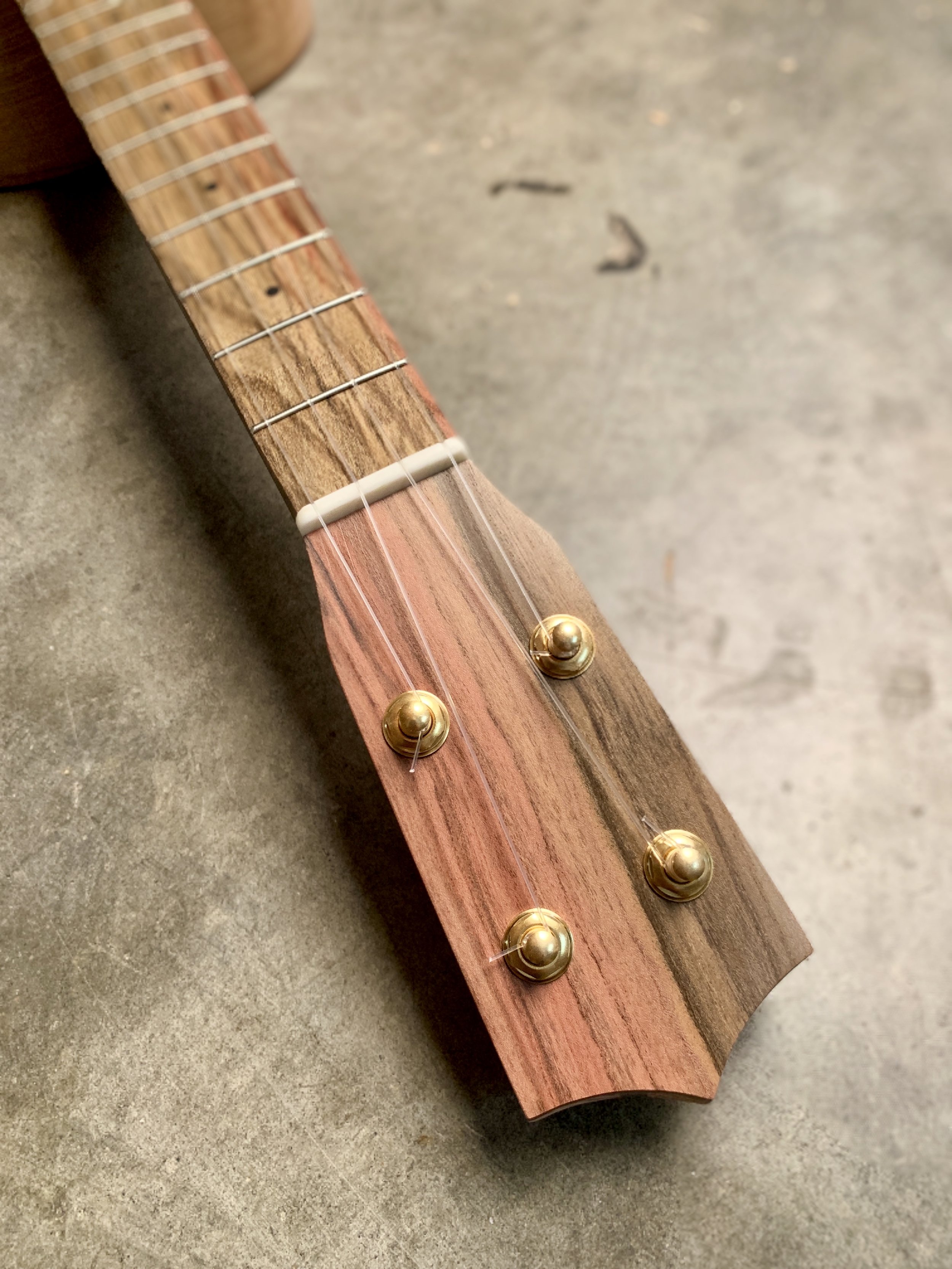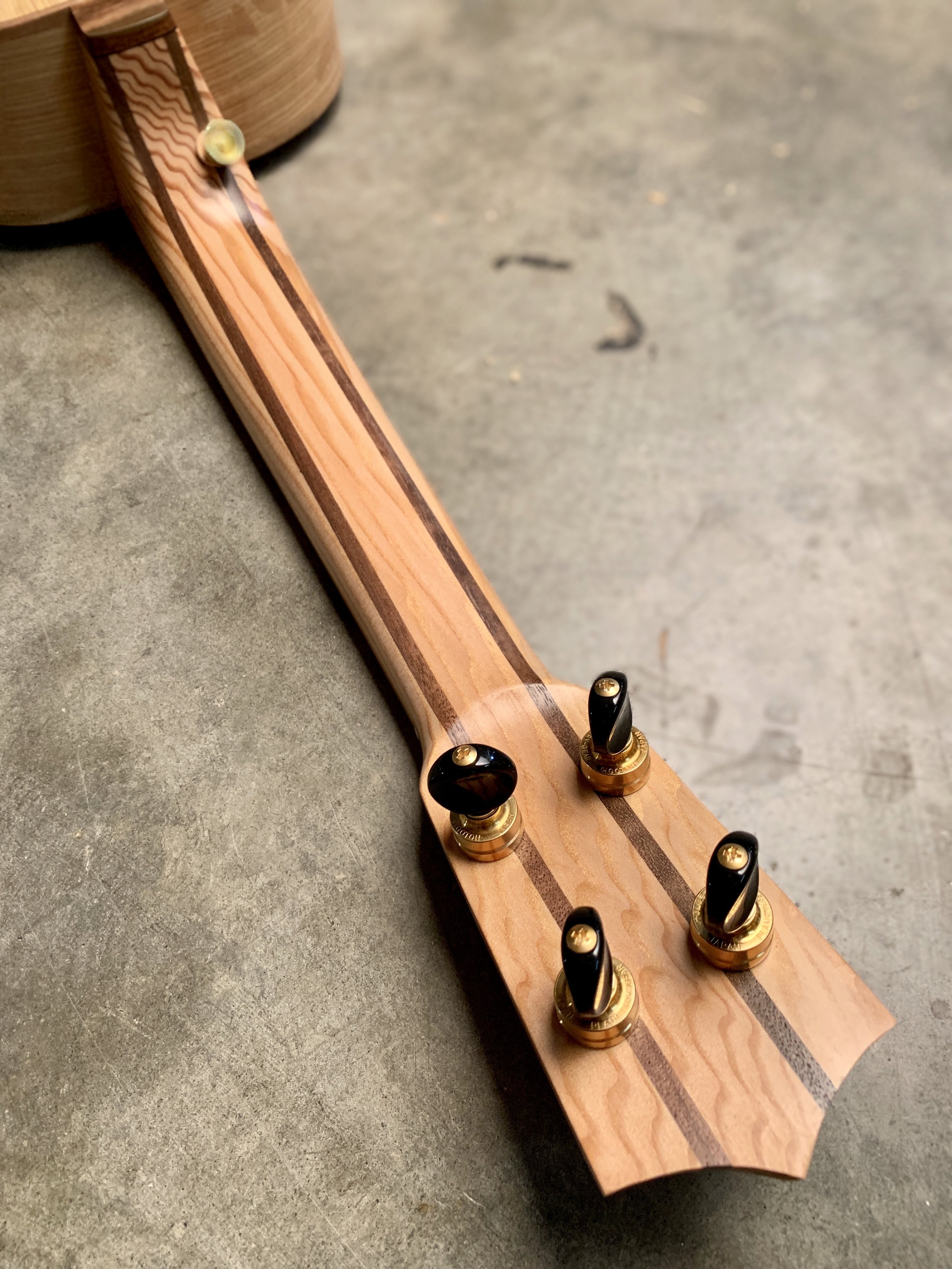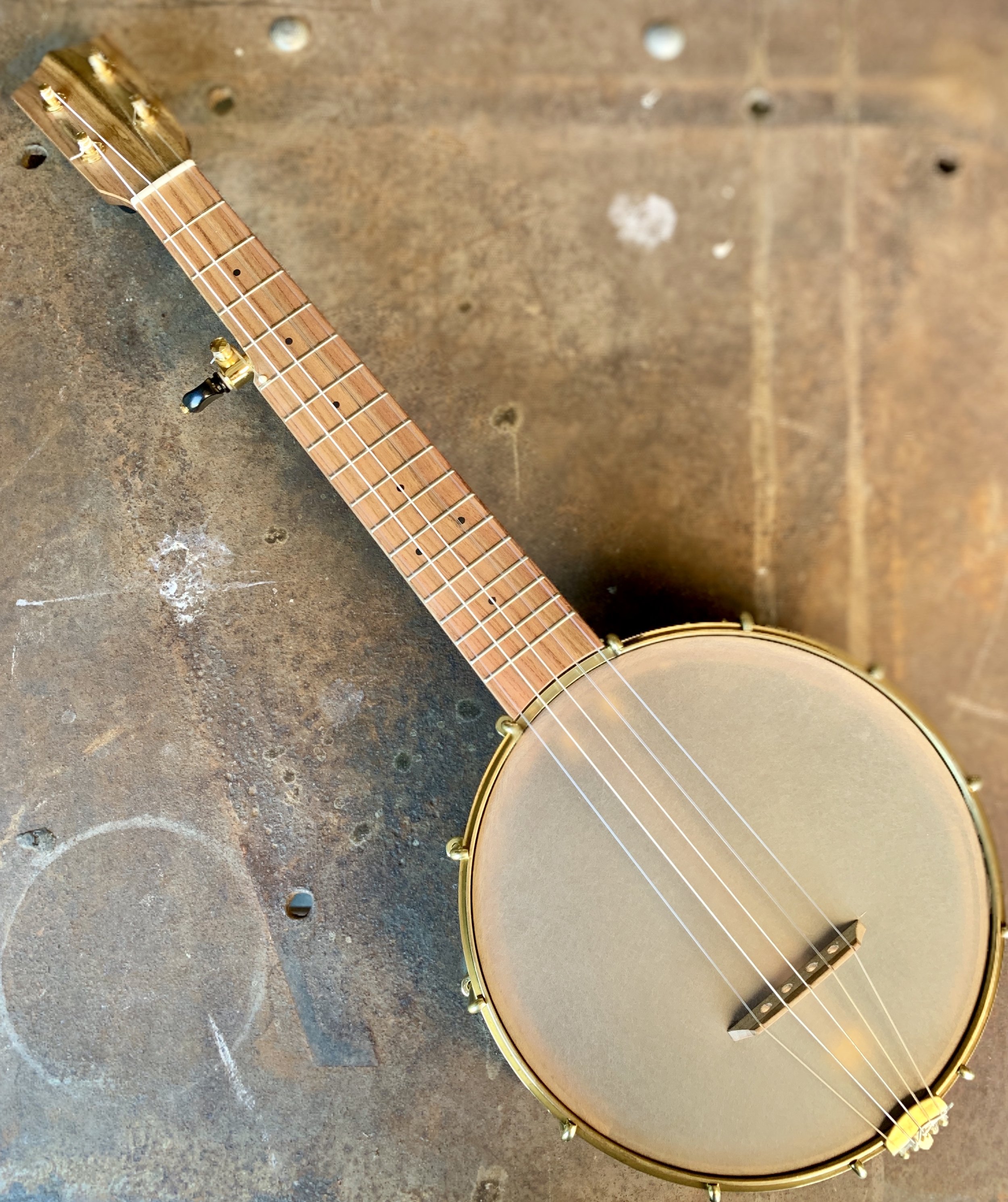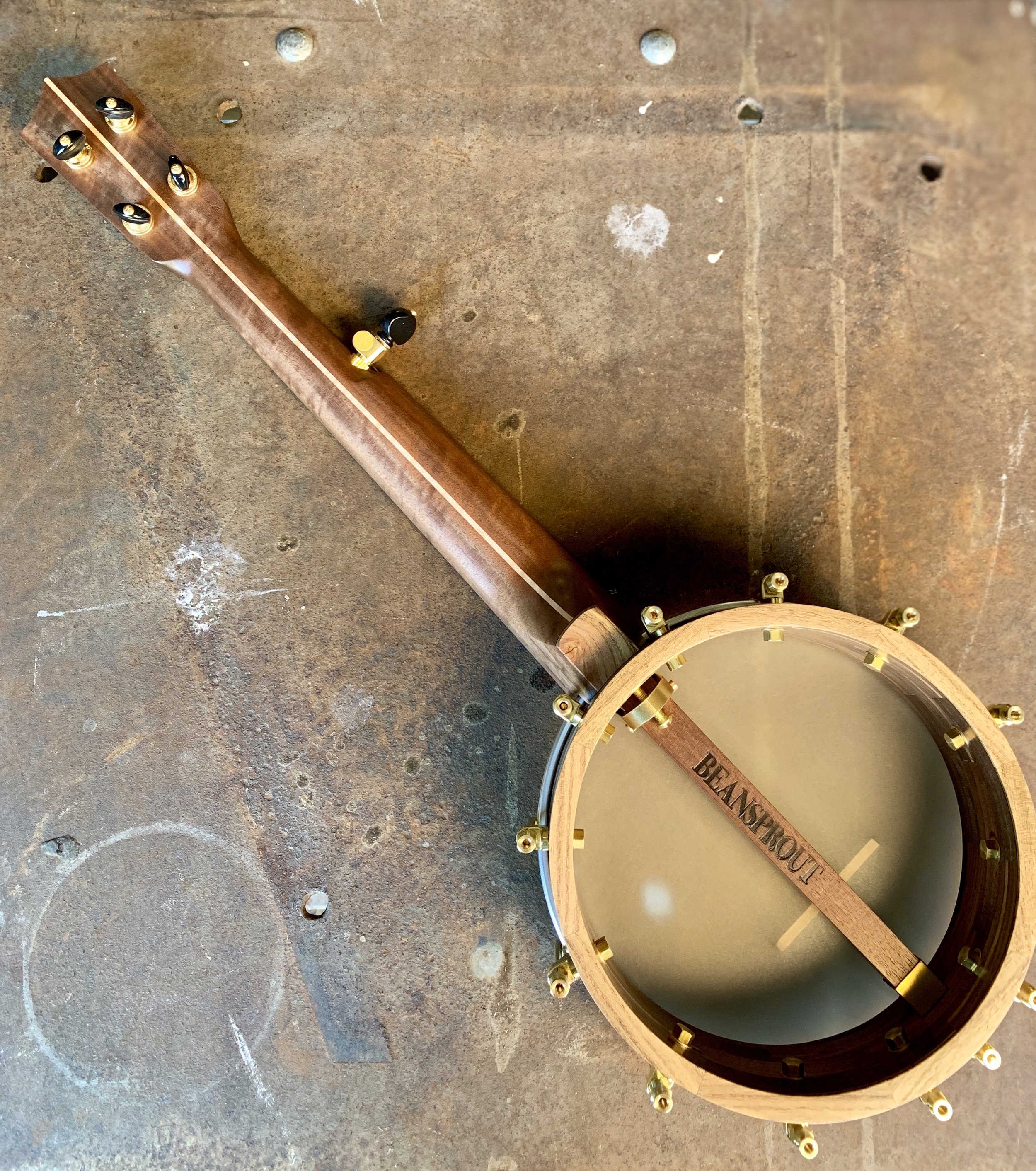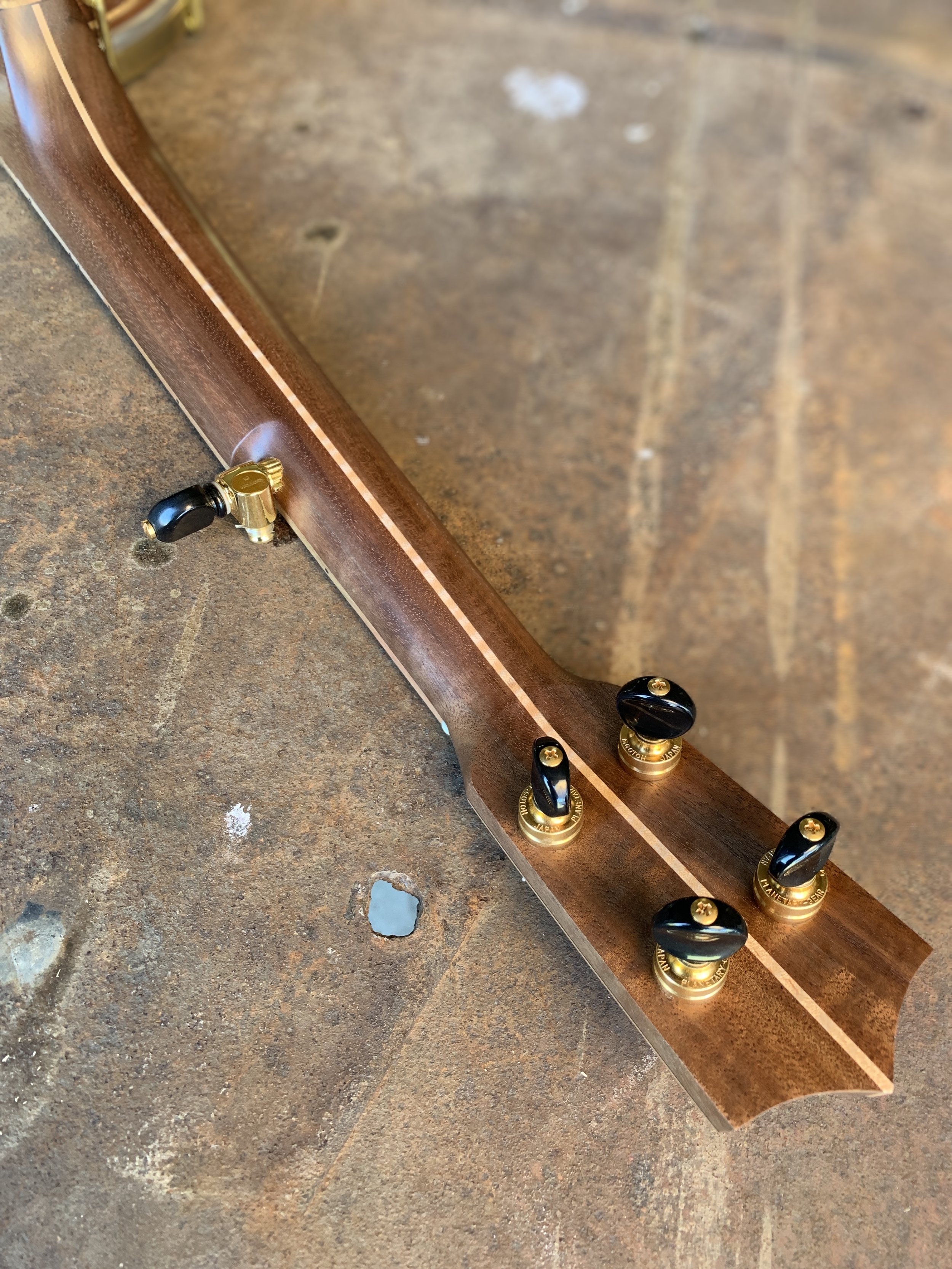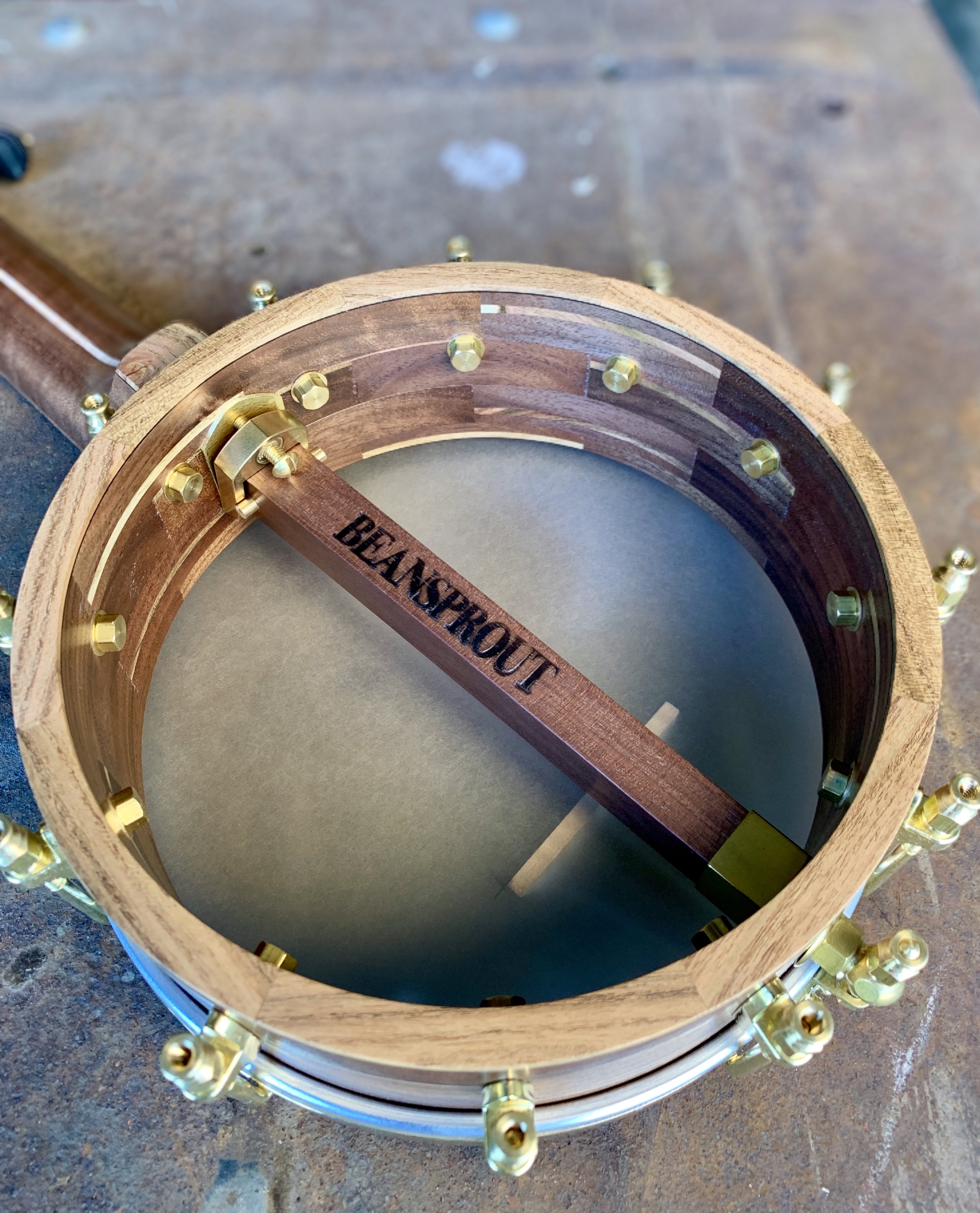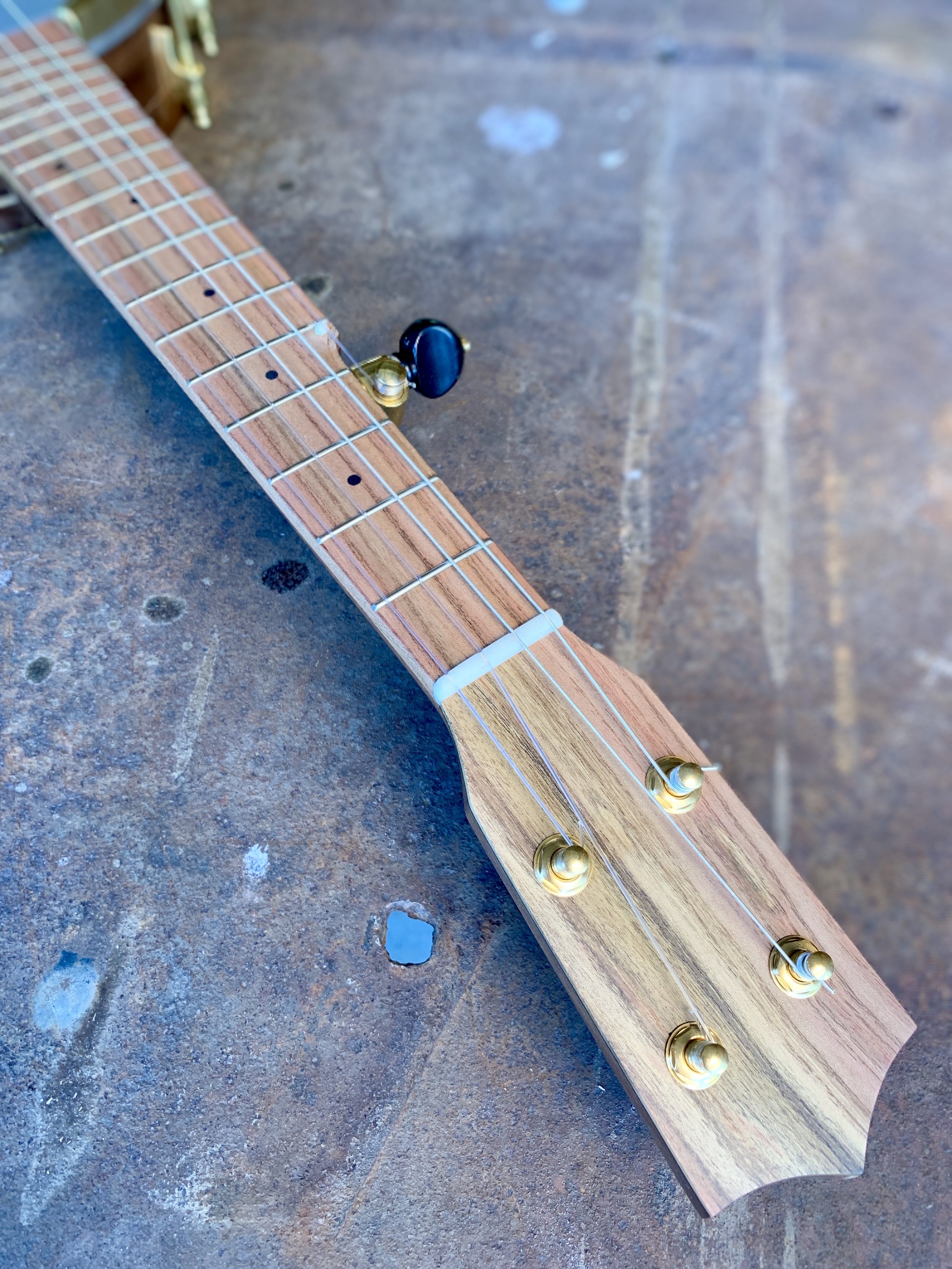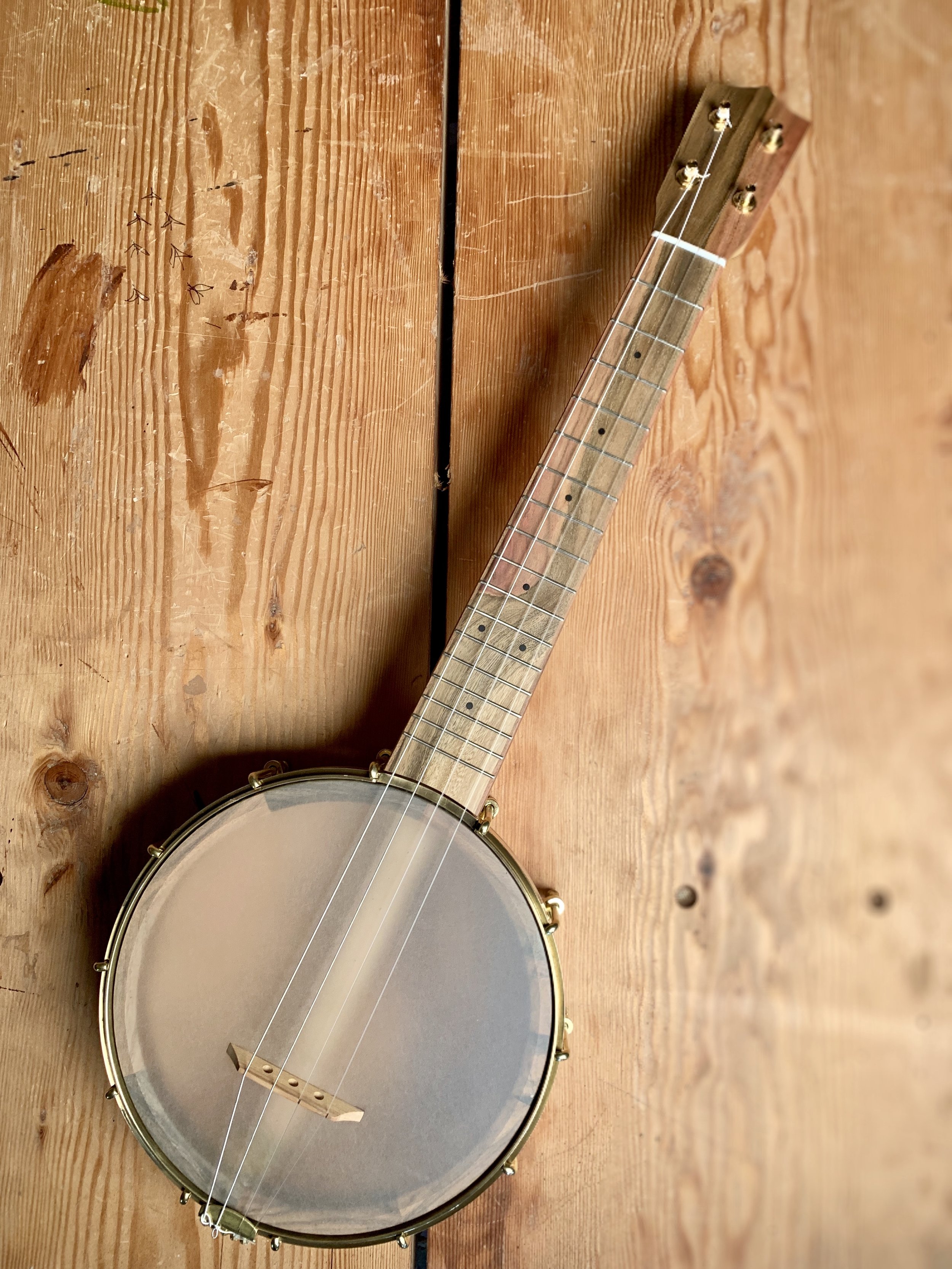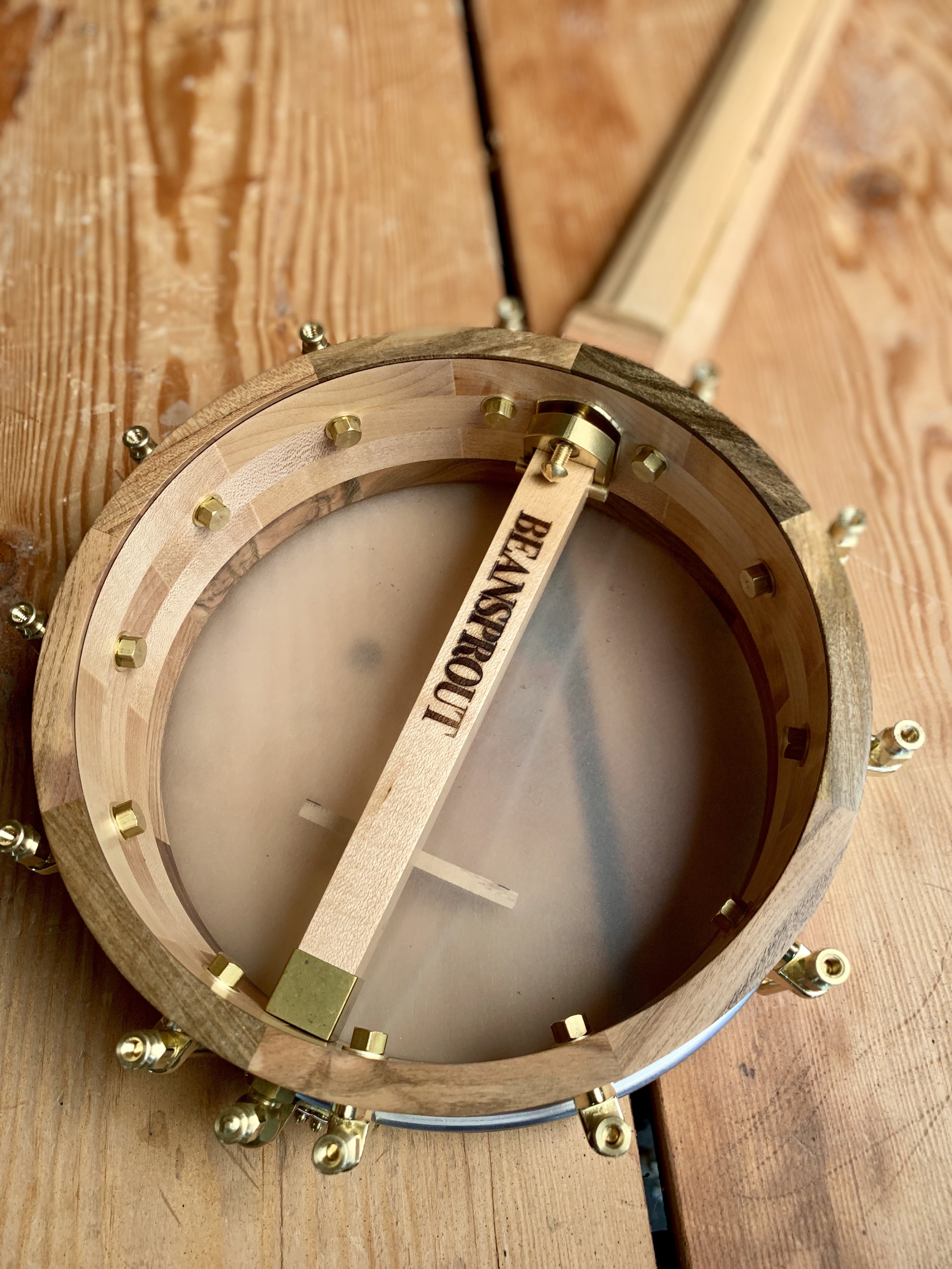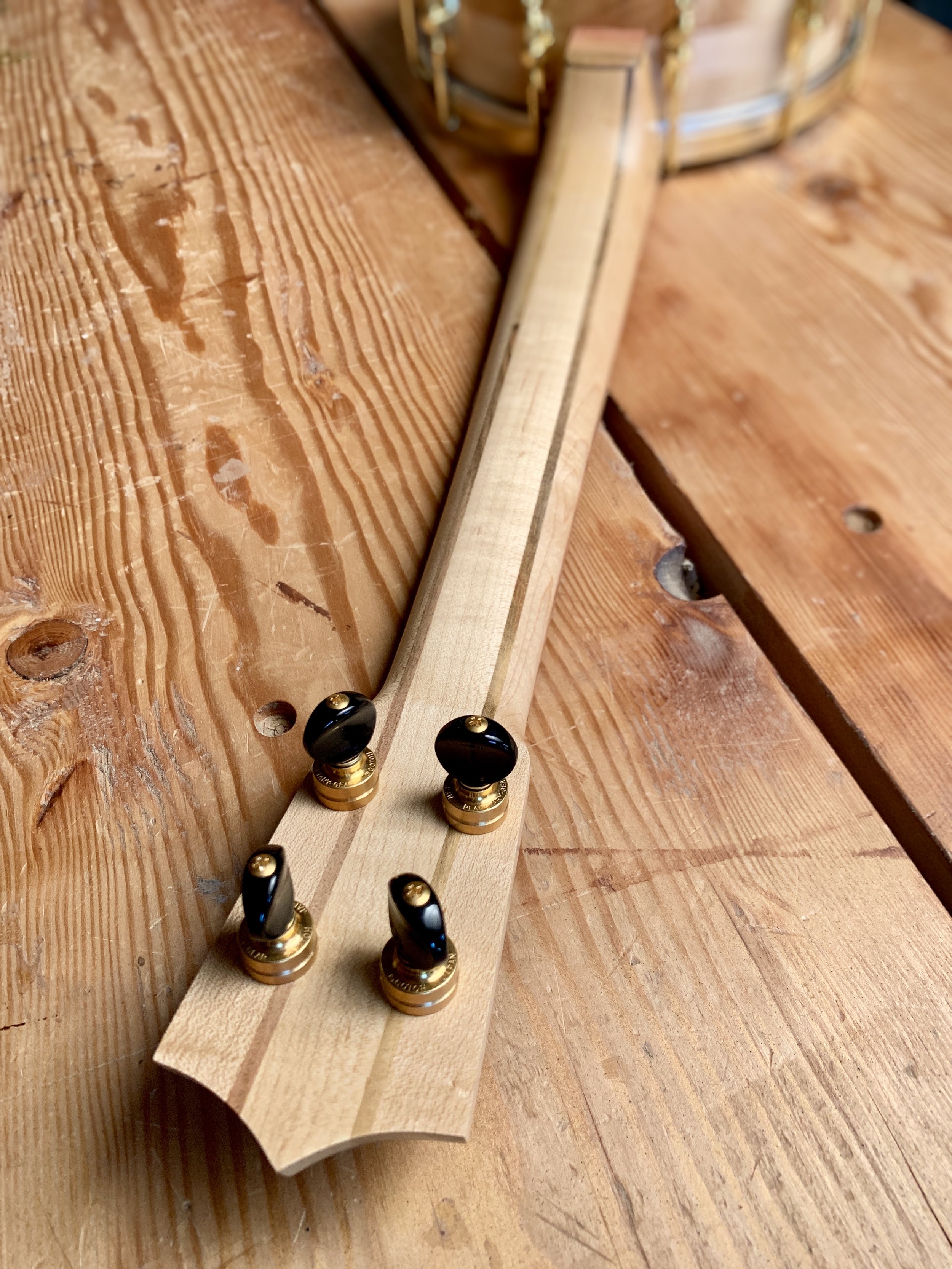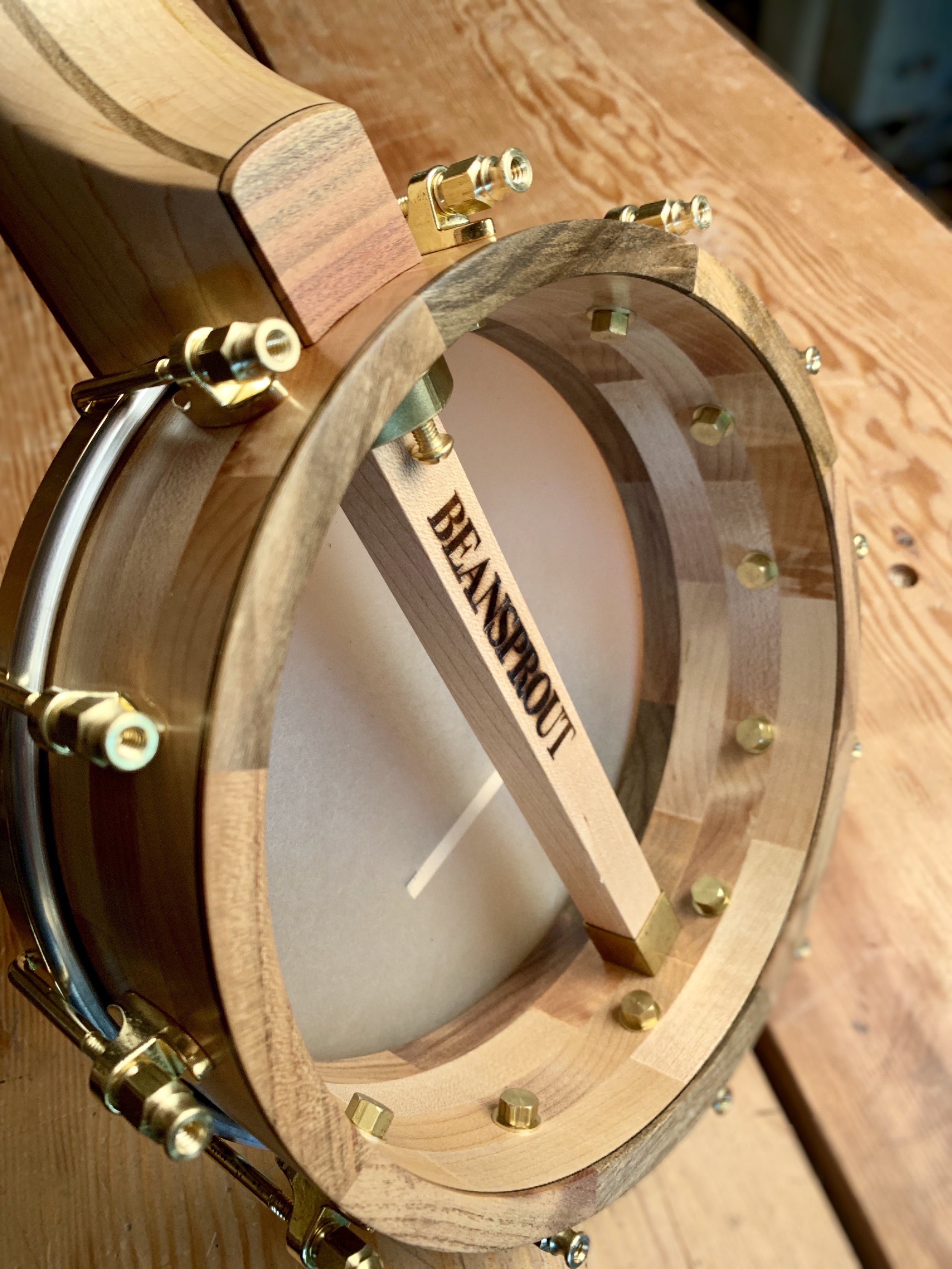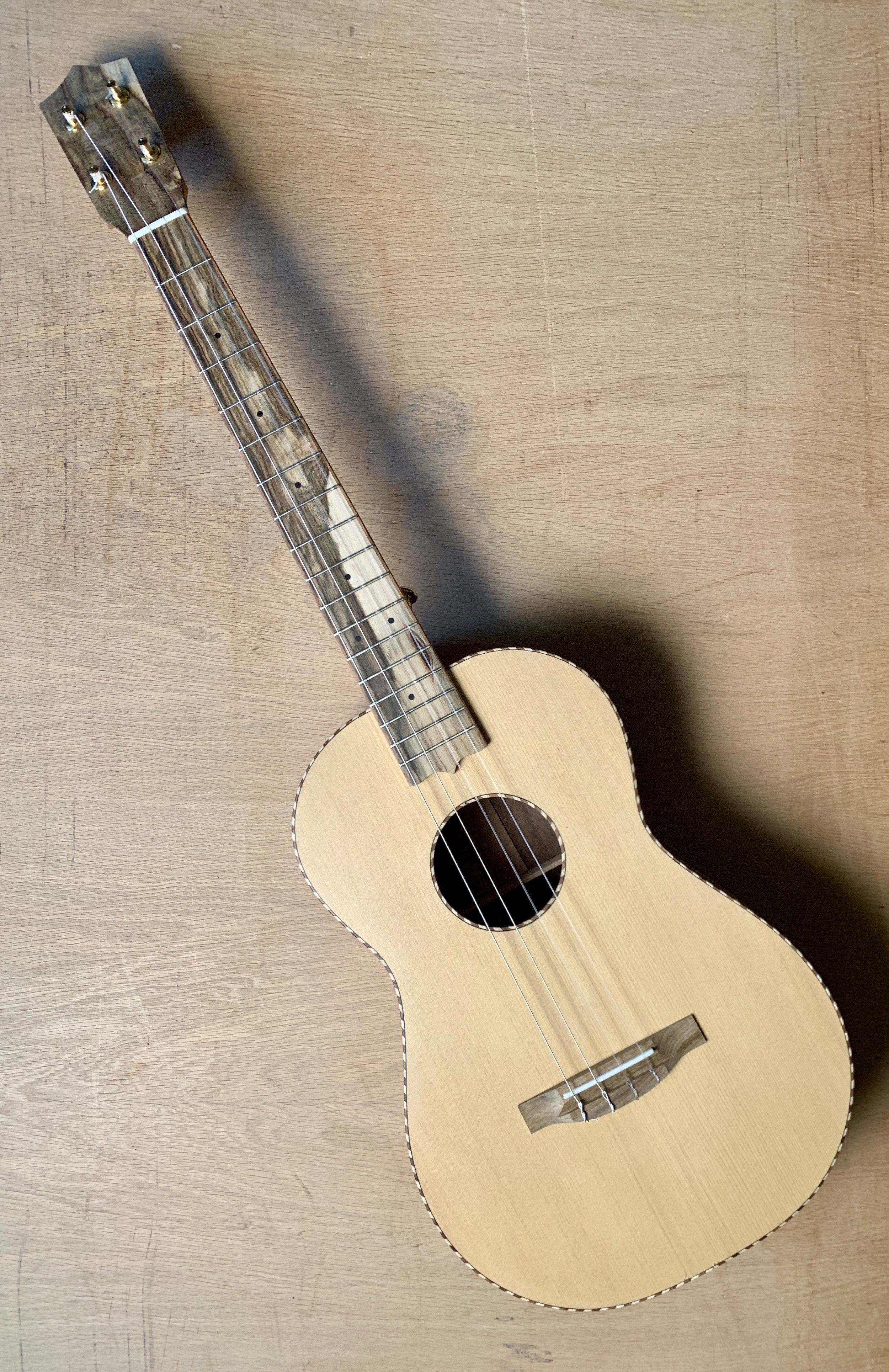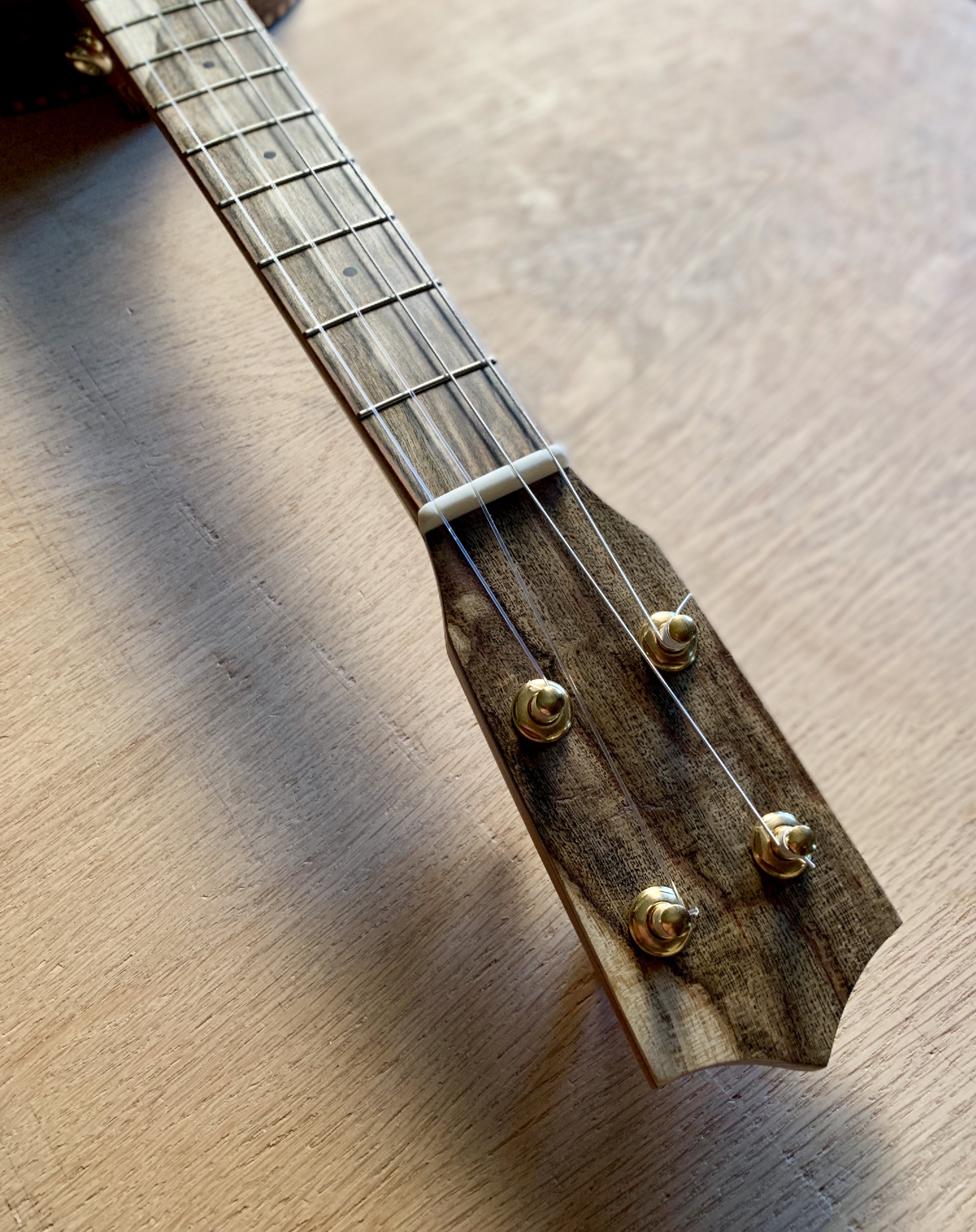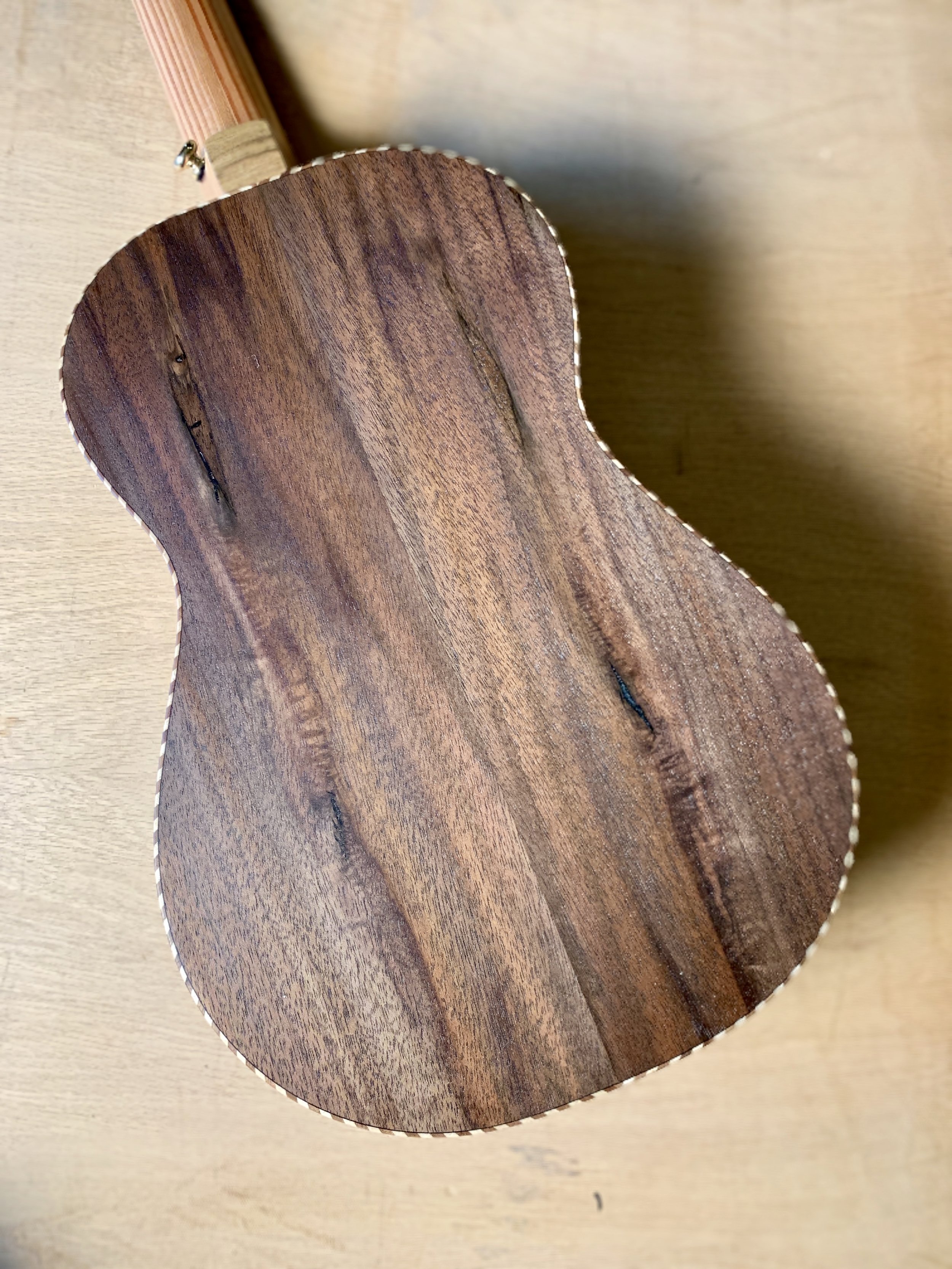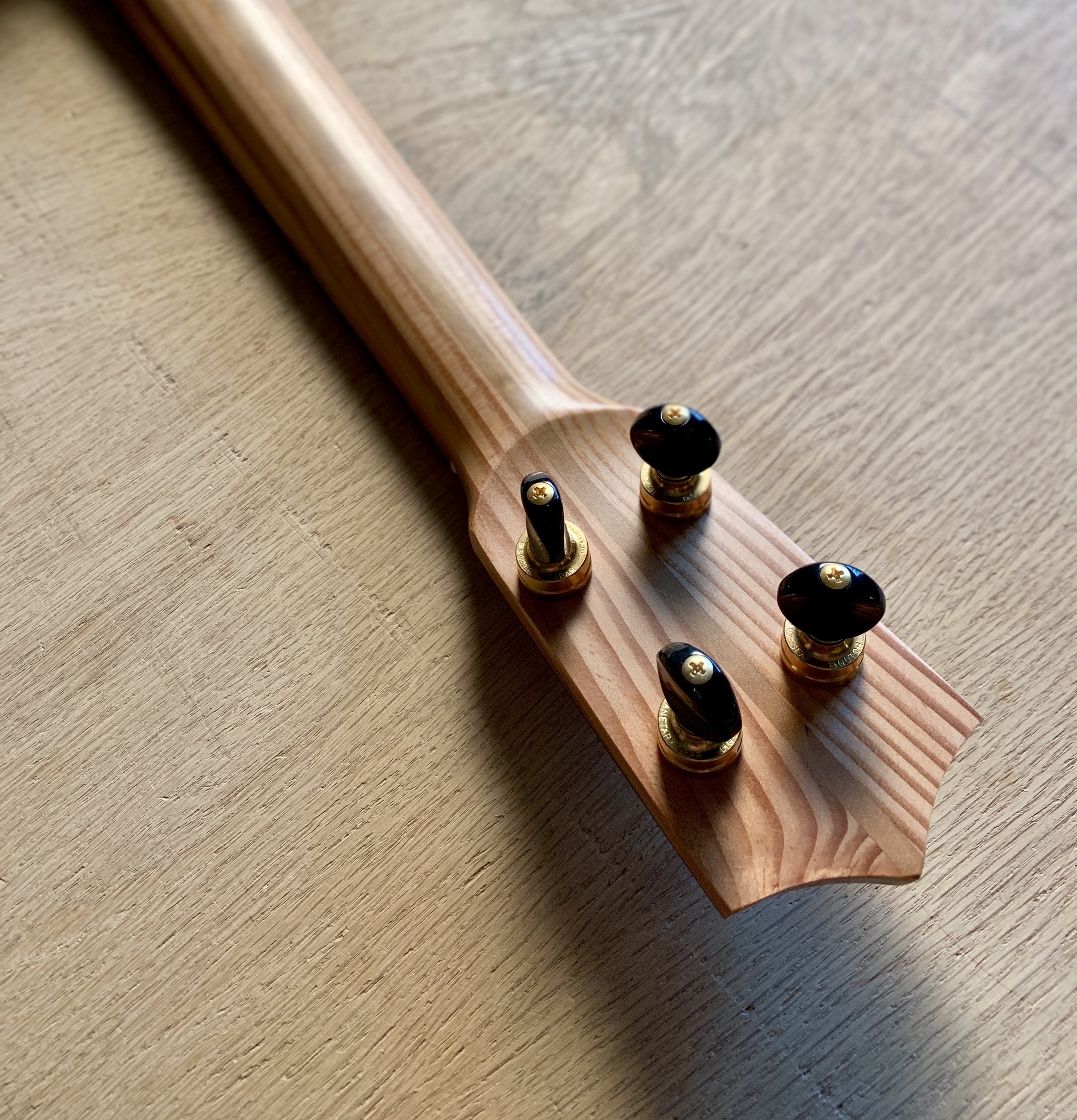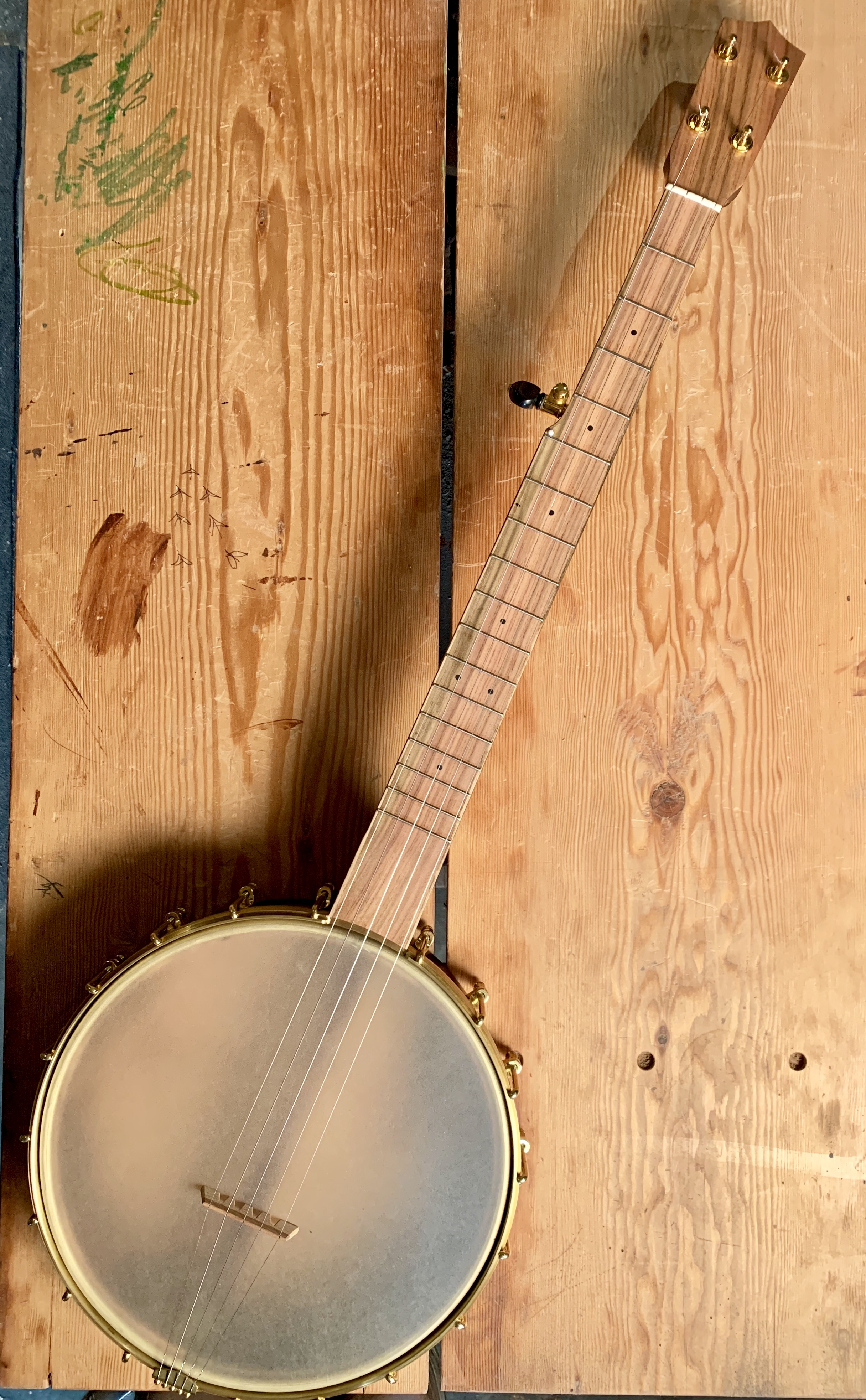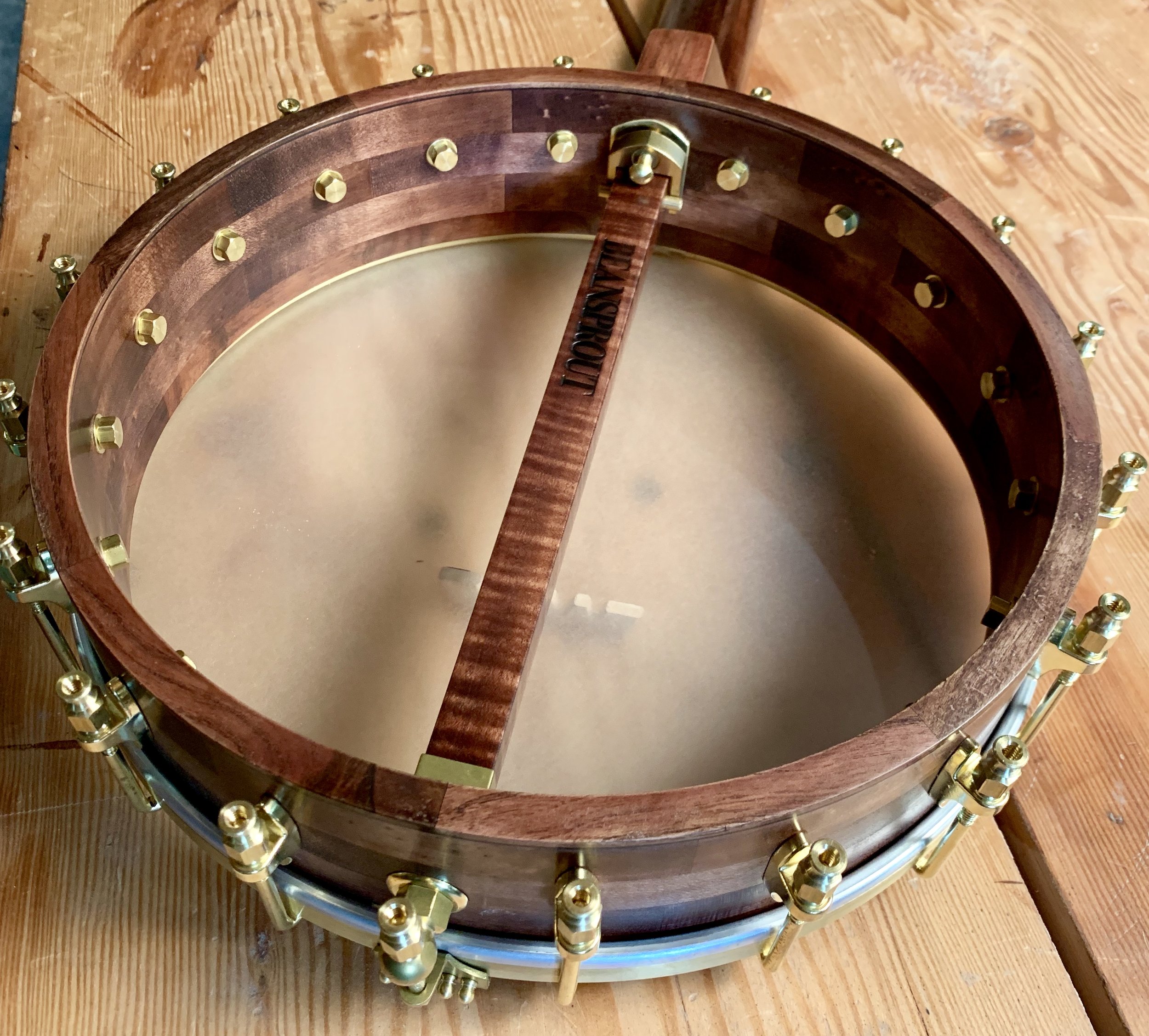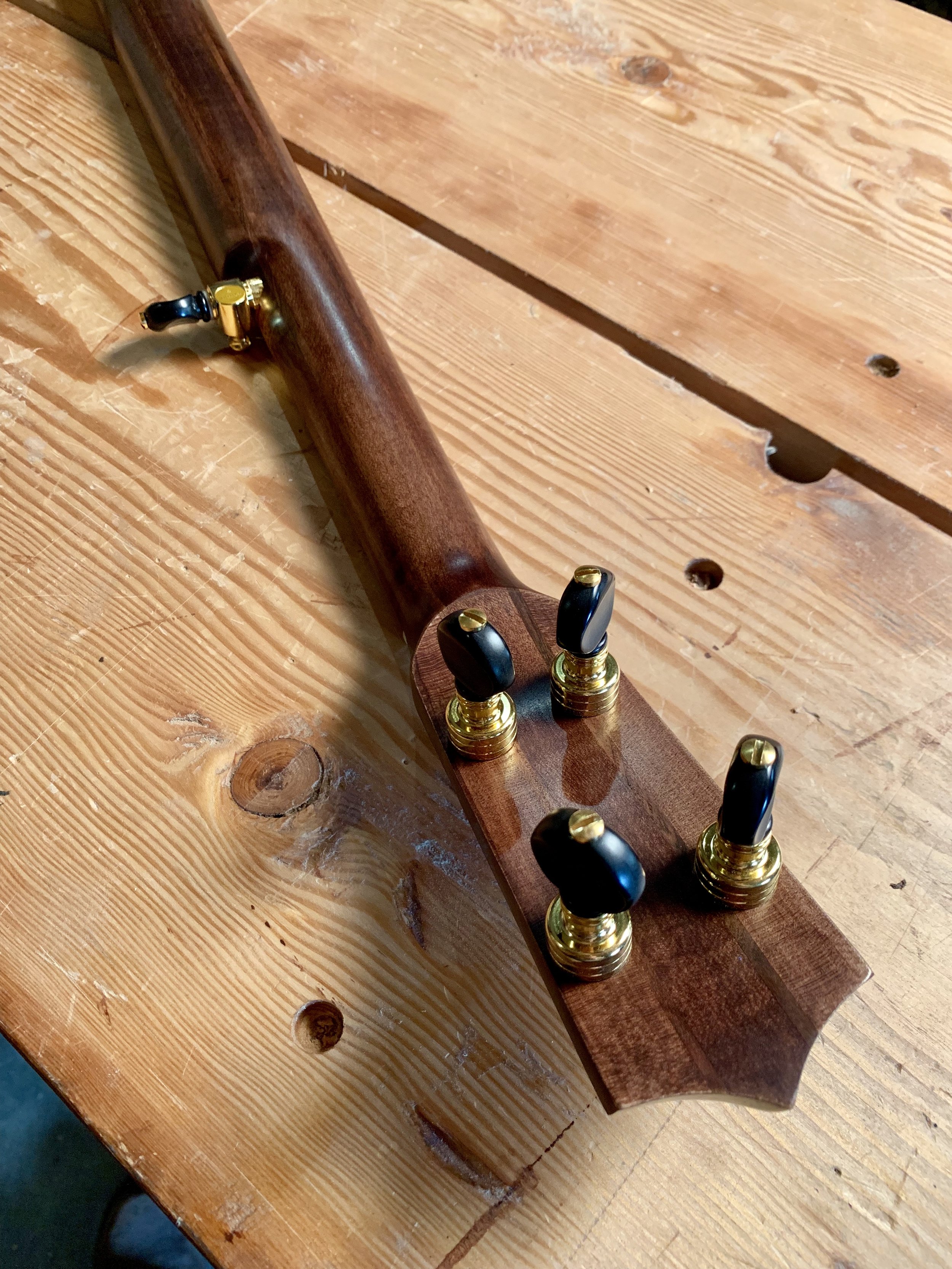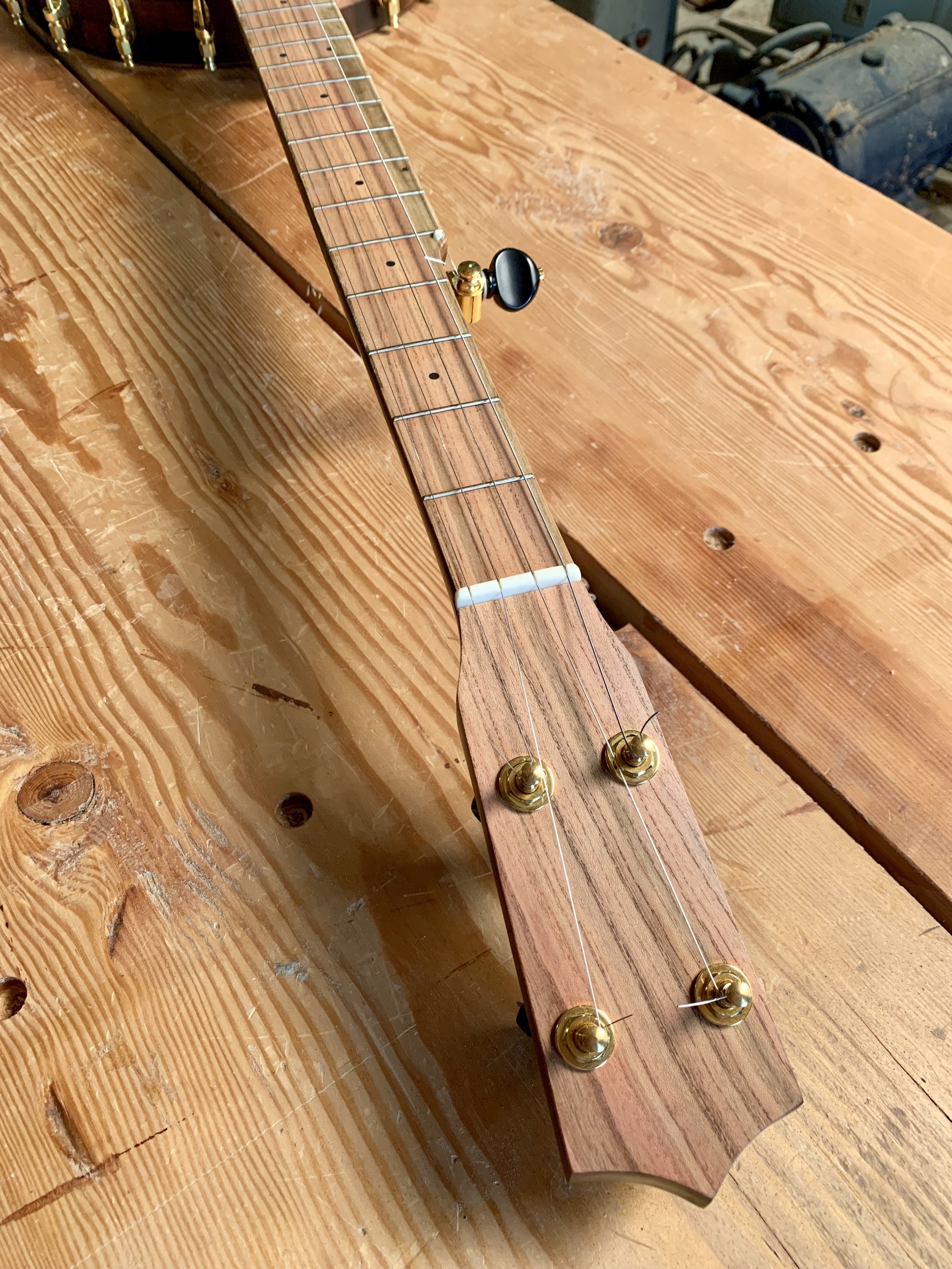It has been fun to make so many alto ukuleles lately, they all seem to have their own personality while being so similar. This curly Myrtle set includes some crazy bug holes and knots that I love. The fretboard is also interesting, so I paired a rather plain neck, binding and Port Orford Cedar top to balance it out. I find it beautiful but not too busy. It has a sweet, breathy voice with plenty of volume. The Port Orford Cedar and Myrtle is from the Oregon coast and the pistachio is from California orchards, all from woodfromthewest.com. The salvaged old growth fir neck is from Portland Salvage Works.
#384- Spruce and Maple Alto Ukulele
The main focus for this build was to get Karen more tone and volume so she could compete with her band mates. Despite the alto’s smaller size, I find that it could be perceived to be as loud as a tenor, but with a different voice. The other thing I like about this instrument is the amazing quilted maple back and sides. It’s like the best part is hiding on the back for Karen to show you (or not.) The maple is from the Carpenter Ant stash, the spruce top is straight grain dulcimer spruce, the neck is from Douglas fir floorboards and the pistachio fretboard and trim is from California orchards.
#390- Spruce and Walnut Tenor Ukulele
Shane has some good ideas. The first was bringing me a pile of salvaged fir and a sampling of beer from his brewery when he came to visit the shop. The fir was from the barn at Level Beer and I got a few more necks out of it than this one. I kept a couple of small nail holes in the neck as witness to its origins. The top is straight grain spruce from my dulcimer stash and the walnut is curly Oregon walnut from Goby. The dramatic pistachio fretboard is from California orchards. Shane’s next good idea was to let me decide how to decorate his wood choices. Because of how busy everything else was, I decided on a rope rosette and no binding. Yes, I am excited about the materials but I also love the sound. Loud but balanced, like his beer. (Not too hoppy!)
#385- Myrtle, Fir and Pistachio Scout Ukulele
This is the second Scout model ukulele I have built, a soprano scale uke with a 7.5” round body. It is an homage to Lyon and Healy/Washburn’s camp ukulele from the 1920’s. The dark Myrtle is a cutoff I saved from when I worked at Mya-Moe, it was the same board as my two main instruments during that time. The neck is old growth Douglas Fir and the fretboard is pistachio from California orchards. It features a beautiful burl in the first few frets that I have been saving for a special project.
Friends Stephanie and Louise decided upon joint ukulele custody of this little gem!!
#392-Walnut and Pistachio Mini Five String Banjo
This one was fun! The natural skin head, the low tuning, the dark walnut, it all combined to make a rich and detailed sound. If I play hard, it barks and growls. If I play soft it sweetly sings. It has a rustic folk sound that makes me want to keep playing and discover what songs are stuck in it! The walnut cane from Vashon Island, brought there from back east by my friend. The amazing pistachio fretboard and trim are from California orchards.
“Hi guys it’s here safe and sound and looking mighty fine after the long trip. Can’t wait to really get my hands on it! Thank you so much for the fabulous end product and superior service all through.
You do what you do well 😊
Very Best Wishes,
- M.D. ”
#387- Oak and Pistachio Concert Banjo Ukulele
I made this instrument for myself as I recently sold my walnut banjo uke. For this one, I grabbed some Oregon white oak from the Carpenter Ant stash and some grafted pistachio from woodfromthewest.com. I feel that oak has a tone between walnut and maple. It also works easy, is plentiful and takes finish well. The video below compares this uke to a walnut one.
#389- Walnut and Pistachio Concert Banjo Ukulele
Tony sent me a box of walnut cut by his family in Missouri a long time ago. I was taken by the texture of the original sawmill marks and I chose to leave them on the rim cap. We are so used to sleek modern designs (the iPhone, the Prius, chrome and glass furniture, injection molded plastic kitchen implements, etc) that a rough or variable texture can be a bit of a surprise! Also, this old black walnut is some of the cleanest and straightest I’ve ever used. It looks beautiful and rings like a bell! The pistachio is from California orchards. The video below pairs this banjo with the next one as a sound sample.
#383- Spruce and Walnut Alto Ukulele
It is interesting to build for a long term customer. I am not just building an ukulele, I’m building one that fits into their long term needs and growth as a musician. I know what they will be comparing the new one against and I have an idea of how this one will fit in their “stable.” This spruce and walnut alto is all wrapped up in rope binding, making for an old timey look. I am pleased with its projection and sustain. I can’t wait to see what Rob uses it for. The spruce was salvaged from a dulcimer maker, the walnut is from Goby and the pistachio from California Orchards.
#386- Walnut and Pistachio Concert Banjo Ukulele
One of my greatest joys and challenges is to make a standard model over and over again, slowly and subtly refining it over time. I also like leaving some of the details of a standard model up to chance, improvisation and the natural grain of the wood. This one, for instance, got narrow curly maple strips as part of the five piece neck, something I’ve never done before. It looks great and does the job but also allows me to stretch my creativity within the narrow boundary of the set design. Anyway, this one sounds great of course. Walnut from the Carpenter Ant Stash in Portland and pistachio from California orchards.
#382- Myrtle Tenor ukulele
I love Myrtle! It’s local, beautiful and sounds great. This set comes from the carpenter ant stash in Portland. It was a bit of a surprise that we found some Myrtle there. It luckily ended up looking really unique, with irregular flame and curl. It also has some lovely knots and dark streaks. Adam was wise to leave the binding and rosette off, it doesn’t need it. The neck is salvaged hemlock from Portland Salvage Works and the pistachio fretboard is from woodfromthewest.com.
#381- Spruce and Cherry Alto Ukulele
First off, see the below post about music/craft/community, as it also applies to this uke!
For this alto, Jeri came to the shop and picked out some nice pieces of wood. The top is Oregon spruce from Camp Westwind, the gnarly cherry back and sides are from the Carpenter Ant stash, the mahogany neck is salvaged from a furniture maker and the pistachio comes from California orchards. Compared to the more earth tone look and breathy sound of Jann’s uke below, this one has a crisper look and sound that I also like. It is pretty hard to hear the difference on the video but it’s something I can feel when I play, although it’s pretty subtle.
#377- Port Orford Cedar and Myrtle Alto Ukulele
Today I really feel inspired by the community we are connected to with our music and our craft. This instrument is built for our friend/student Jann, using wood from our friend/student Lizann’s father’s wood stash. Lizann and Jann play music together and will soon be playing instruments made by the same maker from wood collected by the same man. Next weekend, I am going to Portland to teach them an arrangement I wrote of an old jug band waltz and we will all make music together. I don’t know if the art/music/craft makes the community or the other way around, but I like it. (all this applies to Jeri’s uke in the next post as well, btw)
The myrtle is from a funky board from the Carpenter Ant stash and seems to have a gnome hiding in the back. The top is some striped Port Orford Cedar which came from the Oregon coast courtesy of woodfromthewest.com. The fretboard, headplate, bridge and bindings are pistachio from California orchards. The neck are fir floorboards with cherry lamination stripes. This instrument is a good example of the muted earth tones that are a hallmark of the wabi-sabi aesthetic. From far away, they blend together, up close you notice subtle differences.
#366- Myrtle Scout Uke
Inspired by the Lyon and Healy “camp uke” from the 1920’s-30’s, the Scout is a handmade ukulele with a simple design, sweet tone, easy playability and maximum portability. This one has an Oregon Myrtle body, old growth Douglas fir neck and pistachio everything else.
#371- Spruce and Oak Tenor Ukulele
Quarter-sawn white oak such as this is common in the furniture trade and was also used in parlor guitars, mandolins and banjos at the turn of the 20th century. To my ears, it has the volume of maple but a dustier sound, more old timey in a way. I paired it with a spruce top, pistachio fretboard, headplate and binding from California orchards and a fir floorboard neck. This oak is from the Carpenter ant stash in Portland and I have more like it. Drop me a line if you would like it in a uke or a banjo.
#376- Fir and Curly Mahogany Alto Ukulele
I really was going for a classic look on this uke, reminiscent of mainland designs of the 1920’s. The curly mahogany on the back and sides looks like some of my favorite higher grade Harmony ukes and the rope binding ties it to West coast builders like Knutsen and Weissenborn. The old growth Douglas fir top and pistachio head plate and fretboard are my updates, of course. The fir is salvaged from floorboards, the pistachio is from California orchards and the mahogany came from Char at Mya-Moe before she retired.
“
I just wanted to tell you how much I love my alto Beansprout. It is the perfect size for me. It was such a good decision to go ahead and buy it at the festival. Everyone who sees it admires it. My alto has incredible tone and great action. It is hard to believe that an instrument that small has such great tone!
I hope this all of you doing well and happy.
With kindest regards and great appreciation,
- C. W. ”
#378- Walnut and Pistachio Mini Five String Banjo
When I first imagined this little banjo design, I though it would be most useful in a higher tuning, like a piccolo banjo. But, it seems to have found its niche in standard g tuning. It makes for a small and pleasant version of a normal banjo. Easy to travel with, fits on a lap easily, easy on your back and hands. The walnut neck on this one is lightly curly stuff from Goby in Portland. The rim is mosaic of scrap pieces from the cutoffs from earlier banjos. It makes for a truly unique rim with lots of asymmetrical layers and a striking visual appeal. The pistachio is from woodfromthewest.com.
“Just to let you know, #378 arrived yesterday, and it is a thing of real beauty! I really appreciate the craftsmanship, the attention to detail, the selection of beautiful woods, and most especially, the extremely satisfying sound of it. I am absolutely thrilled with it. Keep up the great work, both of you!
- M. M. ”
#380- Maple and Pistachio Tenor Banjo Ukulele
Dana asked for a tenor scale banjo uke tuned cgda, like a Tenor Banjo. We tested some different string gauges and were surprised by the good sound. I find this setup, especially when played with a pick, to be a lot of fun. The tone is rich and dark but with the sparkle and punch Maple is known for. I can’t wait to see what Dana uses it for. The maple is hard, straight grain stuff from Henry’s dance floor stash and the pistachio is from California orchards.
#373- Port Orford Cedar and Walnut Baritone Ukulele
Have you ever had the experience where you hear a new word and suddenly it is everywhere? With this ukulele, it happened with the cool knot in the fretboard that looks like the eye of Horus. It then showed up in the neck and in the knots in the back. A nice bit of synchronicity that happened during wood selection. The top is Port Orford Cedar from the Oregon coast, walnut is urban salvage from Goby in Portland, the fir neck was a floor joist in Portland and the pistachio is from California orchards.
#378 Maple and Pistachio Five String Banjo
This instrument shows me experimenting a bit, admittedly within the narrow guidelines I give myself to stay on brand. It is my normal five string banjo, but with two main changes. 1st, I stained the maple a nice reddish brown. 2nd, I added a small rolled brass ring to the top of the rim. Overall, I am quite pleased. I played it for a rehearsal today and liked the tone and feel of it. You can hear this banjo in the video below, compared to another with a different setup.
“Hi Aaron,
It’s here and I LOVE it. I’m new to the banjo world but it’s a million times better than what I’ve been learning on - louder, more complex, greater depth of tone and SO much more playable. Thanks for making such a beautiful instrument. I feel very privileged to be learning on something so special. I can’t put it down!!!!
- M.S.”
#374- Port Orford Cedar and Walnut Baritone Ukulele
I recently sold my ukulele to my friend Danielle. I needed another one for this month’s gigs so I got right to it. I was inspired by the simple sap wood streak in the back and sides to keep everything else simple too. Tight grain spruce top, no front dots on the two tone pistachio fretboard, no rosette or sound hole binding. I used multi colored pistachio binding to mimic the streak on the back. The neck is a fir floor joist from the Level beer property in Portland. The walnut is from Goby and the Port Orford Cedar and pistachio are from woodfromthewest.com.


